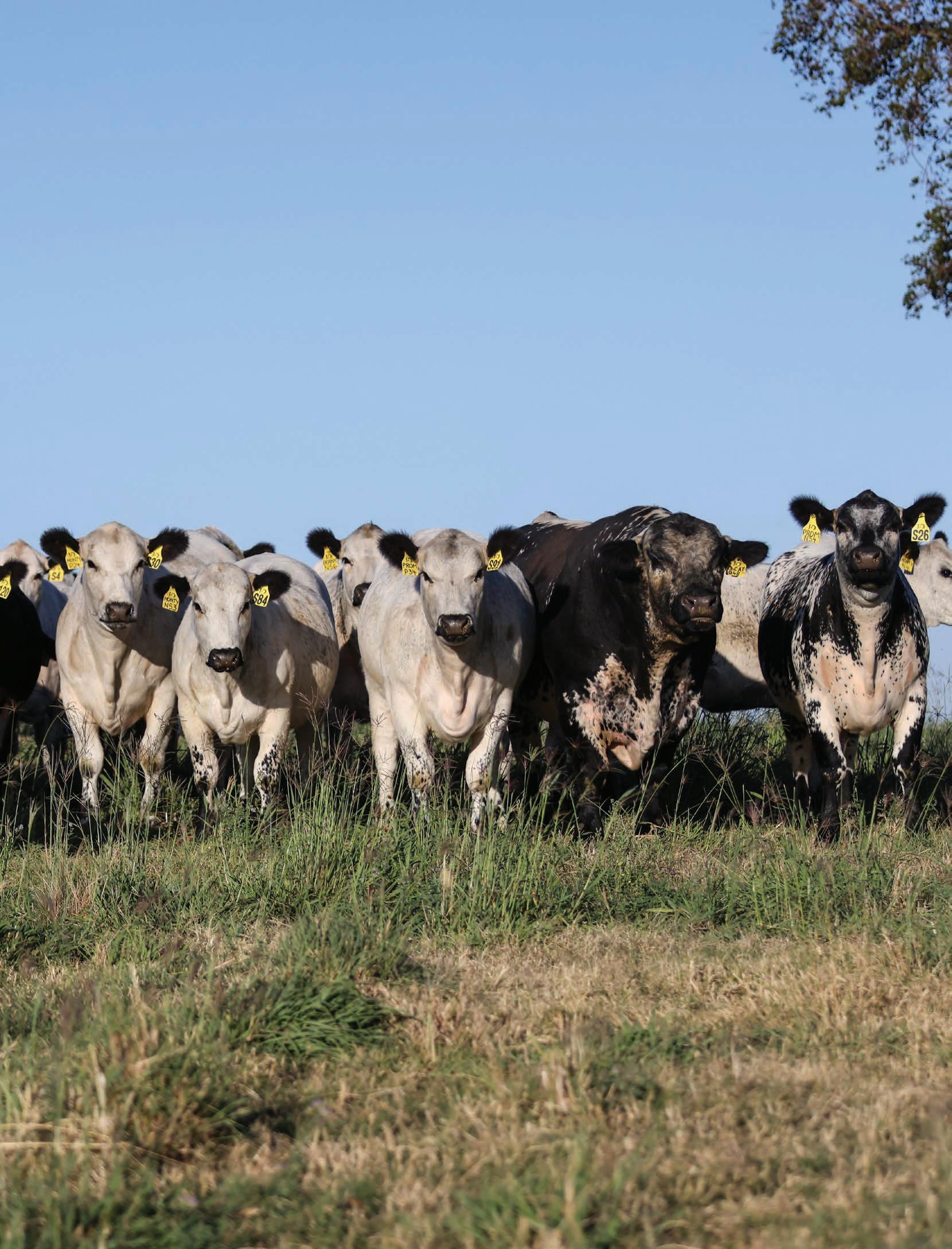

BUYERS’ INFORMATION
Page 3
Pages 4-7
Page 8
Pages 9-10
Pages 11-12
Page 13
SPECKLE PARK
Page 16
Page 17
Pages 18-32
Welcome
Sale Information
The JAD Advantage
Info on Structural Assessments + Dick’s Pick
Breaking Down BREEDPLAN
Sale Venue, Location Map + Accommodation
Speckle Park BREEDPLAN Percentiles Table
Speckle Park Reference Sires
Sale Lots: Registered Speckle Park Bulls
Pages 33-38 Sale Lots: Commercial Speckle Park Bulls ANGUS
Pages 40-42
Page 43
Page 44
Pages 45-57
Breaking down TACE
Angus Australia TACE Percentiles Table
Angus Reference Sires
Sale Lots: HBR-Registered Angus Bulls
THE SALE
DISCLAIMER: The descriptions of the animals in this catalogue, including their pedigree and other genetic information, has not been verified by the Vendors or the Selling Agents. Whilst all care is applied in producing this catalogue, industry experience suggests that up to 4-5% of DNA parent verification tests may have errors. Consequently, the Vendors and the Selling Agents and their representative(s) do not assume any responsibility whatsoever for the correctness, use or interpretation of the information on animals included in this sale catalogue. Prospective purchasers should satisfy themselves by inspection or otherwise as to the accuracy of the particulars.
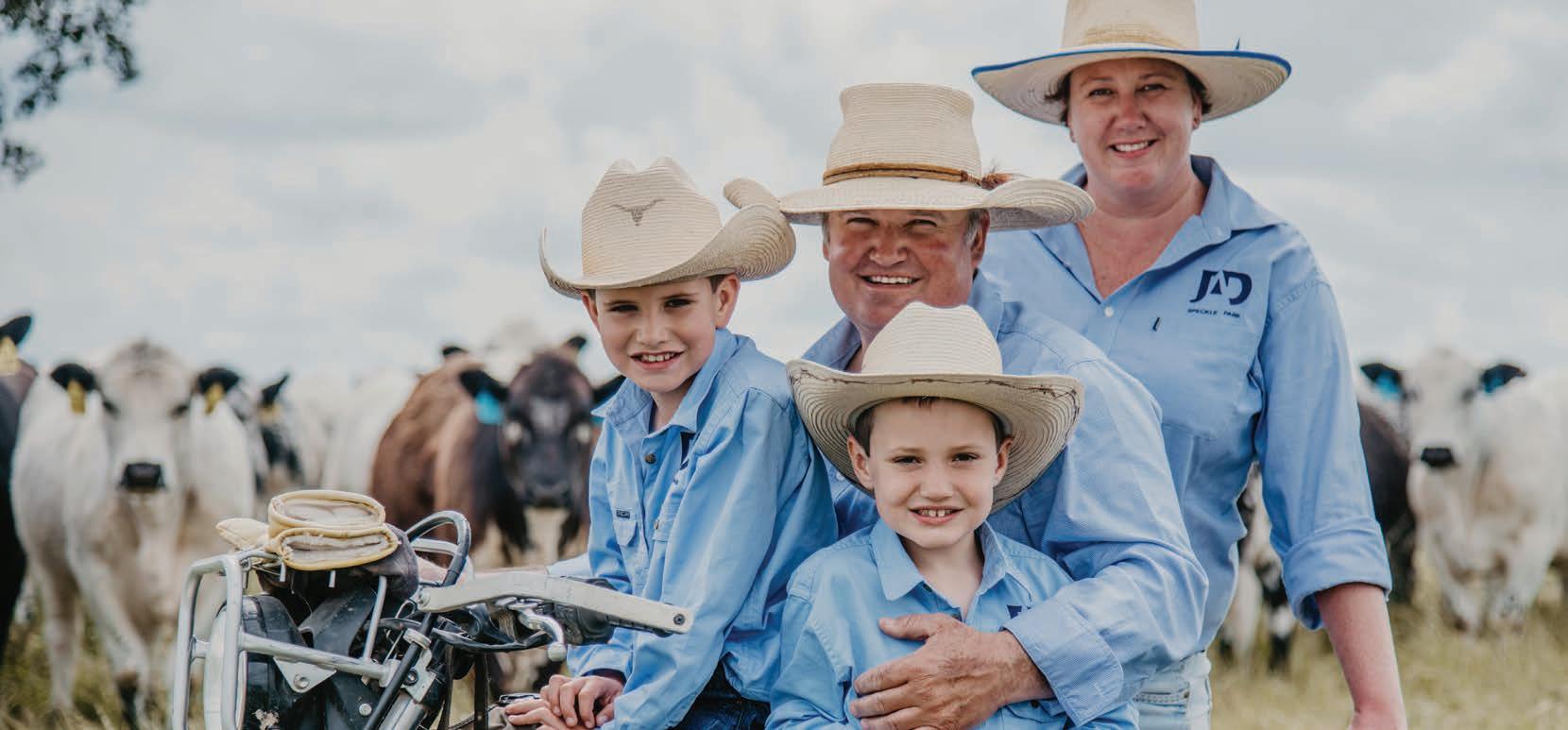
INAUGURAL
JAD SPECKLE PARK + ANGUS
QLD BULL SALE
BRED FOR LASTING PERFORMANCE
Our family welcomes you to the Inaugural JAD Speckle Park & Angus QLD Bull Sale. Thank you very much for showing an interest in our program – we are grateful for your support, and look forward to getting to know you and your breeding program.
After years of planning, we are so excited and proud to have brought our JAD program to Queensland, for this inaugural sale, representing both our Speckle Park and Angus stud programs. We first started breeding Speckle Park commercially in 2012 and were so impressed by how the breed performed that we decided to start our stud in 2016. We then decided to benchmark this emerging breed against the most popular breed in southern Australia - Angus - by establishing our Angus stud in 2020. This catalogue of JAD Angus bulls is our first to be offered at auction.
Our breeding objectives at JAD remain the same across both Speckle Park and Angus. First and foremost, we need to breed bulls that not only perform but also last the test of time. Structural integrity and docility in our herds should always be of utmost importance.
We trust you will peruse this catalogue and see the consistency of type we are developing here at JAD. Our use of a select few fully performance-recorded sires is really starting to pay dividends. These animals have multiple generations of performance recording behind them, meaning our bulls offer estimated breeding values (EBVs) with similar accuracies to those found for Angus bulls of the same age from leading studs in that breed.
As we ponder where JAD and the Speckle Park breed will be in another five years from now, we are confident that our breeding decisions so far have put us in good stead to prepare our stud for the future. Our stud is
hugely diverse in genetics, giving us a solid foundation from which to breed new sires and use them within. We have embraced independent assessment of our animals, inching forward each year as measured not just by the percentage of animals that ‘make the grade’, but more importantly the percentage that sit right at the top of the tree.
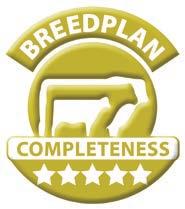
JAD Speckle Park is one of very few studs that carry a five-star Breedplan Completeness of Performance rating. We apply this same standard in our Angus stud. Although we put a lot of emphasis on Breedplan and data, our core fundamental benchmarks are with the utmost importance placed on temperament, feet and legs, scrotal, and udder quality. We are about breeding for longevity - encompassing fertility - to ensure commercial relevance for us and our clients.
We would like to thank our families, friends, and service providers for their immeasurable support - especially Justin’s parents, Tony and Kate. We would also like to thank our team member, Stewart McKenzie, for his valued contribution to the JAD business.
With thanks,
Justin, Amy, Jack and Mitchell Dickens.
SALE INFORMATION
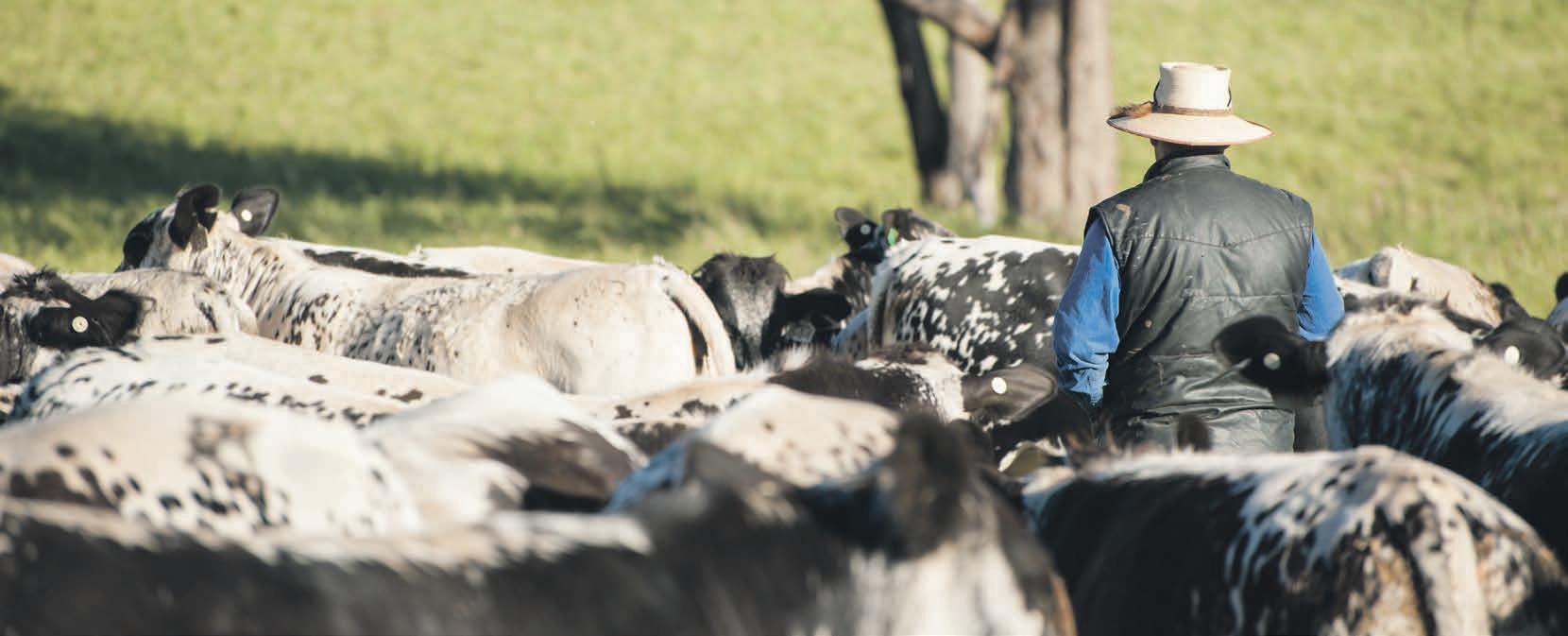
Program:
▶ Inspections: From 10am
▶ Sale: 1pm
▶ Complimentary morning tea, lunch and post-sale refreshments will be available.
Selling Agent:
The sale will be conducted as a live auction by Nutrien Ag Solutions. All animals will be available for pre-sale inspection on the day of the sale, and will be sold through a sale ring.

Mark Scown: (0438) 878 718
Trent Mckinlay: (0429) 004 737
Sam Moy: (0429) 783 067
Dane Pearce: (0439) 917 428
All lots will be sold under the Australian Livestock & Property Agents Association Ltd Standard Stud Stock Auction Terms and Conditions of Sale. If unfamiliar with these terms, please contact Nutrien Ag Solutions. Please check with the Selling Agents to obtain a buyer’s number and registration slip, if you are considering bidding in the sale. Successful purchasers are requested to give written advice to the Selling Agents, regarding transport arrangements, at the sale’s conclusion.
Outside Agents:
A rebate of 2% is offered to outside agents who introduce buyers to the selling agent in writing at least 24 hours prior to the sale, and settle accounts on the purchaser’s behalf within 7 days of the sale. A 5% rebate is offered to outside agents who complete the above AND attend the sale in person with their client(s).
Client Rebates:
A rebate of 5% is offered to clients who have purchased at a previous JAD Sale, who introduce buyers to the selling agent in writing at least 24 hours prior to the sale, and settle accounts on the purchaser’s behalf within 7 days of the sale.
Supplementary Information:
A Supplementary Handbook will be available on sale day,
including current scan data, weights, further DNA testing results for commercial bulls, and notice of any withdrawals.
Insurance:
Purchasers are strongly encouraged to immediately insure their new acquisition(s). Stud cattle are a valuable and vulnerable piece of farm equipment.
Unable to Attend the Sale?
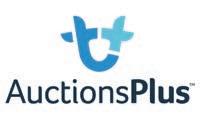
Bid online via AuctionsPlus.
The sale will be interfaced as a sequential auction on AuctionsPlus, with live video and audio streamed for online bidders and viewers. There will also be individual videos of each live lot posted to the AuctionsPlus catalogue in the weeks leading up to the sale. Please also register as an AuctionsPlus user at least 24 hours prior to the sale in order to bid. Note that transport arrangements must be organised on sale day.
Phone Bidding: If you would prefer to place your bids over the phone, please contact one of the Nutrien Ag Solutions agents at least 24 hours prior to the sale to make arrangements.
GST:
All animals are sold exclusive of Goods and Services Tax (GST). Ie: If a bull is sold for $5000, you will be charged $5500.
Mobile Reception:
Mobile phone reception will be stabilised at the sale venue through external boosters. For phone bidding, please contact a Nutrien Ag Solutions agent.
Feeding and Management:
Our 2022-drop of cattle were weaned at approximately 5-7 months old. They received weaner pellets as part of the weaning process and were grown out on pasture, and only supplemented when pasture quality was waning. We aim to have our bulls grow out at between 1-1.3kg/day their entire lives. The cattle are now in peak health, with rumens in great balance to handle whatever pasture conditions they encounter at their new home. The cattle have been handled with dogs, UTVs, motorcycles, and on foot. None of the cattle have ever had their feet trimmed in any way. We will NEVER hoof trim our cattle to mask faults. Never ever.
SALE INFORMATION
Herd Health:
Some animals in the catalogue have minor pinkeye scarring, not deemed detrimental to their functionality. We strongly recommend annual animal health booster shots.
ALL BULLS:
▶ DNA tested to verify they are not persistently infected (PI test) with Pestivirus
▶ Vaccinated with chilled Trivalent (3 germ) tick fever vaccine on 14/9/2023
▶ Vaccinated for three-day sickness with Ultravac BEF vaccine on 2/7/2024
▶ Pestigard booster given 2/7/2024
▶ 7-in-1 booster given 2/7/2024
▶ Double vaccinated with Vibrovax (booster given 2/7/2024)
▶ Backlined with Stampede on 2/7/2024
▶ Cydectin Platinum drench applied on 29/5/2024.
Under the Johnes Beef Assurance Score (J-BAS) system, JAD Speckle Park carries a J-BAS 6.
The JAD Guarantee:
Every bull is guaranteed to be a breeder at the time of sale and is guaranteed fertile for 12 months from sale day. If a bull should prove infertile or unable to serve cows naturally, the vendor will either:
1) Provide a satisfactory replacement, or
2) Provide a cash refund equal to the purchase value of the bull less salvage value. No credits provided. It is the purchaser’s responsibility to provide a certificate from a registered veterinarian before the 12 months is up to verify infertility, and that it was not the result of an illness, injury, or misadventure. The guarantee covers the purchase value of the bull, without interest, costs and damages. We recommend that all purchasers discuss injury insurance of their purchases at the sale with the on-site representatives or their agent. This guarantee is in addition to the normal terms and conditions governing auction sales.
Livestock Freight:
Formal possession, risk and expenses pass to the buyer at the fall of the hammer. JAD Speckle Park & Angus and/or agent, Nutrien Ag Solutions, can assist with arranging transport. Macdeb Livestock Transport will be present at the sale and can deliver bulls in the days after the sale, at the purchaser’s expense. Please liaise directly with Mac Jones to book.
▶ Macdeb Livestock Transport. Contact Mac Jones at (0408) 572 507.
Semen Rights:
JAD Speckle Park & Angus reserves the right to collect up to 200 straws of semen from any bull in the sale, for within herd use only. Any semen collection will be at our cost and the purchaser’s convenience.
Breedplan/TACE:
We are proud of our committment to the collection and reporting of performance data for BREEDPLAN/TACE. By submitting raw data to the system, we are ultimately improving the accuracy of resultant EBVs to deliver real value to our clients to assist in their decision-making. JAD Speckle Park has a five-star Breedplan Completeness of Performance rating. Speckle Park Single-Step BREEDPLAN EBVs reported in this catalogue come from the June 2024 run, while Angus EBVs and published from the Mid June 2024 TACE run. See further information about BREEDPLAN EBVs and a Percentiles Table on pages 11, 12 and 16. See further information about TACE and a Percentiles Table on pages 40-43.
Veterinarian’s Physical Examination of Bulls/Females:
Bulls:
All bulls offered have passed a crushside and morphology semen evaluation, carried out by Dr Hennie Strydom of Wellington Veterinary Hospital. This assessment certifies the bulls are fit for natural service, however does not guarantee their semen will freeze for artificial breeding. Additionally, no bulls have been health tested for export qualification purposes. All bulls are sold without guarantee that they will meet all health testing requirements for semen export.
Raw Data:
Fat and muscle scanning, and scrotal circumferences were measured on November 16-17, 2023, by Roger Evans, Bovine Scanning Services Pty Ltd, Tamworth, when the animals were 13-16 months old. This data was submitted to Breedplan/TACE for purebred bulls, to increase the accuracy of their EBVs.
DNA Testing:
All bulls have been fully DNA tested at Neogen Australasia.
100K SNP Profile for every bull and purebred female

Parent Verification (PV) for every bull and purebred female in the sale
Coat Colour
Poll/Horn Testing
RGF – homozygous dominant black
RGC – dominant black/recessive red
RGW – wildtype red gene carrier
PcPc – homozygous polled
HPc – carries one copy of the horn gene
Myostatin NC – non-carrier of the nt821 myostatin gene
C – carrier of one copy of the nt821 myostatin gene
“We have been using the Q-select testing for 10 years and have seen vast improvements in our weight gains, not only in calves still on their mothers but even more so as they start to develop on feed. The four parts to the Q-select test all have their benefits. By focussing on using Leptin TT sires, we have lifted our weaning weights over the past seven years and we are seeing an increase on the number of TT progeny each year. It’s definitely a worthwhile tool to assist in herd improvement.”
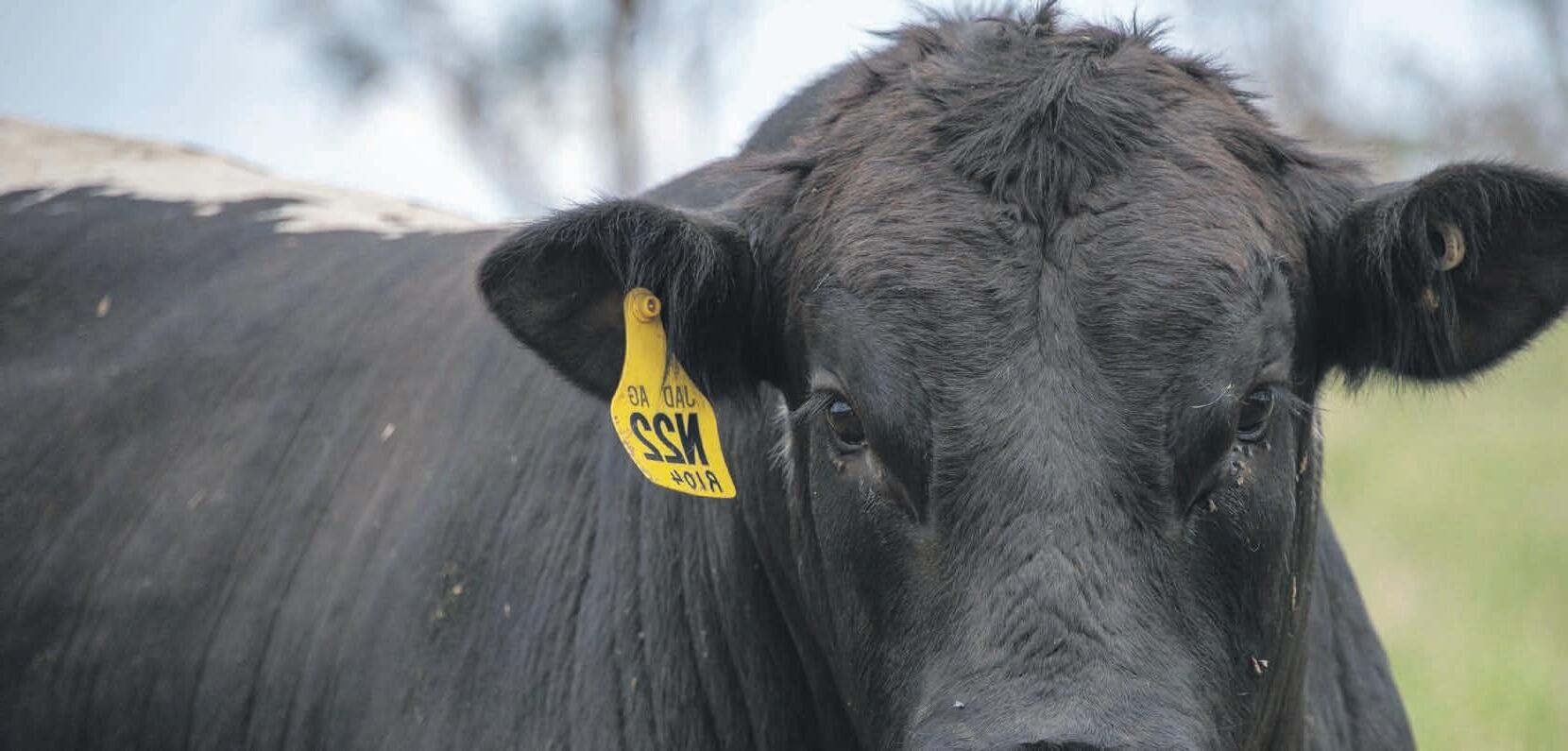
Leptin Represented as TT, CT or CC. Read the following page for more information about Leptin.
Leptin Testing:
JAD Speckle Park was the first Australasian Speckle Park stud to undertake DNA testing specifically for economicallyimportant beef production traits, including leptin. All purebred lots have their Leptin test results published.
Leptin TT is the preferred genotype - TT cattle will show improved carcase traits over CC cattle, with CT cattle being somewhere in the middle. Cattle inherit one copy of the gene from their dam, and one copy from their sire. This means that if you have a TT bull, the calves can only be either CT or TT, as he only passes down one T allele. Leptin is a mammalian hormone with the primary function of decreasing appetiteit is known as the ‘appetite gene’. Leptin TTs have an overall increased rate of fat accumulation compared to leptin CC. For Leptin TTs, this mainly results in:
▶ Increased weaning weight
▶ Increased cow productive life due to increased body condition
▶ Increased milk production
▶ Increased 12th rib backfat
▶ Impacts yield grade and marbling.
Registration Transfers with Breed Societies
JAD Speckle Park & Angus will take care of and pay for ownership transfers of registered lots on behalf of the purchaser. If you would like your new bull(s) transferred in the database, please email us at jad@jadspecklepark.com.au
Visitor Safety:
All of the sale animals have been screened for temperament and are quiet to handle under normal circumstances. However, there are inherent risks with cattle handling. VISITORS ENTER THE CATTLE PENS AT THEIR OWN RISK.
CHILDREN/PRAMS MUST NOT ENTER THE PENS.
People entering the yards are at risk of injury. Be especially alert to bulls fighting. We do not expect the bulls to be aggressive with humans, but sale day places extraordinary pressure on them as they experience an entirely foreign environment. Do not crowd the bulls or loiter inside the pens.
When You Get Your New Animal(s) Home
On arrival at their new home it is important a suitable mob of animals (eg: pregnant cows, steers) is yarded to greet the new animal(s), to minimise stress on them. The bulls are in good joining condition at point of sale, but it is imperative to ensure good nutrition for the bull during the joining period. You should check the bulls regularly to see they are working, especially in the first three weeks of joining when the majority of problems occur. Watch for any signs of injury, infection (any high temperature can compromise bull semen quality) or possible serving dysfunction. Early detection of any problems can minimise the impact of the quality of service your bull provides, and conception rates.
Thank You, Thank You, Thank You:
Sales like this one don’t just happen - they take a whole team effort, and we are so grateful to those who have assisted us:
▶ First and foremost, thank you to Justin’s parents, Tony and Kate Dickens, for everything they do for us
▶ Our highly valued team member, Stewart McKenzie. Thanks Stew for all your efforts throughout the year
▶ Jeff and Alex York for their tremendous support in helping us to get this sale up and running at the Rolleston Livestock & Grain Selling Complex
▶ Mark Scown, Dane Pearce, and the whole team at Nutrien Ag Solutions. Thank you for all of your efforts!
▶ Our friends, Charles Iffland and Katelyn Watts, who helped with photographing and videoing the sale bulls when Justin was out of action with a broken leg!
▶ Our long-time friend, Paul Keating (Keato), who has helped at every JAD sale, and loves a good Speckle Park steak!
▶ Our good friend, Bill Findlay, who is holding the fort at home with stud calving underway.
Justin Johner, Johner Stock Farm, Canada.
SALE INFORMATION
SPECKLE PARK COLOUR PATTERN GUIDE
It is important to understand how Speckle Park colour patterns work in order to achieve your breeding goals. While some breeders are mostly interested in producing speckled cattle, others want to inject the notorious hybrid vigour of Speckle Park, while retaining predominantly black herds. For example, when a solid black Speckle Park bull is joined with 100% purebred Angus cows, the resulting calves will be solid black. Another example is when Angus cows are joined to a white Speckle Park bull, the resulting calves will be predominately speckled.
Speckle Park cattle have four distinct colour patterns; speckled, leopard, white pointed and solid black. The speckle and leopard colour pattern are genetically the same except for varying degrees of spotting. Some Speckle Park cattle can produce red colour patterns if both parents carry the recessive red gene.
Please remember when dealing with nature individual results will vary. The guide is just that – a guide – and Mother Nature has the final say.
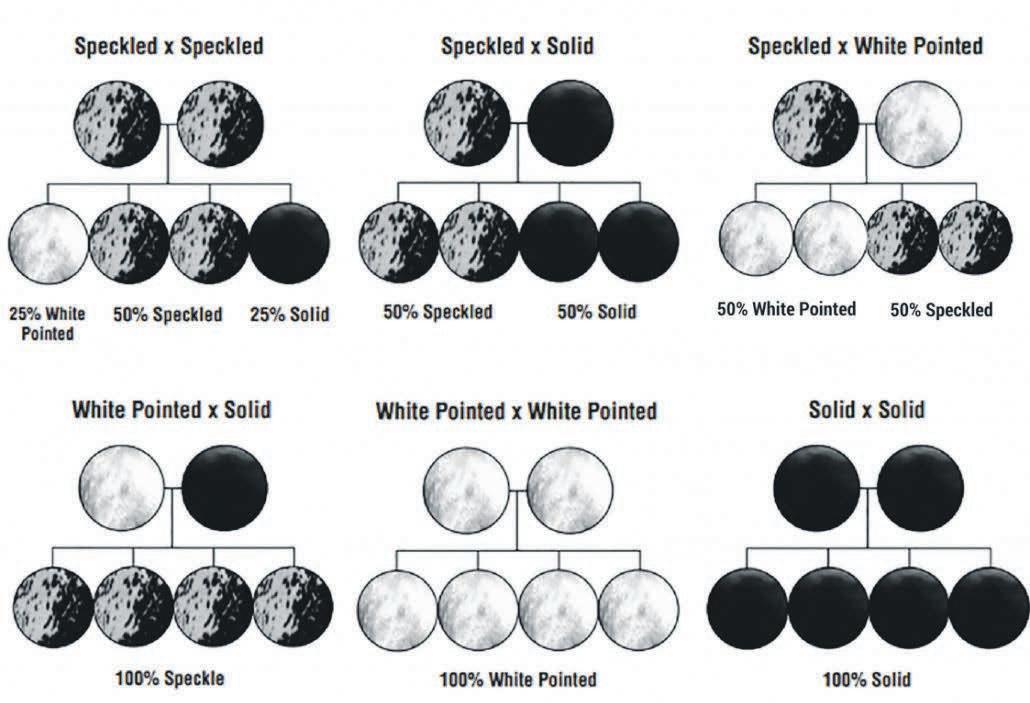
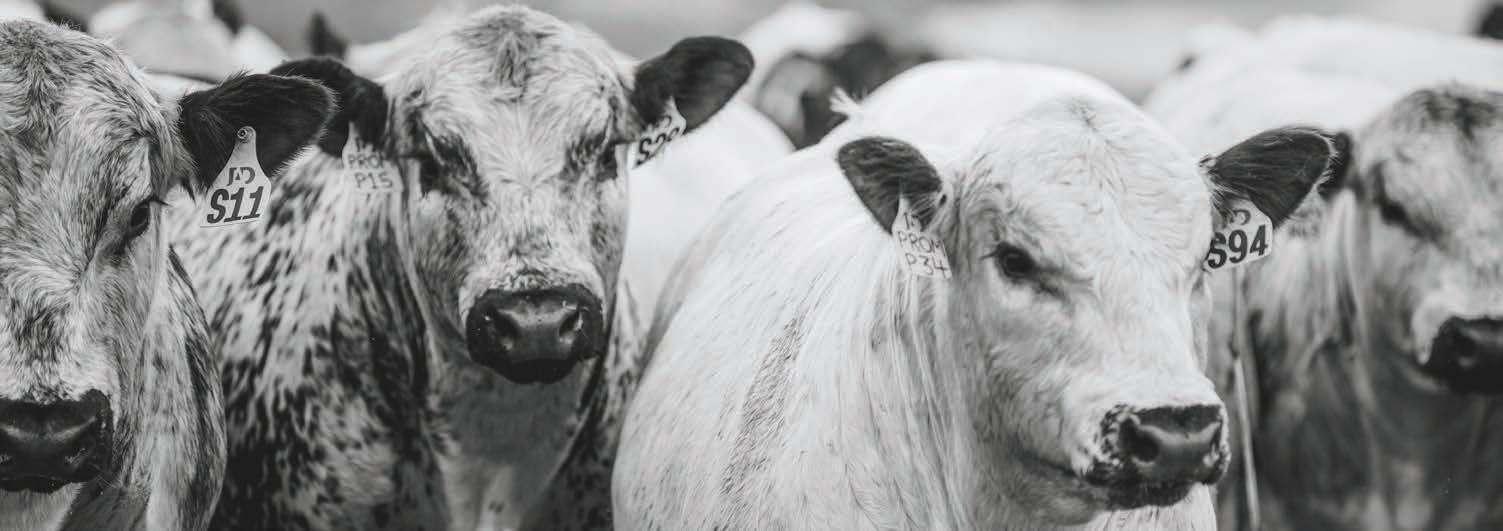
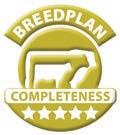
ADVANTAGE THE
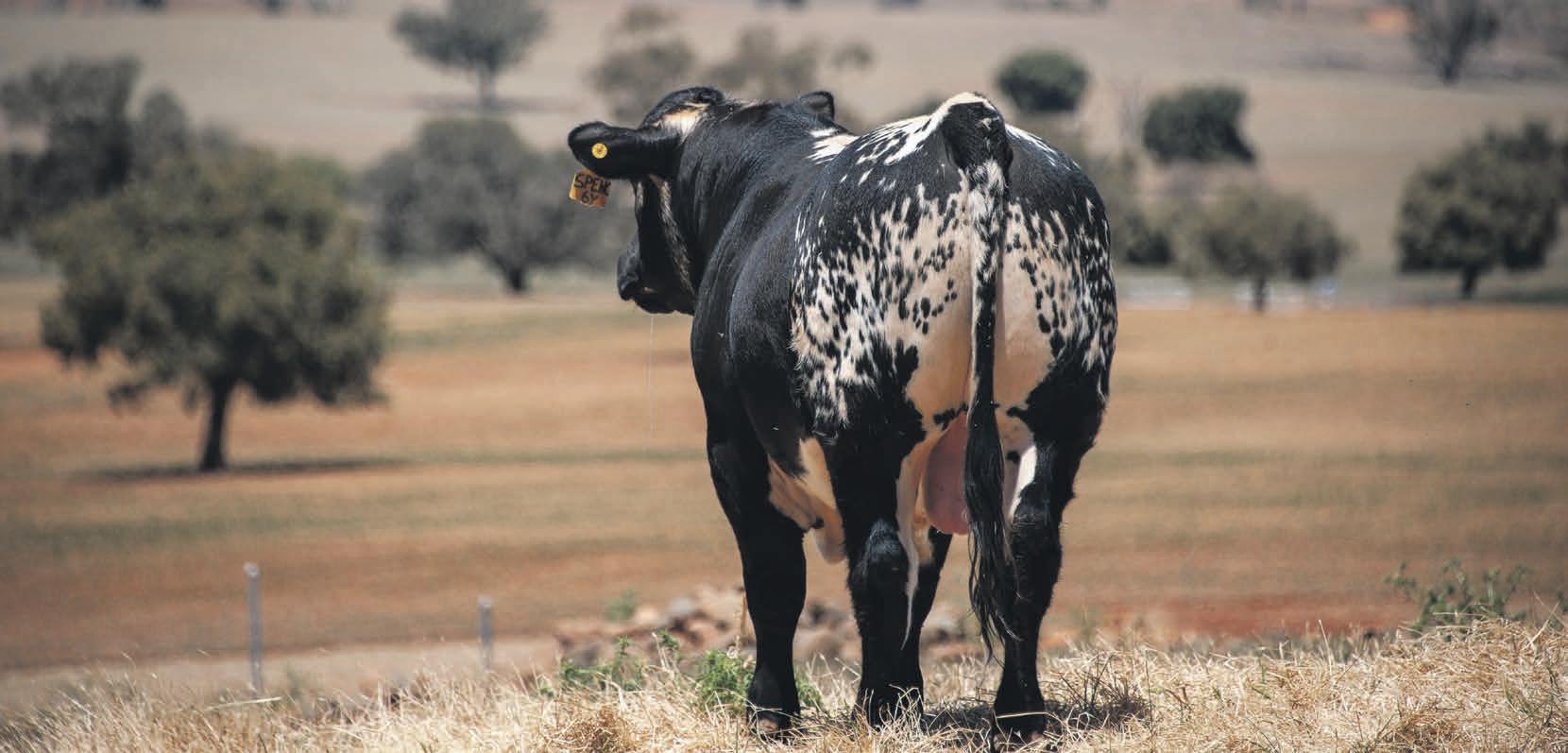
We are a commercial- and customer-focused Speckle Park and Angus breeding operation which aims to deliver seedstock that will improve the long-term efficiency and profitability of the beef industry, and consistently “plate up” a unique and memorable beef eating experience for the end consumer.
We feel strongly that the Speckle Park and Angus breed in Australia will benefit from bulls that have been bred under our strict standards, and they are backed by our 12-month “JAD Guarantee” – we are in this journey together.
When you buy a JAD Speckle Park or Angus, you can be assured that they have been heavily measured and scrutinised. Our Speckle Park stud carries a five-star BREEDPLAN Completeness of Performance rating,
acknowledging the effort we make to measurement and maintaining contemporary group completeness right through to 15-17 months old, in an effort to achieve more accurate EBVs. We aim for a balanced set of objectively measured traits, and work to gradually optimise growth and carcase traits – not in quantum leaps. We put in the hard work to give our clients the confidence to back us and our cattle.
We are passionate about our cattle and hold a strong femalefocussed vision for what we want our herd to look like. Our cattle must be structurally sound, medium-framed, deepbarrelled, thick, and soft with good temperaments, longevity, and a low maintenance requirement. The result is progeny that will calve easily, grow, finish quickly, and grade highly.
We look forward to working in partnership with you.
A GLOBAL INFLUENCE INDEPENDENTLY ASSESSED DATA RECORDED TEAMWORK
+ CUSTOMER SERVICE
We travel to Canada and New Zealand regularly to get to know the different breeders and their breeding programs, to see genetic lines in the flesh, and to select our “picks” to infuse into our herd through extensive ET and AI programs.
All bulls are semen tested, reproductive organs are examined in all bulls and purebred females, and all purebreds are independently assessed for structural soundness and temperament.
JAD Speckle Park carries a five-star BREEDPLAN Completeness of Performance rating. Our extra effort is to improve the accuracy of resultant EBVs and deliver real value to our clients to assist them in their decision-making.
We are both just as passionate about our cattle as each other, and we are committed to helping our clients achieve their goals in a long-lasting partnership.
STRUCTURAL ASSESSMENTS
Body Length
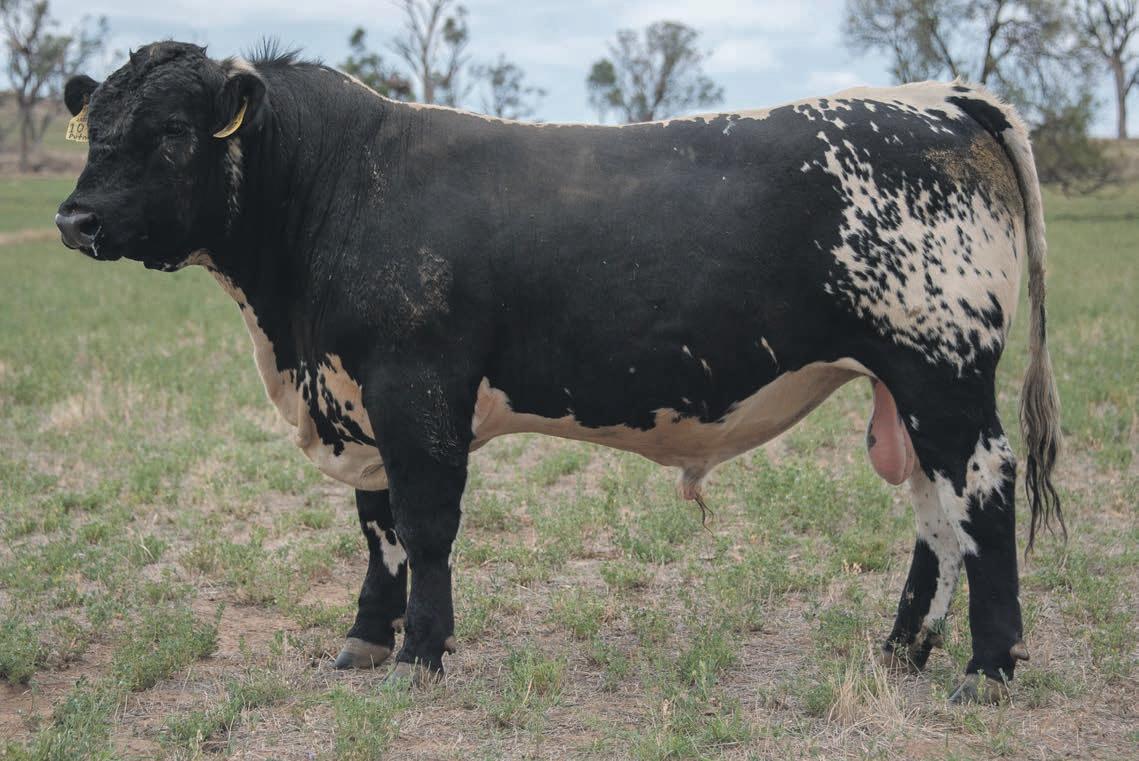
Structural Soundness Traits
Feet
Pastern Angle
Side View
Descriptive Traits
Stature
Capacity
Body Length
Muscle Score
Doability
Stature
Capacity
Muscling
Leg Angle
Feet/Pasterns Scrotal
Evaluation of the shape and evenness of the front and rear feet, with 5 being ideal. Scores greater than 5 exhibit some scissor claw in feet. Scores less than 5 are open clawed.
Evaluation of strength of pastern, depth of heel and length of foot, with five ideal. Scores greater than 5 tend towards having shallow heel, less than 5 towards being stubbed toe.
Evaluation of the angle measured at the front of the hock. Scores greater than five indicate towards sickle hocked, less than 5 indicate the animals towards being straight (post-legged).
Evaluation of bulls for maturity pattern and frame size. A stature score of 25 is average. This score may be influenced by age of dam, nutrition etc. Scores greater than 25 indicate larger frame, later maturing cattle.
Evaluation combines depth of rib, spring of rib and width of chest floor. Scores greater than 25 indicate a bull with larger capacity.
Evaluation of body length from point of shoulder to pin bone. Scores greater than 25 indicate longer body length.
Is the muscularity of the bull devoid of subcutaneous fat. Higher scores indicate animals with higher yield attributes. Scores 25 = C muscle 30 = C+ 35 = B40 = B 45 = B+
The ability of a bull to deposit fat in fat depots, relative to their peers under a common management regime.
STRUCTURAL ASSESSMENTS
STATURE
CAPACITY
STATURE
BODY LENGTH
CAPACITY
FRONT FEET
BODY LENGTH
Evaluation of an animals frame size, based on visual assessment of the animals hip height.
Evaluation of an animal by visual assessment combining depth of fore rib along with spring of rib and width of chest floor as well as depth of flank.
Evaluation of an animals frame size, based on visual assessment of the animals hip height.
The greater the score, the greater an animals capacity.
Evaluation by visual assessment of an animals length from withers to pins.
Evaluation of an animal by visual assessment combining depth of fore rib along with spring of rib and width of chest floor as well as depth of flank.
The greater the score, the greater the body length.
Evaluation by visual assessment of an animals front feet structure.
Evaluation by visual assessment of an animals length from withers to pins.
Tending open claws HIND FEET
FRONT FEET
REAR LEG SET
HIND FEET
REAR LEG SET
FEET & PASTERNS
Evaluation by visual assessment of an animals hind feet structure.
Evaluation by visual assessment of an animals front feet structure.
Evaluation by visual assessment of animals rear feet structure.

Tending open claws
Evaluation by visual assessment of an animals hind feet structure.

Evaluation by visual assessment of animals rear feet structure.
Tending open claws
Tending open claws

Ideal Tending sickle hooked
Evaluation by visual assessment of an animals length and strength of heel.
Evaluating the tightness of the sheath of the bull.
Weaker pastern, less heel Ideal Stronger pastern, more heel MUSCLING Evaluation by visual assessment of an animals combined width of rump and hindquarter, with secondary consideration given to forearm muscling.
SHEATH
Evaluating the tightness of the sheath of the bull.
Structural problems and temperament in cattle have a substantial effect on both the reproductive and growth performance of a beef herd. It is widely recognised that structural problems in sires have detrimental effects on conception rates, calving patterns and thus profitability. Similarly, females with inadequate structural characteristics are more prone to weaning lighter calves or conceiving later in the breeding season than their more functional counterparts. These structural problems are filtered through the supply chain resulting in reduced income for the producer, feedlot and overall industry productivity. Dick Whale assesses our sale cattle at least twice in their life before sale day. Having our cattle independently assessed assists us to make unbiased decisions around culling for structure and temperament.
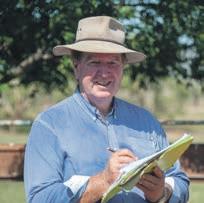
Dick’s Pick – Dick’s top 3 bulls, based
BREEDPLAN BREAKING DOWN
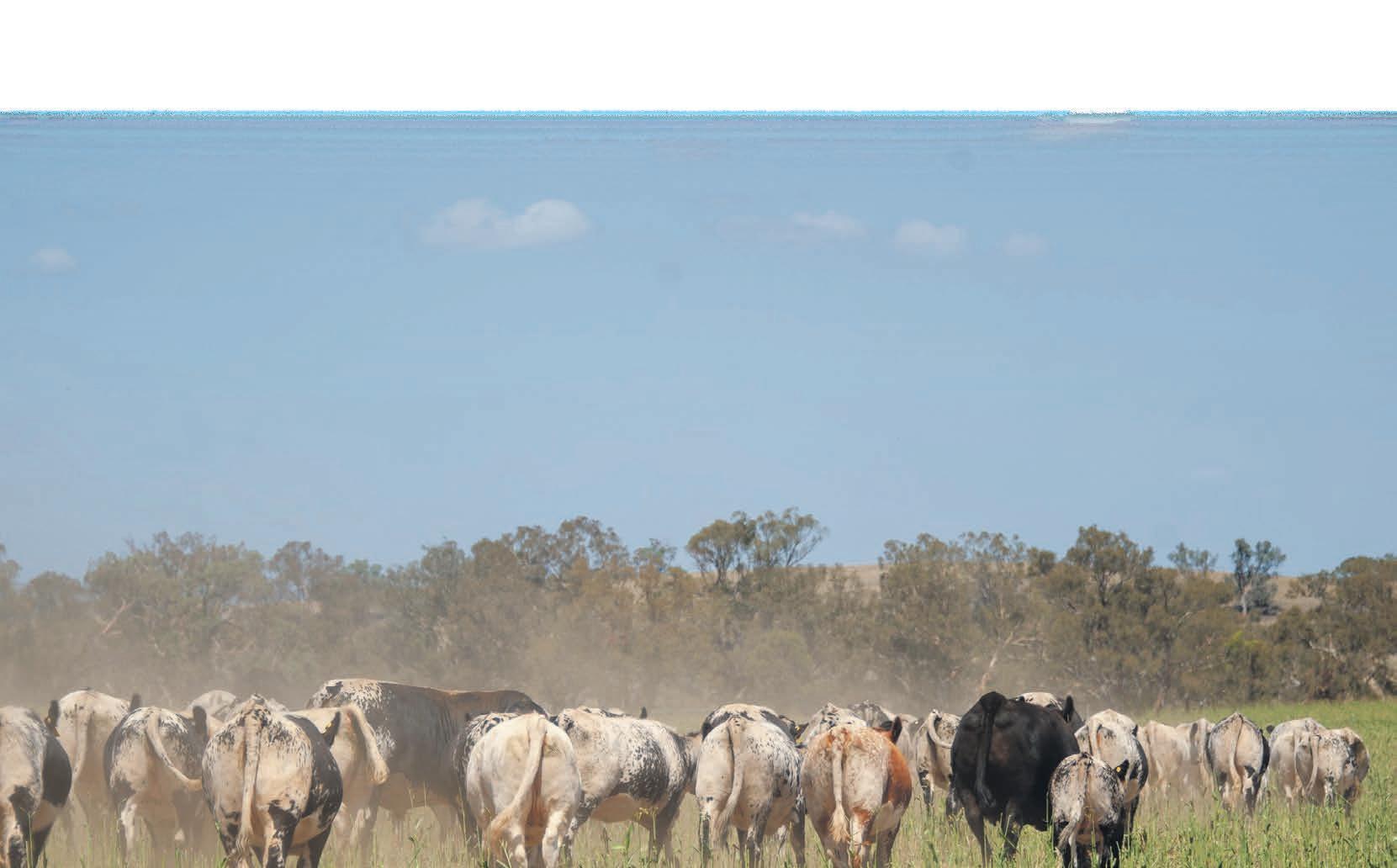
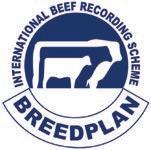
Estimated Breeding Values (EBVs) published for registered Speckle Park bulls in this catalogue are from the June 2024 SINGLE-STEP BREEDPLAN run. Below is a description for each EBV and how to apply the information:
EBV FOR BIRTH WEIGHT (BWT)
Birth weight is a major factor in calving difficulty. Use EBVs to select against birth weight if dystocia is a problem. The lower the EBV the lighter the calves are expected to be.
EBVS FOR 200-DAY GROWTH AND MILK
Vealer producers should place emphasis on the 200-day growth and milk genes. If the bull is to be used as a terminal sire, growth is most important. If a bull is to used to breed replacement heifers, and superior milking and mothering ability is required, then consider the milk genes with the EBV for milk (kg). The estimate in kg milk is not the yield of milk of the dam, but the growth of the calf due to more milk and better mothering of the dam. At JAD Speckle Park, we submit two 200-day weights for improved accuracy of this EBV.
EBV FOR 400-DAY WEIGHT
400-day weight EBVs are a measure of the animal’s ability to grow to 400-days-of age (can be measured from 301-500 days). It should be used by producers who wish to turn off yearling cattle. At JAD Speckle Park, we submit two 400-day weights for improved accuracy of this EBV.
EBV FOR 600-DAY WEIGHT
600-day EBVs are computed for growth to 600-days-of-age (can be measured at 501-900 days). It is the best prediction
of an animal’s ability to grow onto maturity, hence it is important for the heavy steer producer.
CARCASE TRAITS
These traits are calculated from live scan data and are adjusted to a standard steer carcase weight of 300kg.
FAT DEPTH EBV (RIB AND RUMP)
Measured in millimetres at either 12/13 rib or P8 sites. As these EBVs increase, the progeny can be expected to fatten more easily but carcase yield may decline.
RETAIL BEEF YIELD (RBY%)
The percentage of retail cuts compared to total carcase weight. Related to EMA and Fat Depth and Weight EBVs.
INTRA MUSCULAR FAT (IMF%)
The percentage of fat to muscle in the eye muscle. Used as a more precise measure than Marbling Score.
EYE MUSCLE AREA (EMA)
EBVs are relative to the breed average EBV each trait. A larger EMA EBV (sq.cm.) means more muscling and generally higher carcase yield relative to carcase weight.
SPECKLE PARK SINGLE-STEP BREEDPLAN
Speckle Park Single-Step BREEDPLAN uses pedigree, performance and genomic information simultaneously. The analysis takes account of each animal’s actual genetic relationship with all other genotyped animals, including those in the reference population. The EBVs in all herds relate to a common base. This increases the accuracy of the data, as well as allowing comparison of the genetic merit of the animals from different herds (across herd) within the group.
Each reported trait shows an EBV and its Accuracy level. The EBV (Estimated Breeding Value) provides the best current estimate of the bull’s true genetic merit for that trait, relative to the overall base for the Speckle Park breed. It indicates how his progeny should perform relative to those of other bulls in the breed.
The Accuracy indicates how well an EBV predicts the true genetic worth of an animal. The Accuracy of an EBV will be higher for traits with a higher heritability and will increase as more performance information on an animal and its relatives becomes available. The Accuracy of an EBV is reported as a percentage. EBVs with high accuracy will change less than EBVs of low Accuracy when more performance records are analysed.
The following guide may be useful for interpreting Accuracy:
▶ Less than 50% Accuracy - the EBVs are preliminary. EBVs in this range will have been calculated based on very little information. These EBVs could change substantially as more direct performance information becomes available on the animal
▶ 50-74% Accuracy - the EBVs are of medium Accuracy. EBVs in this range will usually have been calculated based on the animal’s own performance and some limited pedigree information
▶ 75-90% Accuracy - the EBVs are of medium-high Accuracy. EBVs in this range will usually have been calculated based on the animal’s own performance coupled with the performance for a small number of the animal’s progeny.
▶ More than 90% Accuracy - the EBVs are a high Accuracy estimate of the animal’s true breeding value. It is unlikely that EBVs will change considerably with addition of more progeny data.
SPECKLE PARK SELECTION INDEXES
There were four selection indexes introduced for the Speckle Park breed in mid-2023: domestic maternal, domestic terminal, export maternal and export terminal. Please visit www.specklepark.org/learn-breedplan to learn all about the new indexes and which one best suits your program.
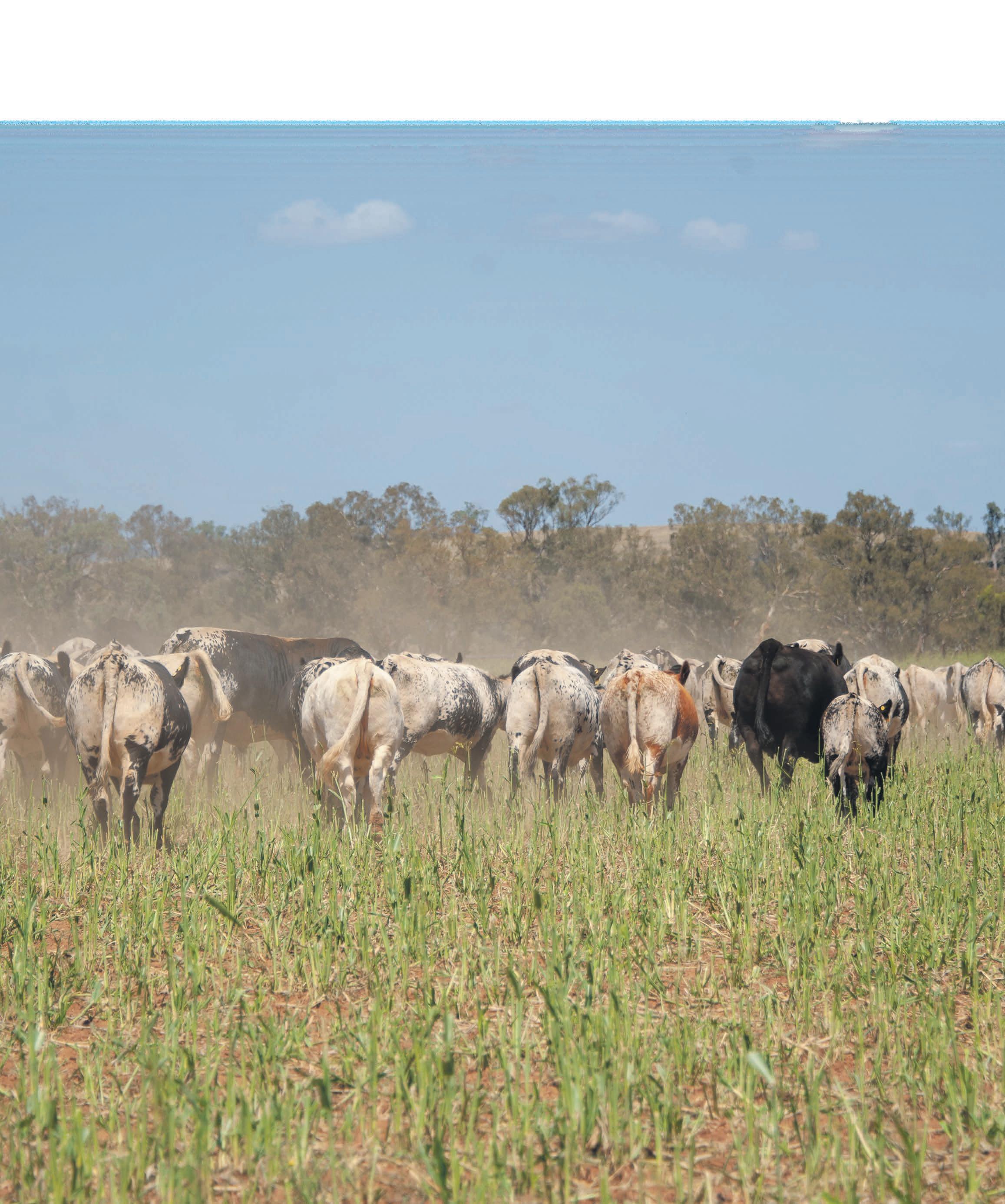
Strong futures begin with healthy minds.
We’re here to sell livestock. To feed passions, make memories, and create futures. Let’s take a moment to acknowledge that none of that is possible without strong mental health.
Depression. Suicide. Pain. Loss. Bewilderment. Hopelessness. Poor mental health affects more of us in the grandstands today than we can imagine. Its impact on society is monumental and it is claiming some of society’s best. It took my Mum when I was 17 and has impacted me hugely. The Black Dog Institute is a fantastic initiative that is dedicated to understanding, preventing and treating mental illness. I have selected my favourite bull in this sale catalogue – chosen for no particular reason other than him being my favourite – and we will donate 10% of the auction sale price of this bull to the Black Dog Institute. Please, don’t suffer in silence.
The selection from this catalogue is Lot 6: JAD Topside T52.
Look for this icon to find my pick!
THE LOCATION
Getting to the Sale
Sale Location:
Rolleston Livestock & Grain Selling Complex
Dip Road Rolleston, QLD
Driving Directions:
Type “Rolleston Livestock and Grain Pty Ltd” as your destination in Google Maps.
Transport Accommodation
The sale location is approximately 90 minutes drive (133km) from the Emerald Airport. Due to the uncertainty around flight times, we recommend you carry out your own research into current flight arrangements into Emerald.
There are a number of Motels, Hotels and Caravan Parks in Emerald, which is 90 minutes north of Rolleston. Please book in advance to ensure you secure your accommodation, and feel free to reach out to Amy at (0427) 464 333 or jad@jadspecklepark.com.au for assistance. Below are some more local accommodation options to Rolleston, and an Injune option for people travelling up from further south.
Rolleston Caravan Park
Cnr Comet & Meteor Streets, Rolleston Phone: (07) 4984 3145 www.rollestoncaravanpark.weebly.com
Injune Motor Inn
12-16 Hutton Street, Injune Phone: (07) 4626 1720 www.injunemotorinn.com.au
Rolleston Hotel Motel 39 Warrijo Street, Rolleston Phone: (07) 4984 3440
Springsure Overlander Motel 10 Eclipse Street, Springsure Phone: (07) 4984 1888 www.springsureoverlandermotel.com.au
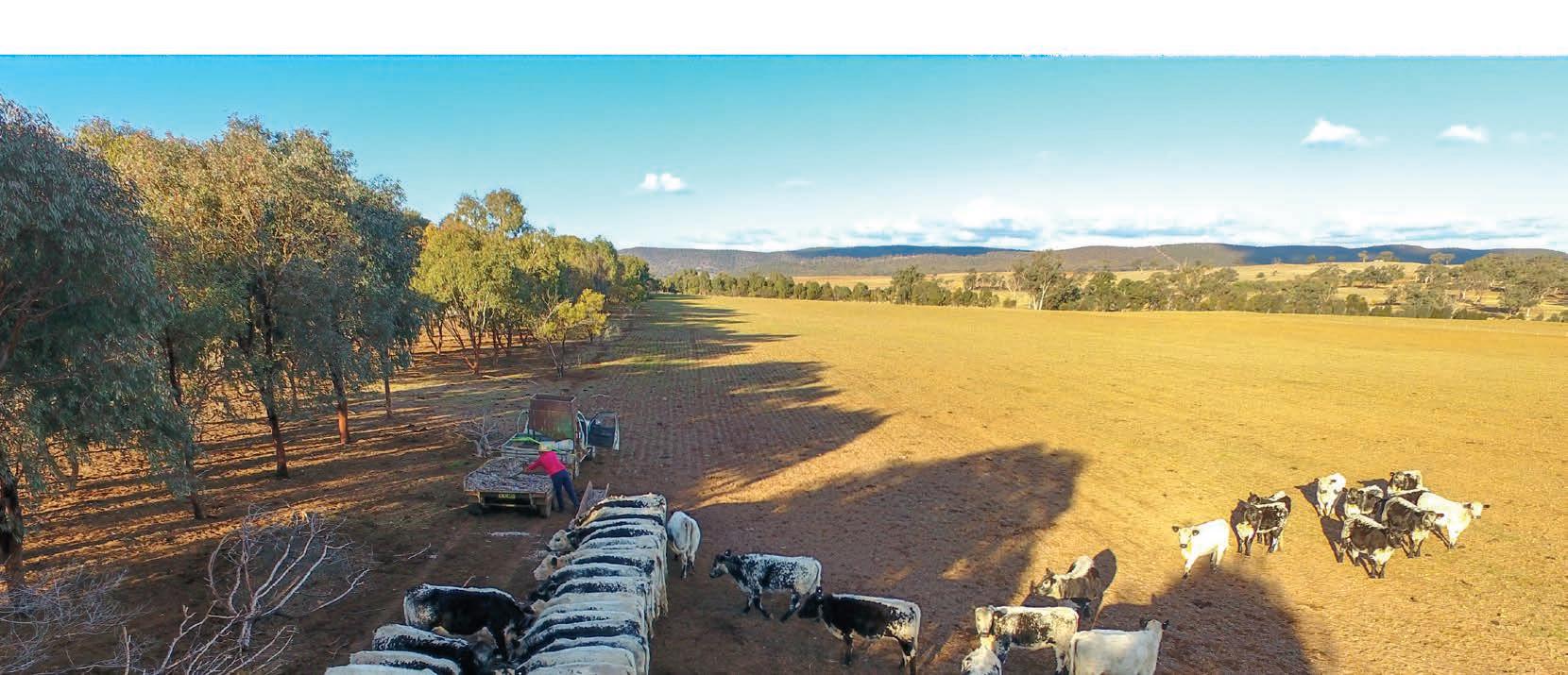
Rolleston Rolleston Racecourse Rolleston Livestock & Grain Selling Complex
2 3 4 5
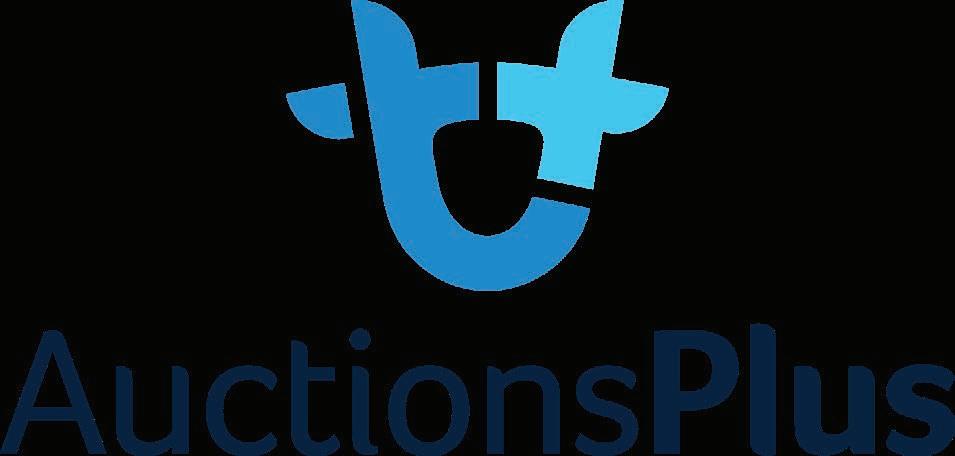
Go to www.auctionsplus.com.au to register at least 48 hours before the sale. Select “Sign Up” in the top right hand corner.
Fill out your name, mobile number, email address and create a password.
7
Go to your emails and confirm the account.
8
Fill in buyer details and once completed go back to Dashboard.
6
Return to AuctionsPlus and log in.
Select “Dashboard” and then select “Request Approval to Buy”.
9
Complete buyer induction module (approx. 30 minutes).
AuctionsPlus will email you to let you know that your account has been approved.
Log in on sale day and connect to auction.
Bid using the two-step process –unlock the bid button and bid at that price.
If you are successful, the selling agent will contact you post sale to organise delivery and payment.
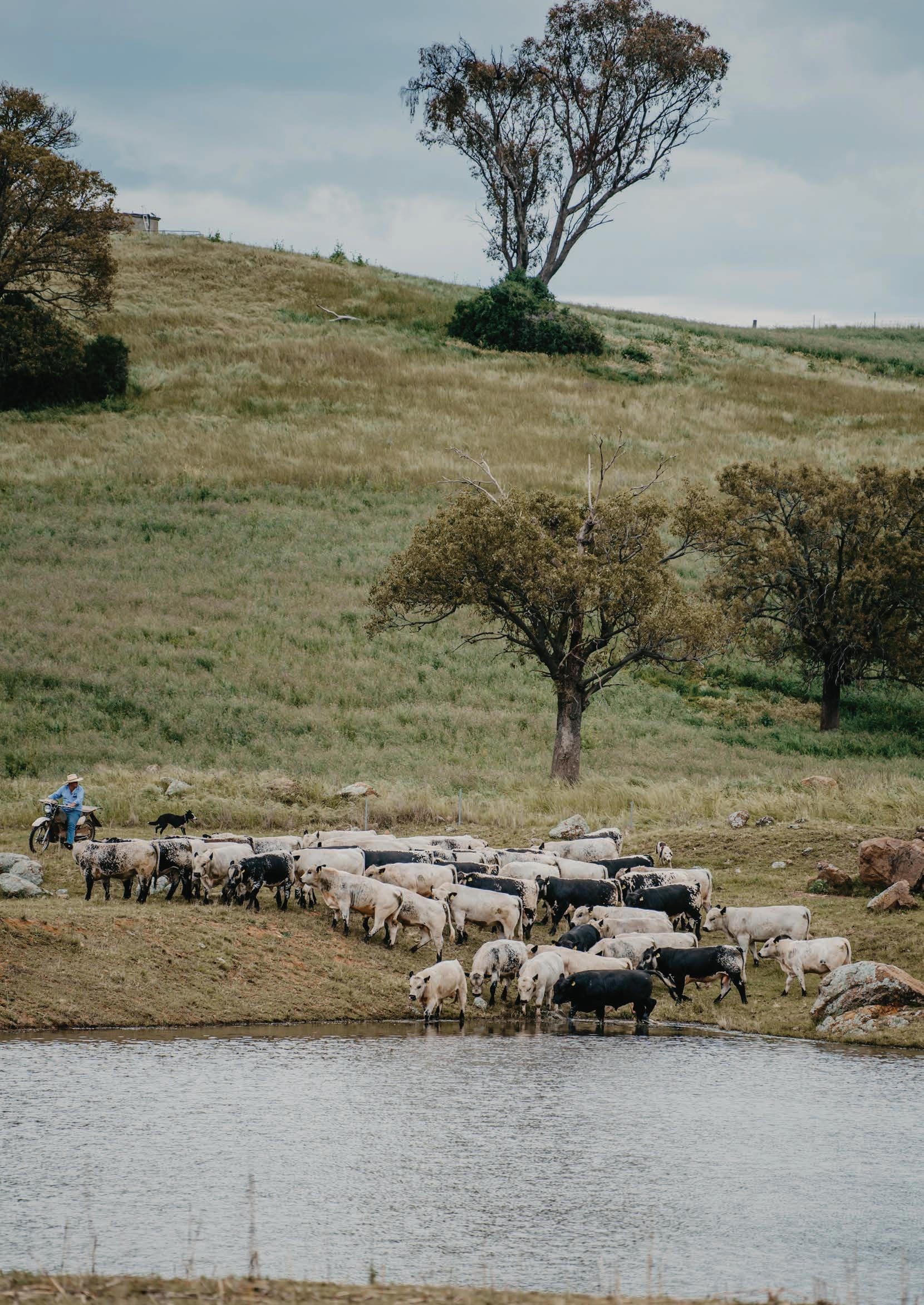
JAD SPECKLE PARK BULLS
BREEDPLAN PERCENTILES TABLE
June 2024 Speckle Park Single-Step BREEDPLAN - Percentile Bands, 2022 born animals
Use this table as a guide to compare individual animals with the current genetic level of the breed
SPECKLE PARK REFERENCE SIRES
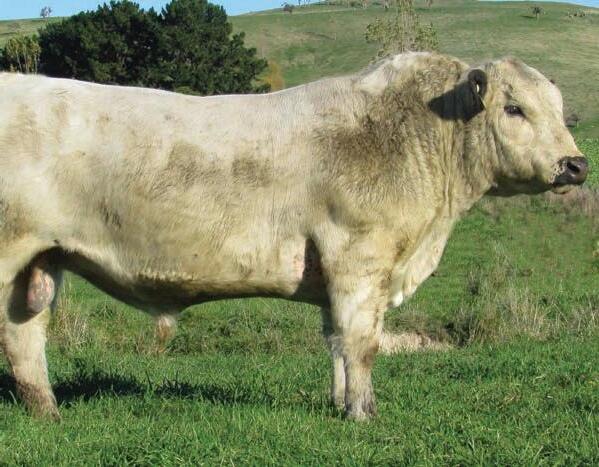

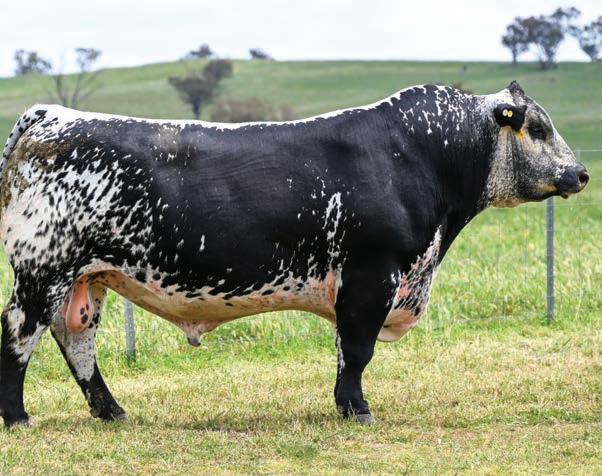
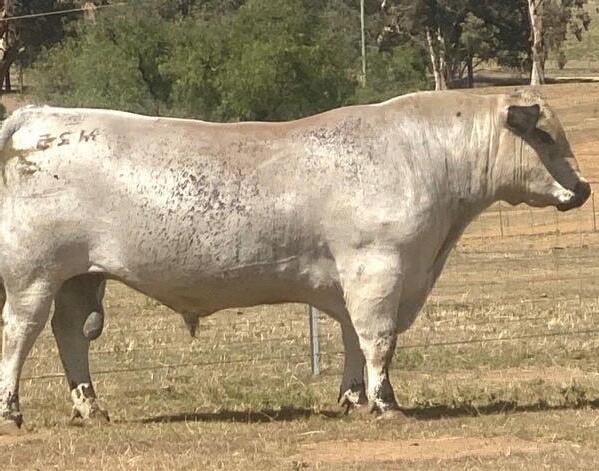
Maungahina Promise
We purchased Promise for a then-New Zealand record NZ$35,000 in 2020. His progeny are super docile, with a little extra bone and length of body. He is out of the same cow as our coowned sire, Maungahina Nikko. His first daughters are milking very well.
We co-purchased Nikko in 2019, and he is breeding exceptionally well. We have gone on to use him extensively. Nikko is one of the best-moving Speckle Park bulls we have seen, and is breeding very little waste in his progeny.
Quistacat is the most fluent-moving Speckle Park bull we have seen. Excellent structure, top 1% of the breed for scrotal size, and producing excellent docility in his progeny. His first daughters have raised excellent calves, and have held their condition well.
Minnamurra Montezuma M25
Montezuma has become a household name in Speckle Park, combining calving ease, short gestation and lower birthweights with plenty of growth, muscle and top 10% fats. Extra length and softness.
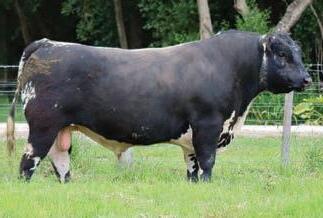
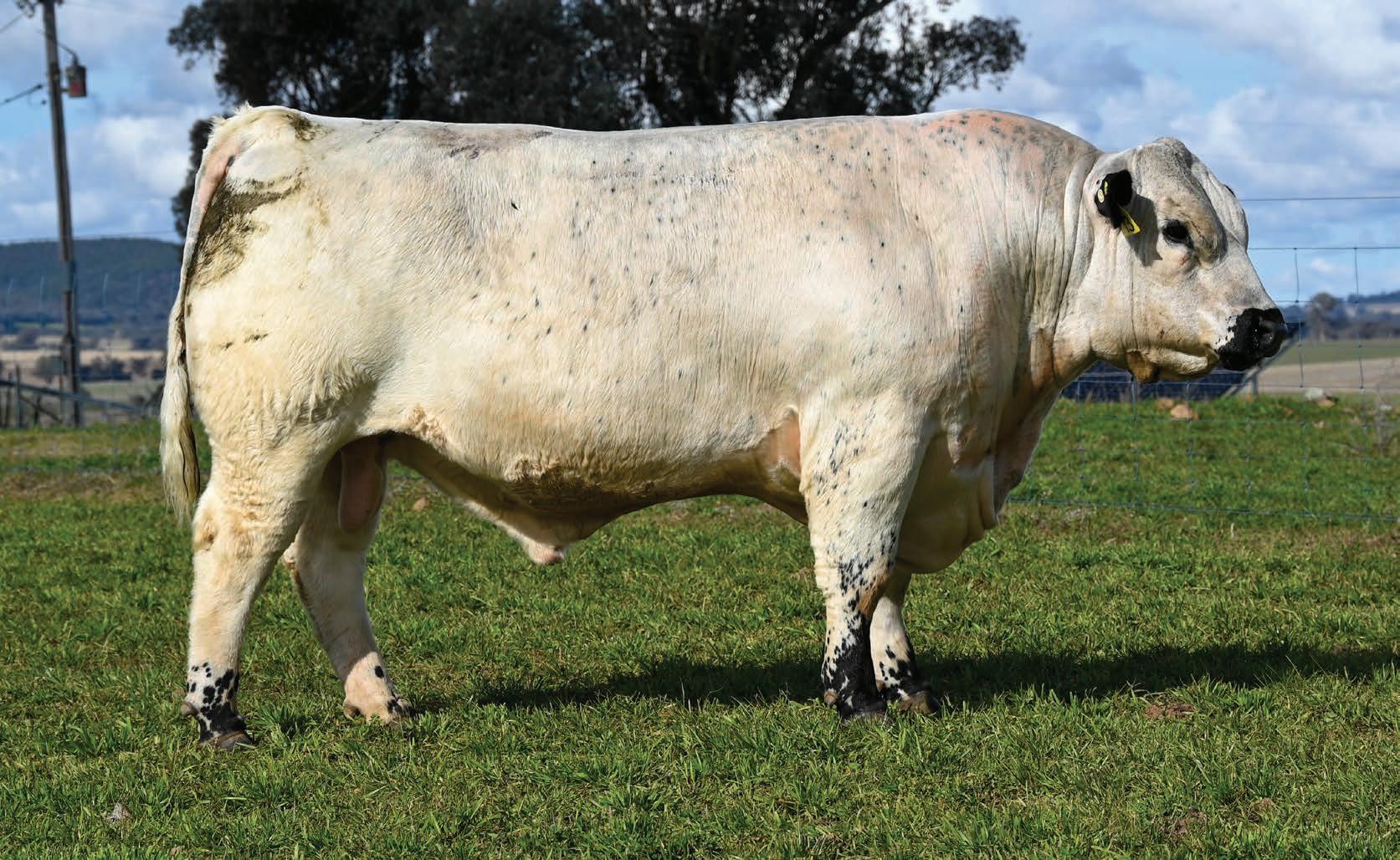
JAD Tic Tac T93 (ET)
Leading off our Inaugural JAD QLD sale catalogue, Tic Tac T93 is a brick on legs! An incredibly easy doing bull, with an early maturity pattern and loads of muscle.
Tic Tac T93 goes back to Ultra N63 on the dam side. Last year, we were visited by a United States cattle master breeder, who was on tour to select Speckle Park genetics to ship to Dubai. Ultra N63 was one of two females selected to be flushed. Ultra N63 also bred a bull we have retained within-herd, JAD Tuxedo T134, who was the second highest indexing bull from our meat research with the University of Newcastle, completed last year.
Sire: Maungahina Nikko.
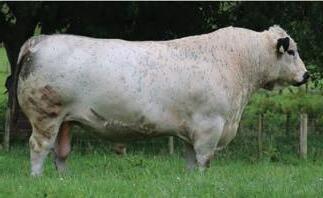
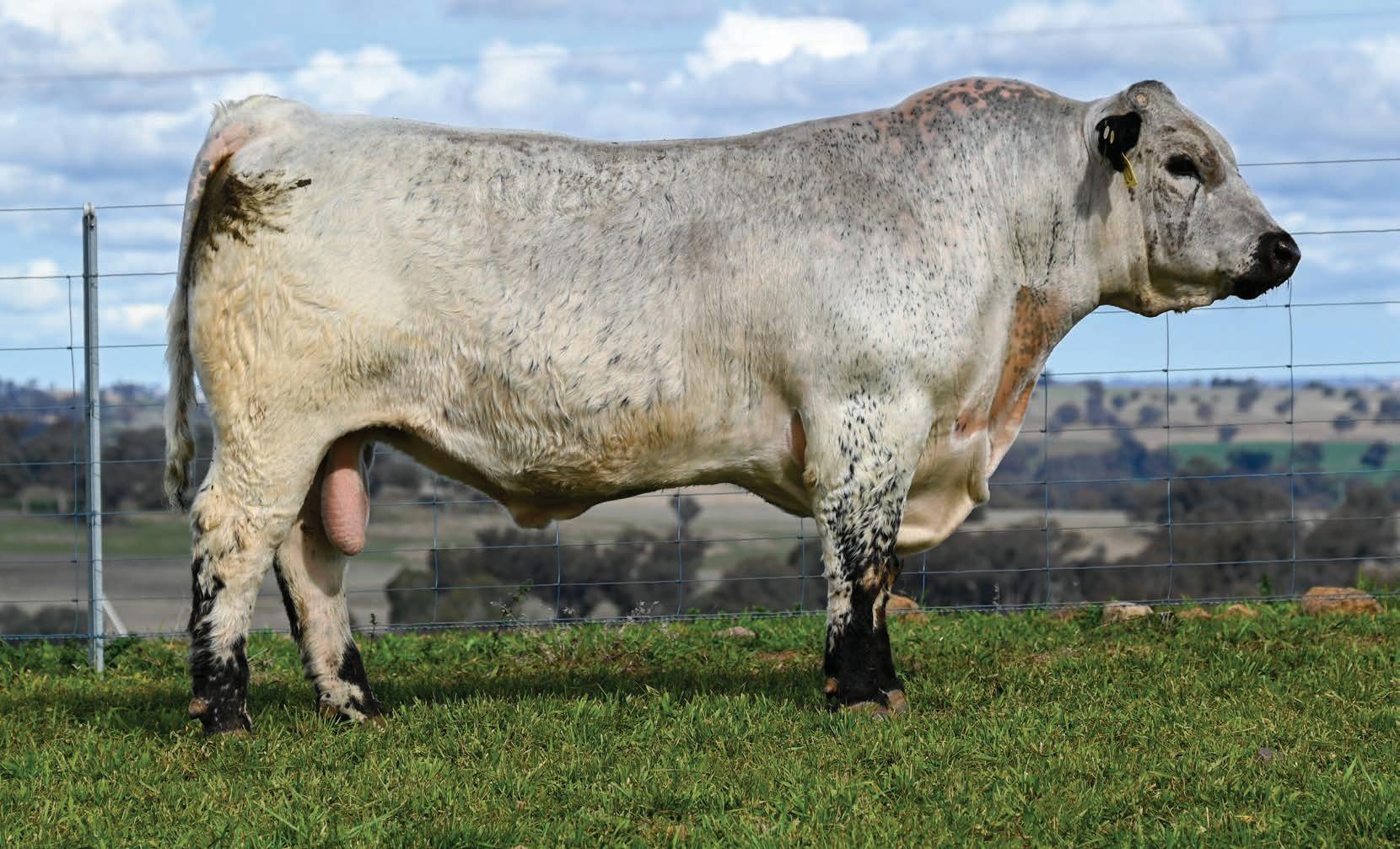
JAD Trailblazer T10 (ET)
Trailblazer T10 is an outstanding son of Maungahina Northern Star, out of a Line Drive/42Y daughter, Amanda N53. Heifers of this mating sold particularly well at our Accelerate Female Sale last September.
Trailblazer T10 is a larger-framed bull with added length. He is a trait leader for growth, milk, fats - including top 5% for IMF - and he is also in the top 25% of the breed for the Export Terminal Index.
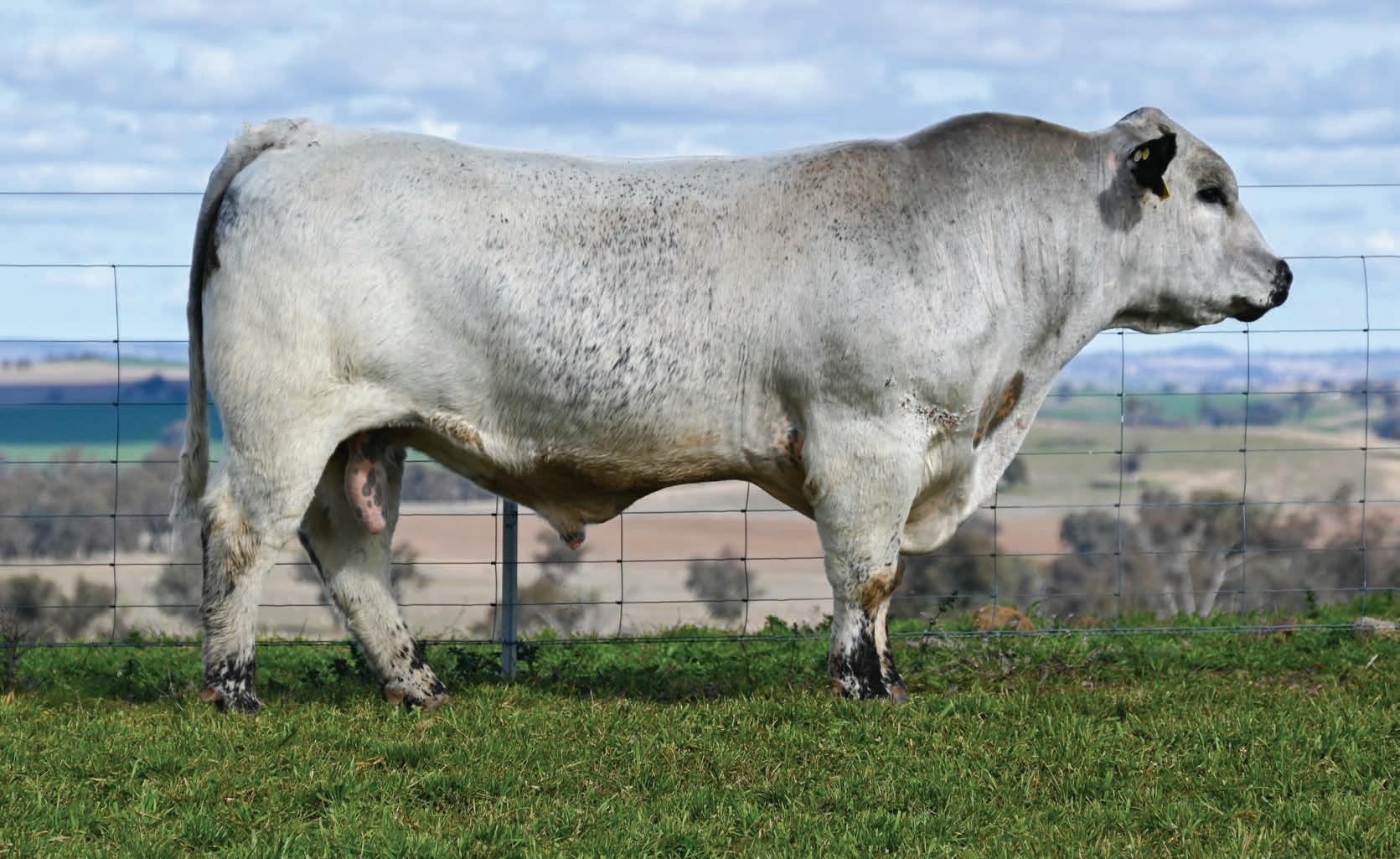
JAD Tuckerbox T33 (ET)
June 2024 Speckle Park Single-Step BREEDPLAN
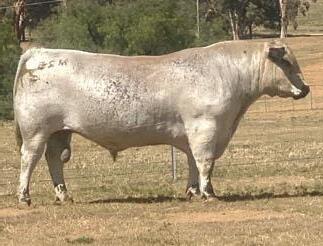
Tuckerbox T33 is an impressive slick-coated bull that couples short gestation length with plenty of growth, and outstanding carcase traits too.
His sire, Minnamurra Montezuma M25, has become one of the go-to heifer bulls in the breed, without compromising growth. He produced the $55,000 top-priced bull of the 2023 JAD on-property sale, JAD Sizzler S50. Tuckerbox T33 is out of a cow who continues to impress us each year, with her pedigree including Mainstream Eldorado E11 and Jackungah Koda K01.
Sire: Minnamurra Montezuma M25.
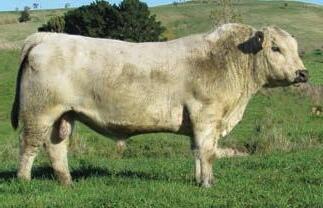
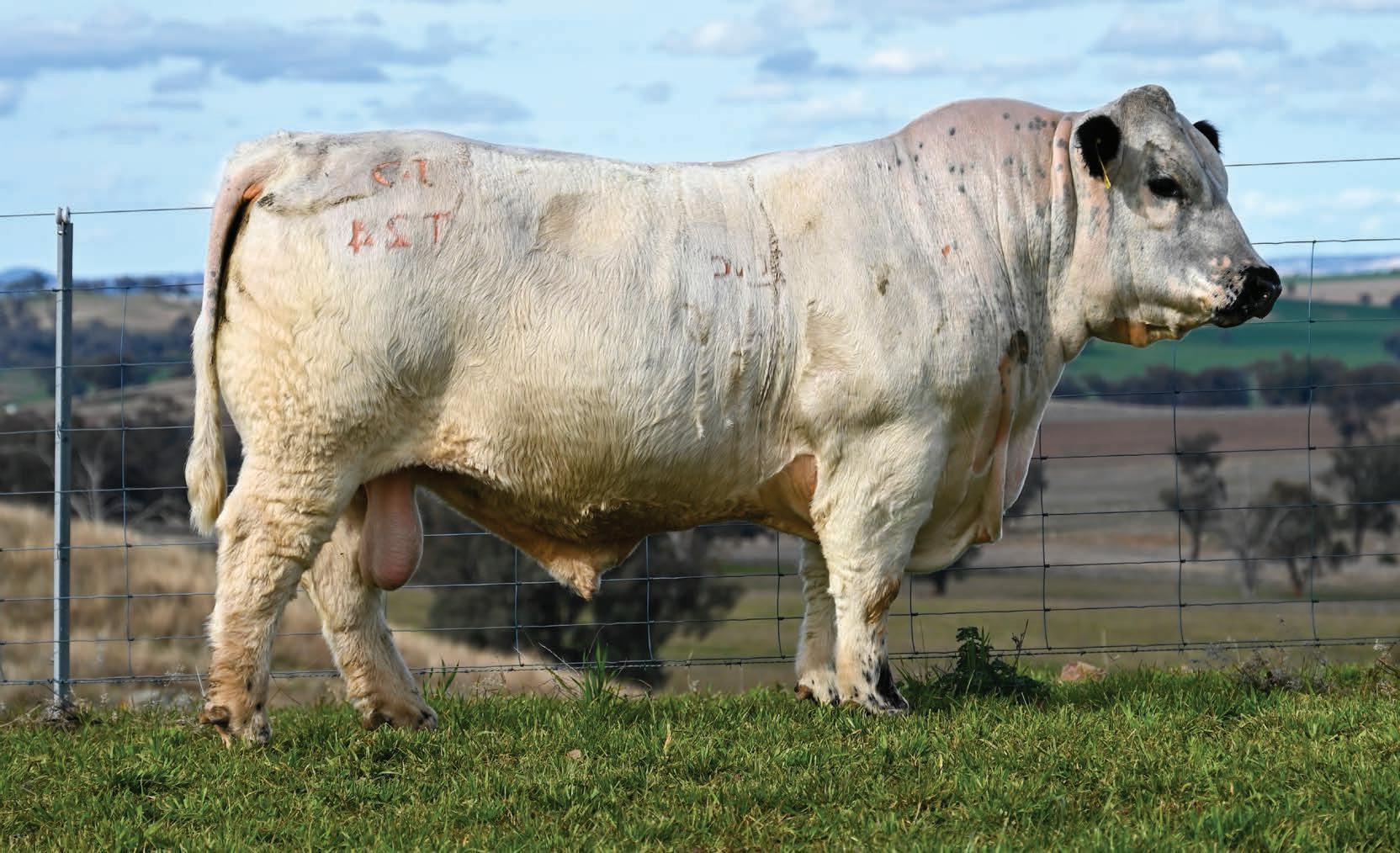
JAD Tangaratta T24 (ET)
Everyone who sees Tangaratta T24 is taken by his incredible softness. He is so deep, thick, and super quiet too.
Tangaratta T24 is an ideal vealer bull, compact by design. He comes from a very functional and efficient cow line in our herd. His dam, Niome R7, is a soft, easy-keeping female with several daughters also retained within our herd. This is the kind of bull who will produce females that will live off the smell of an oily rag, and steers that will finish early.
Lawrin (MAU L272) (White)
J13 (MAU J13) (Speckled)
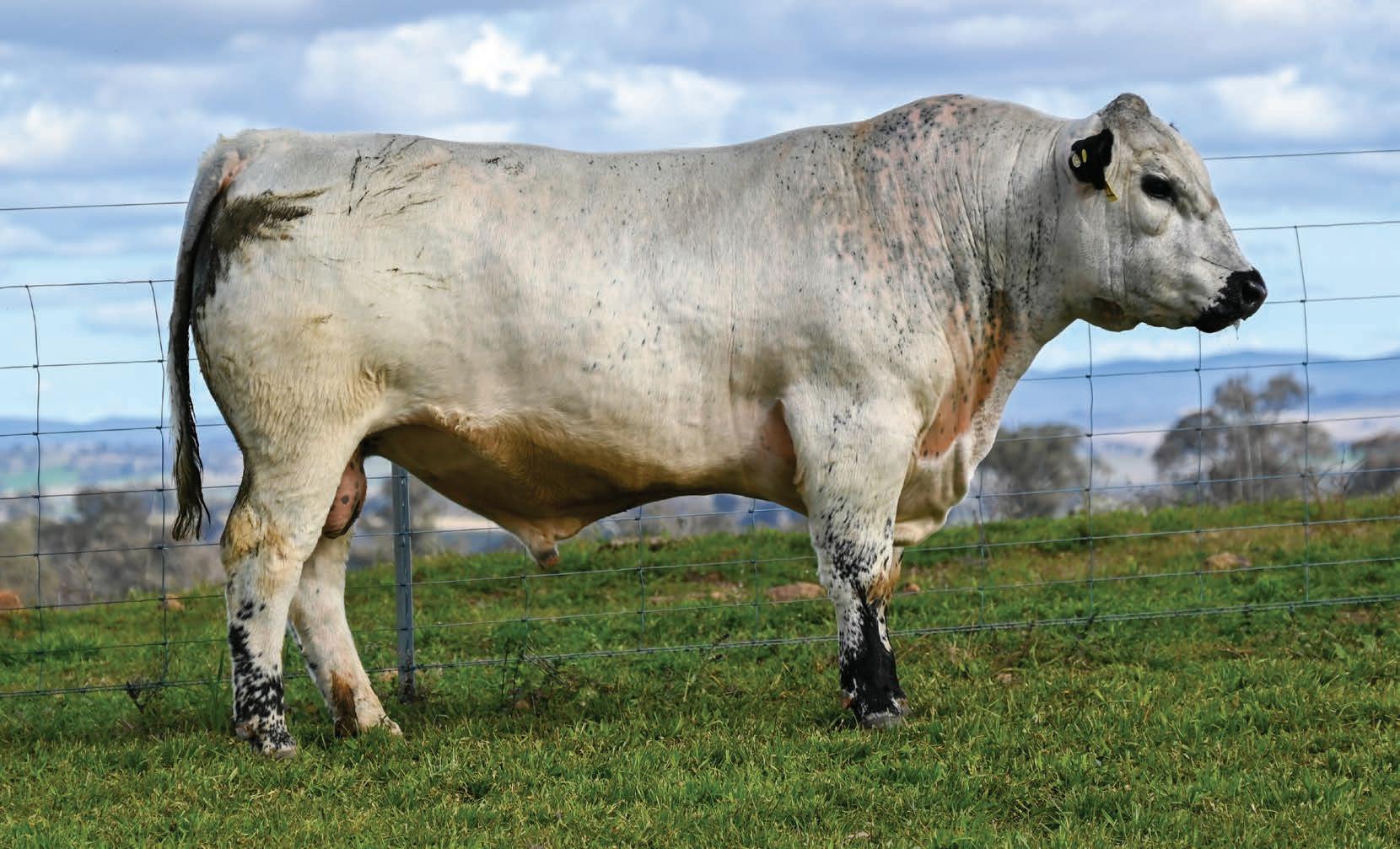
JAD Triple Two T222
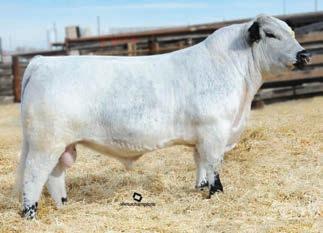
We purchased this bull’s dam, Amy K52, in September 2022, as part of a large consignment of stud females from the Turnham family’s Waratah Speckle Park Stud, Guyra. Amy K52 is a flush sister to a well-known donor cow in the breed, Mt Eccles Queen Alone (91 registered progeny).
Triple Two T222 is an eye-catching, well-made bull who features solid growth and carcase traits, including being in the top 20% of the breed for retail beef yield.
Specs Ulysses 25U (MBG 25U) (Speckled)
Qualify Q137 (LST Q137) (White)
Ember J185 (LST J185) (White)
JAD Triple Two T222 (JAD T222) (White)
E25 Amy K52 (LST K52) (Speckled)
E25 (LST E25) (Black)
Grandsire:
Waratah
Waratah
Upto
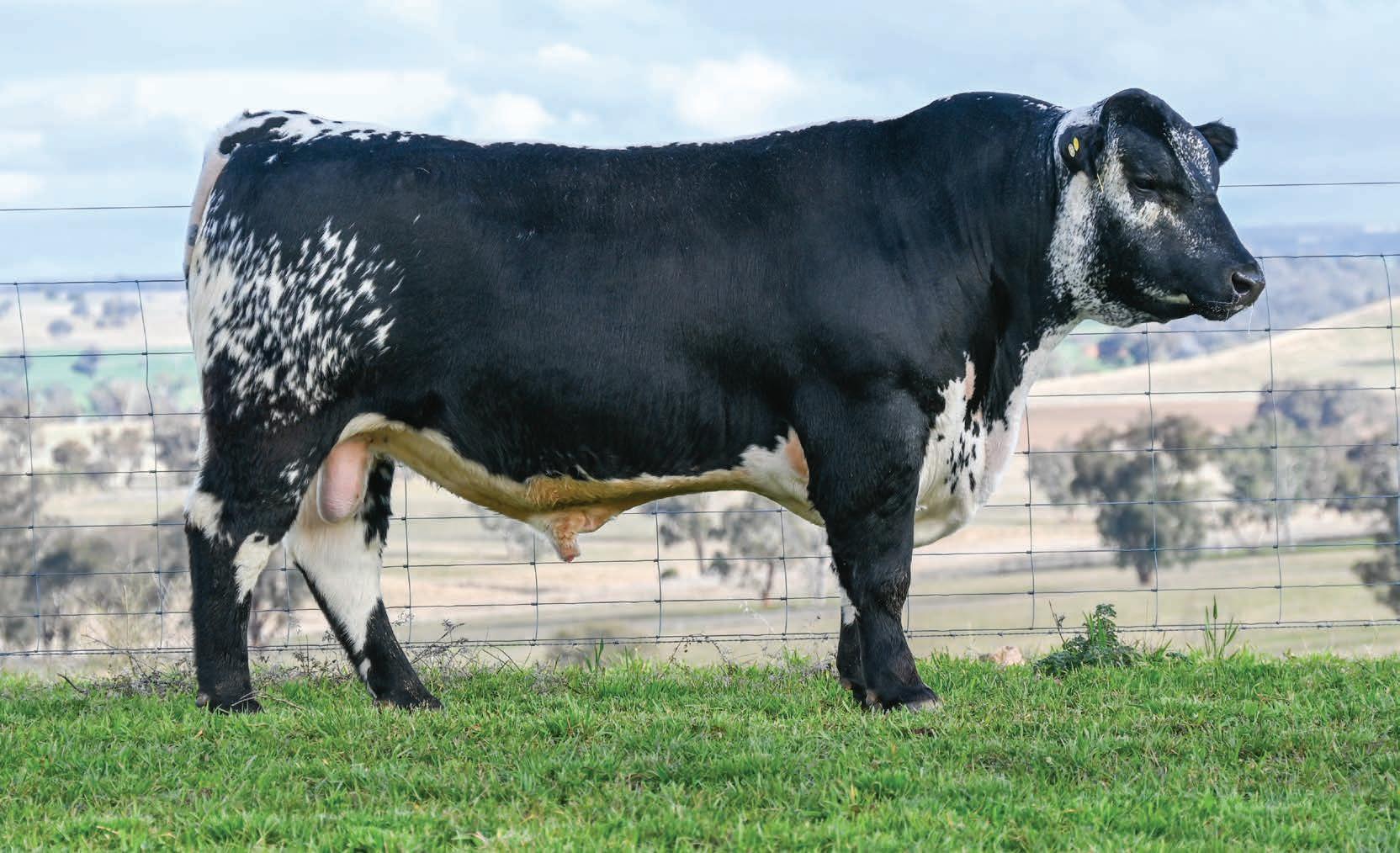
JAD Topside T52 (ET)
Topside T52 is a really well-made bull with plenty of depth and softness. We used him as a yearling over heifers, with those calves due this Spring. He will produce early-finishing progeny that will reach market specs at a young age. His dam was a favourite among our 2020-drops.
Topside T52 has a full ET-bred sister who was a high seller at the JAD Accelerate Female Sale last September. He is sired by one of our leading sires, JAD Quistacat Q48, whose semen has sold for up to $700/straw at auction.
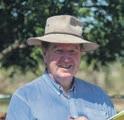
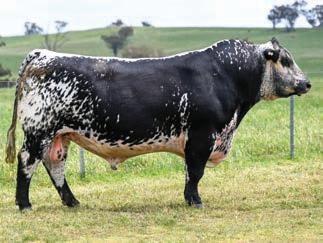
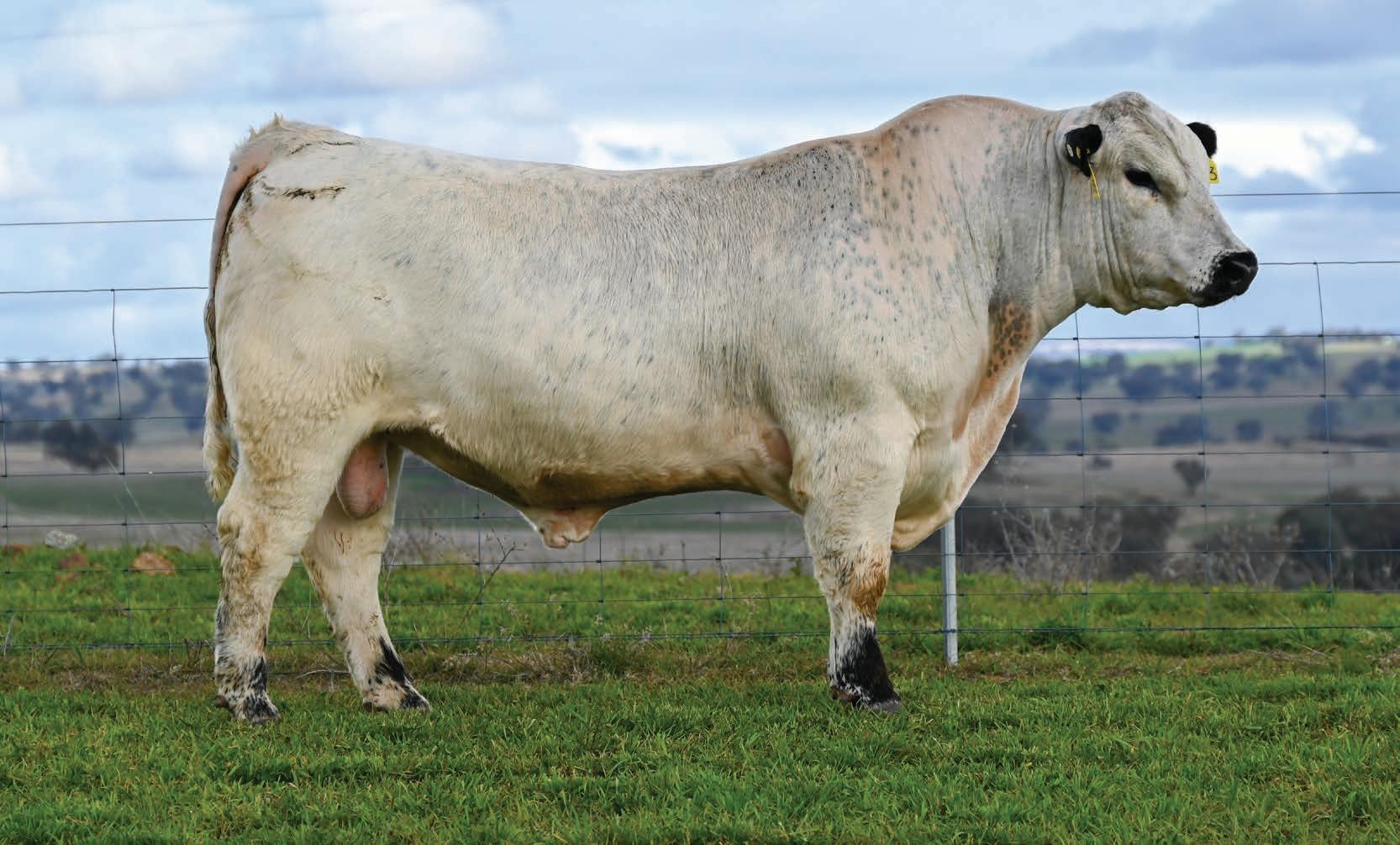
JAD Tahiti T103 (AI)
June 2024 Speckle Park Single-Step BREEDPLAN
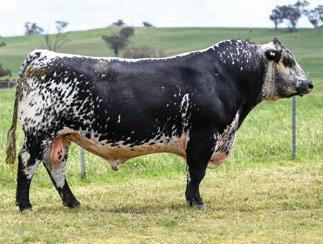
Tahiti T103 is another impressive son of JAD Quistacat Q48, who offers outstanding maternal traits right through to being in the top 1% of the breed for the Domestic Maternal Index.
Tahiti T103 is a two-year-old heifer’s first calf, produced by AI to Quistacat. He is a short gestation, low birthweight bull, so would be a suitable choice for use over heifers. His maternal grandsire, Ravenworth Invictus 103C, is also a proven heifer bull. Invictus sired the $34,000 equal toppriced bull of our 2021 JAD on-property sale.
JAD Tahiti T103 (JAD T103) (White)
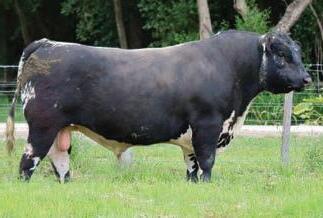
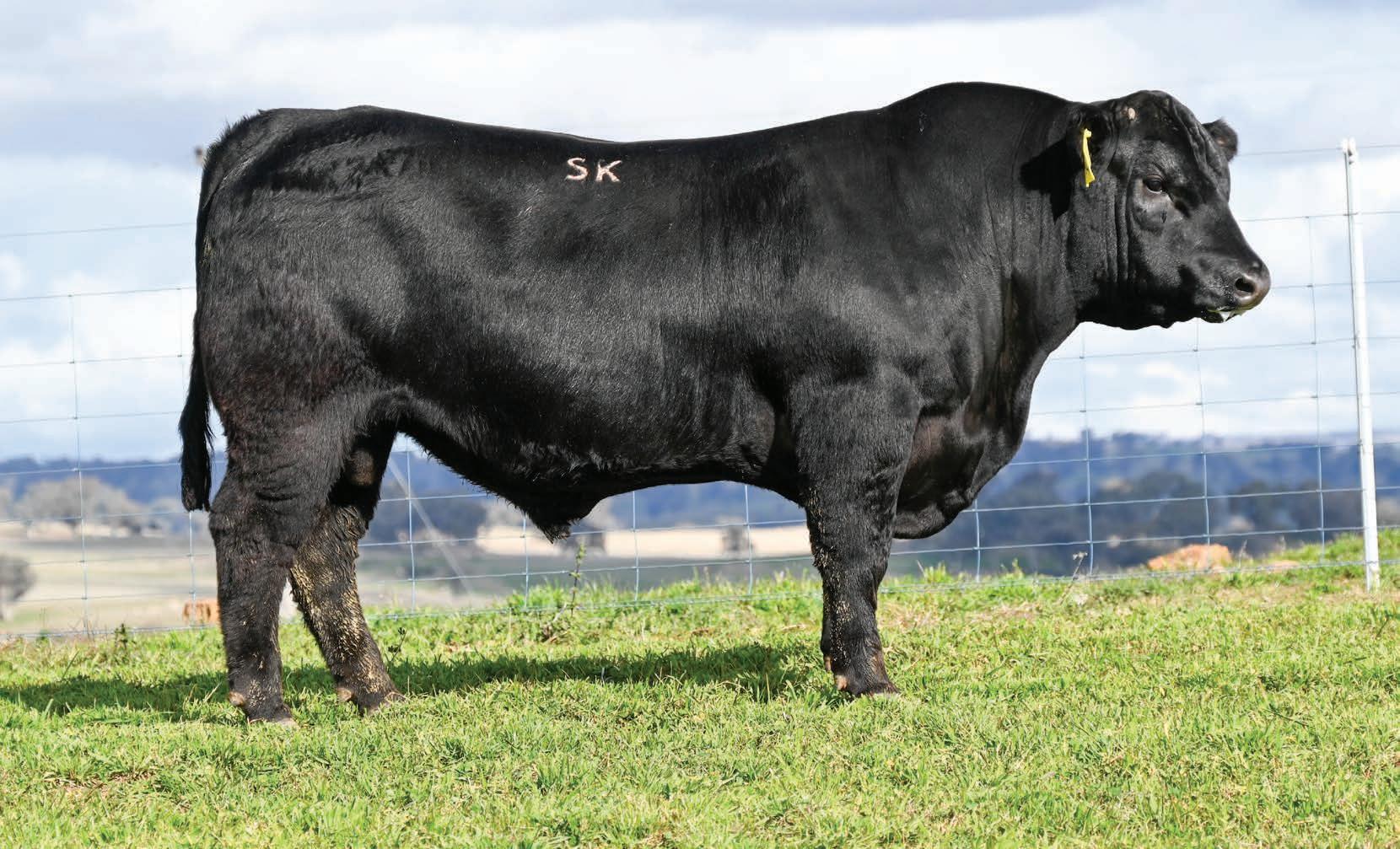
JAD The Duke T194 (ET)
The Duke T194 is an impressive black bull who offers versatility of use. He is sired by a co-owned New Zealand sire, Maungahina Nikko, who has produced outstanding bulls and females in our herd.
Nikko’s dam, Maungahina J13, also produced another of our New Zealand sires, Maungahina Promise, who we purchased in 2020 for a then-New Zealand record, NZ$35,000. The Duke T194’s dam, Yasemin N44, has been a proven donor in our herd, passing on her excellent structure, femininity in females, and docility.
The Duke T194 (JAD T194) (Black) Maungahina Nikko (MAU N264) (Speckled)
Untapped 3A (HSF 3A) (Speckled) Maungahina J13 (MAU J13) (Speckled)
3A Yasemin N44 (JAD N44) (Speckled) Maungahina Legacy (MAU L260) (Leopard)
of Uneeda 260Y (WES 260Y) (Speckled)
Sire: Maungahina Nikko.
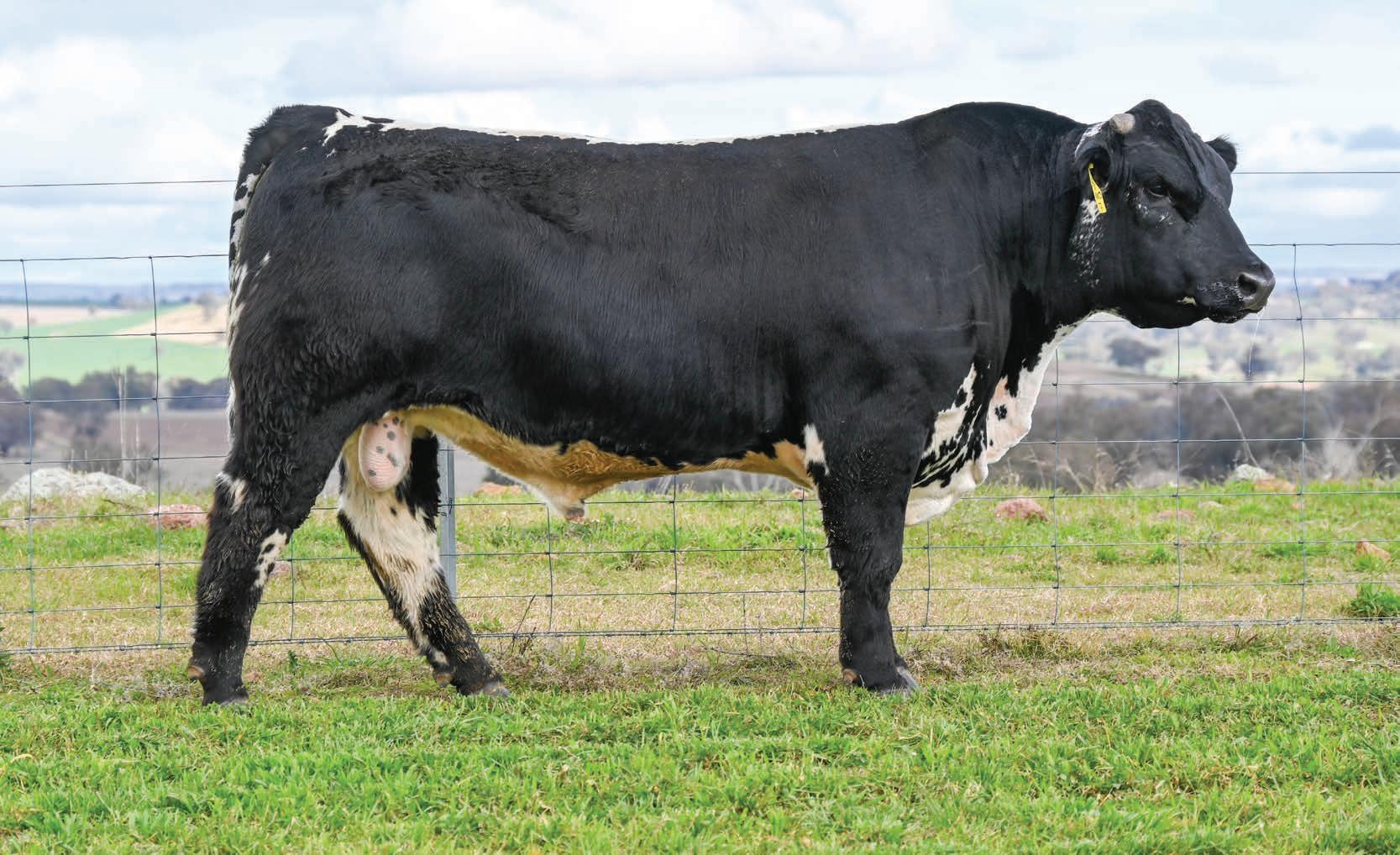
JAD Trainwreck T176 (ET)
June 2024 Speckle Park Single-Step BREEDPLAN

Trainwreck T176 is another bull by our New Zealand sire, Maungahina Nikko. The Midnight Lady cow family from which he descends has been a successful one in our herd, producing particularly impressive females.
Trainwreck T176 sits in the top 30% of the breed for scrotal size, and top 25% for retail beef yield. He is a very quiet, no-fuss bull, with good length and soundness overall.
NOTE: Trainwreck T176’s scurs are loose. He has been DNA tested as a horn gene carrier (one copy of the horn gene only).
Sire: Maungahina Nikko.
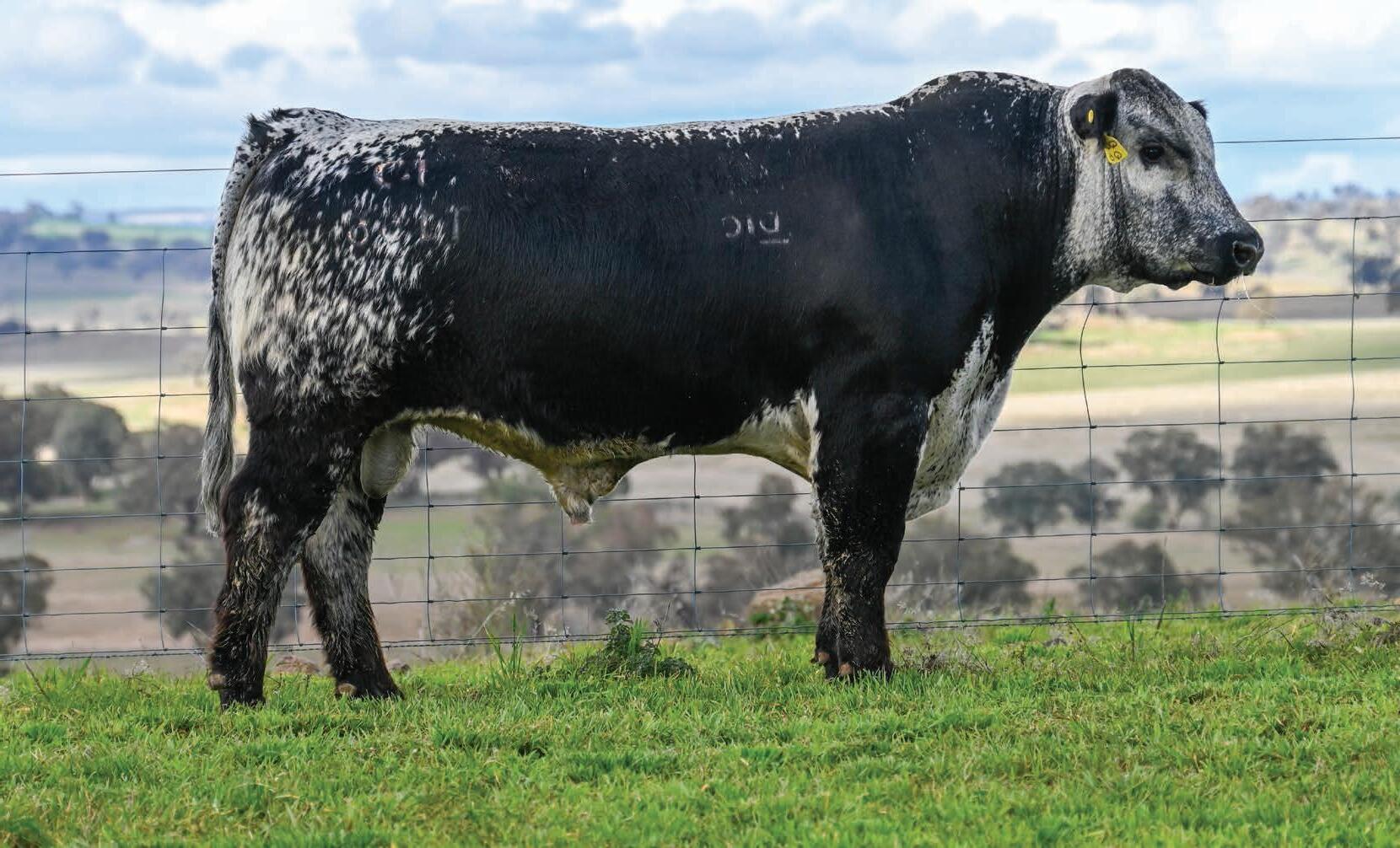
JAD Tinderbox T166 (ET)
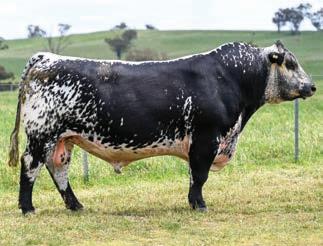
Tinderbox T166 is another well-made son of our resident sire, JAD Quistacat Q48. He sits in the top 5% of the breed for scrotal size, and all three fats. He is also in the top 25% of the breed for the Export Maternal Index.
Tinderbox T166 is out of a cow who continues to impress us each year, with her pedigree including Mainstream Eldorado E11 and Jackungah Koda K01. Tinderbox T166 is a maternal brother to the lot 3 bull.
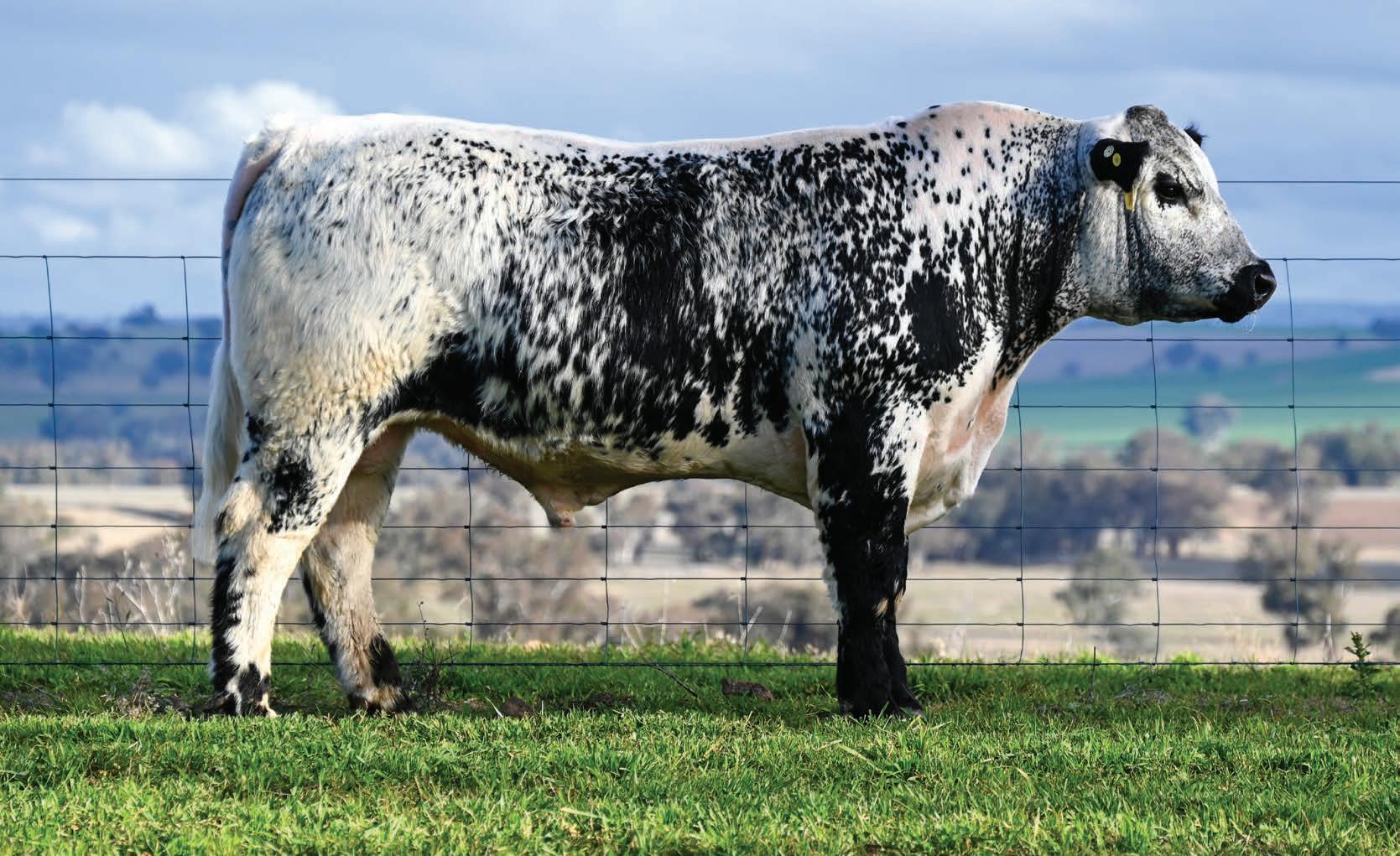
JAD Trick or Treat T149
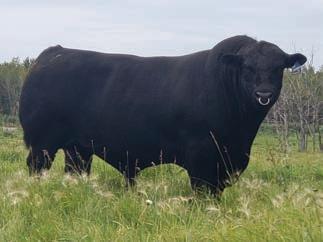
Trick or Treat T149 is another son of JAD Quistacat Q48 who sits in the top 1% of the breed for the Domestic Maternal Index, and also for scrotal size.
His dam, Flora R11, was born as a twin. She and her sister have both gone on to breed well for us. The influence of New Zealand sire, Maungahina Legacy, on our herd has been significant. He is the sire of our co-owned sire, Maungahina Nikko.
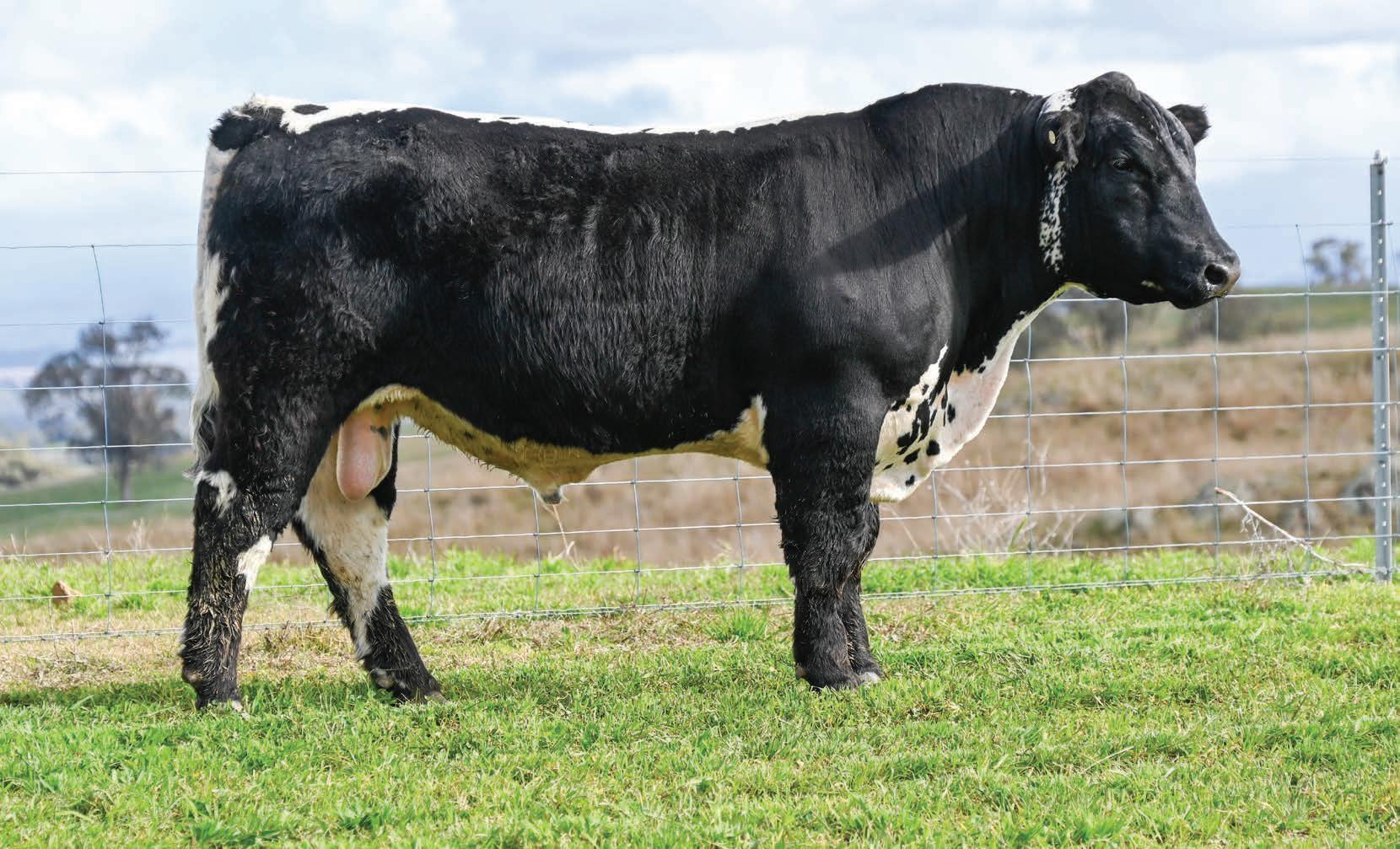
JAD Tupac T217 (ET)
June 2024 Speckle Park Single-Step BREEDPLAN
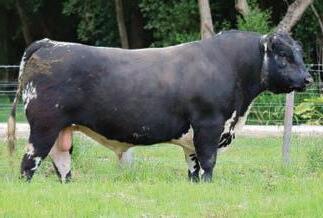
Here we have a heifer bull option who also sits in the top 20% of the breed for retail beef yield. Tupac T217’s dam, Amy P130, has been an outstanding donor dam in the JAD herd, producing no-fuss, commerciallyrelevant bulls with a very low cull rate.
Tupac T217’s maternal graddam, Waratah E27, is one of the most well-known donor dams in the Speckle Park breed, with 116 registered progeny at last count. This cow has been a breed changer. The E27 progeny at JAD are highly fertile, quiet and stand on excellent feet and legs.
Maungahina Legacy (MAU L260) (Leopard)
Maungahina Nikko (MAU N264) (Speckled)
Maungahina J13 (MAU L13) (Speckled)
JAD Tupac T217 (JAD T217) (Speckled)
JSF Continental 9C (JSF 9C) (Speckled)
Waratah Amy P130 (LST P130) (White)
Waratah E27 (LST E27) (White)
Sire: Maungahina Nikko.
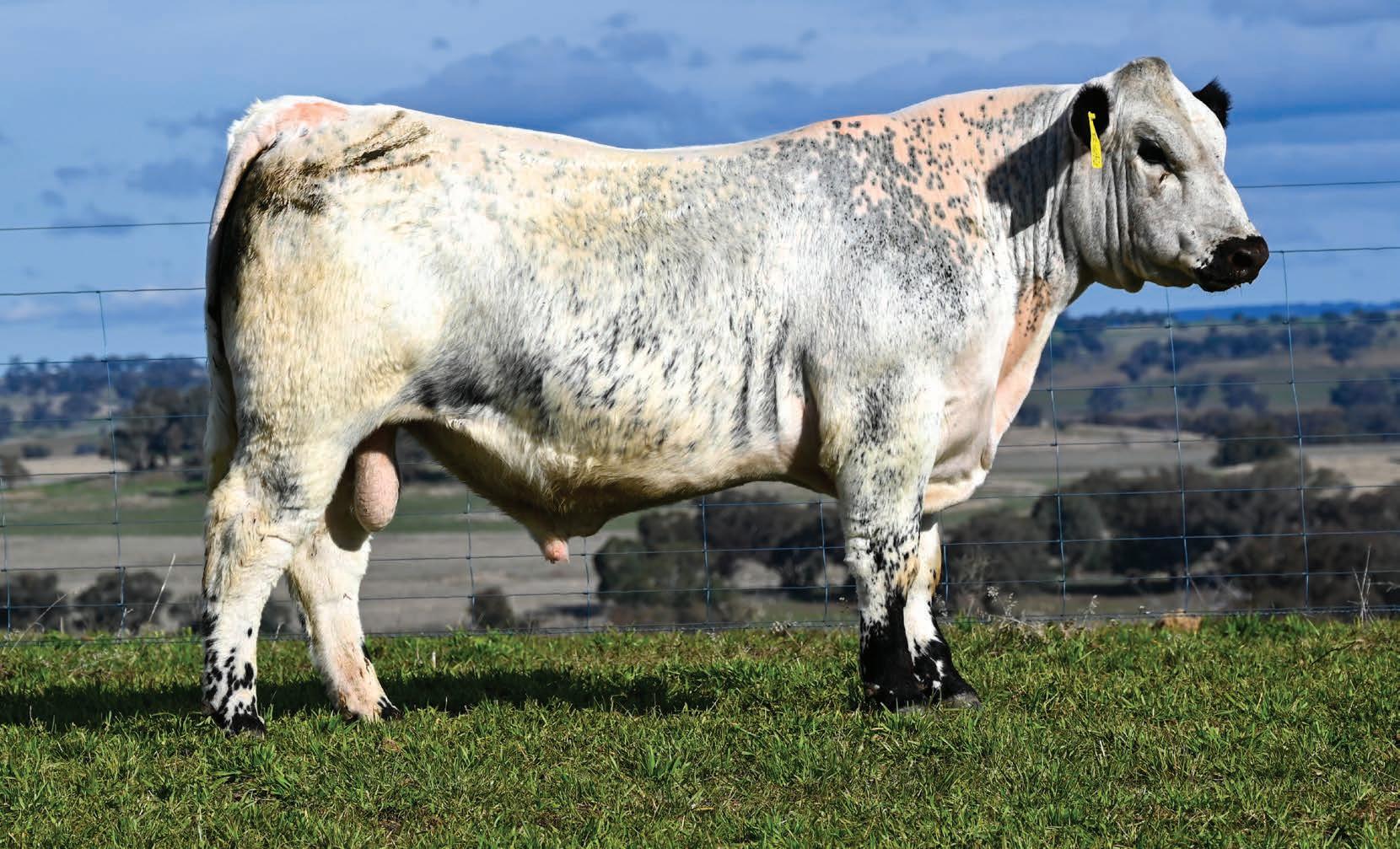
JAD Traveller T110 (AI)
June 2024 Speckle Park Single-Step BREEDPLAN
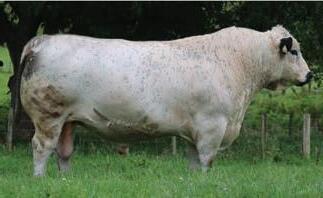
Tuckerbox is an exceptionally well-made bull, who Dick Whale scored a 7 out of 8 for structure. We raised him as a poddy calf, so don’t be fooled by his smaller stature - the genetics to grow are there.
His sire, Maungahina Northern Star, contributed significantly as a sire of our 2022-drop of calves. He goes back to Maungahina Kidmans Cove, who is the leading sire in the Speckle Park breed for intra muscular fat (IMF%).
Sire: Maungahina Northern Star.
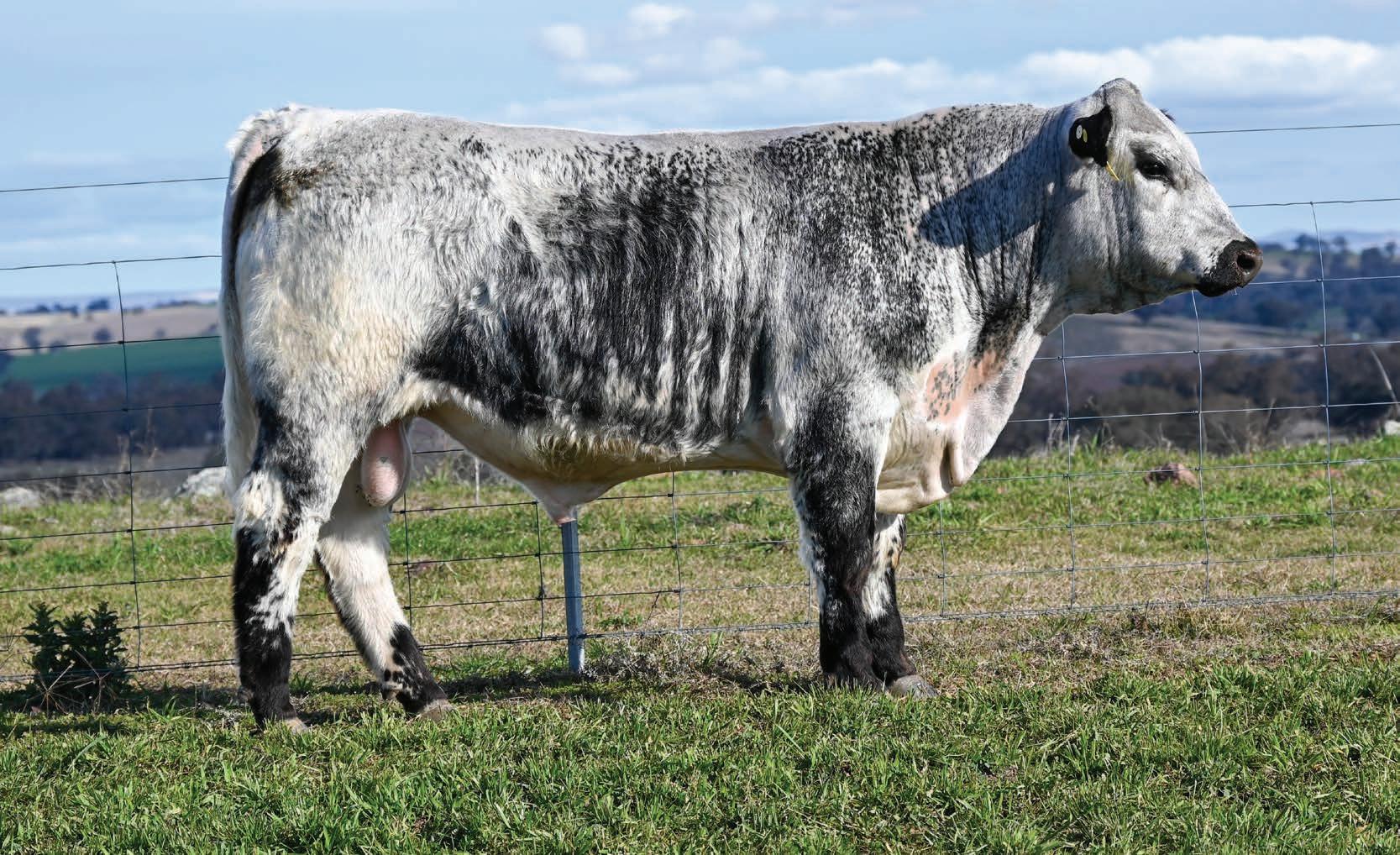
JAD Universal U2
The final two registered Speckle Park bulls in the catalogue are from our Autumn 2023-drop. Like his dam, Universal U2 has a lovely quiet disposition, and he would be suitable for use over heifers.
We purchased his sire, Pokerface P1, as the top-priced bull of the 2020 Southern Success Speckle Park Sale. He has been used as a back-up bull in our stud, and was here used to cover one of our leading 2017-drop donor dams, Ultra N63. This cow is sired by a well-known maternal sire in the breed, Codiak Putnam GNK 61Y.
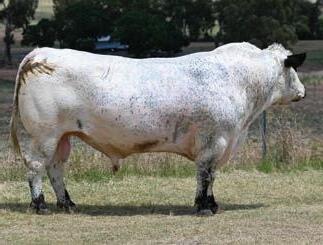
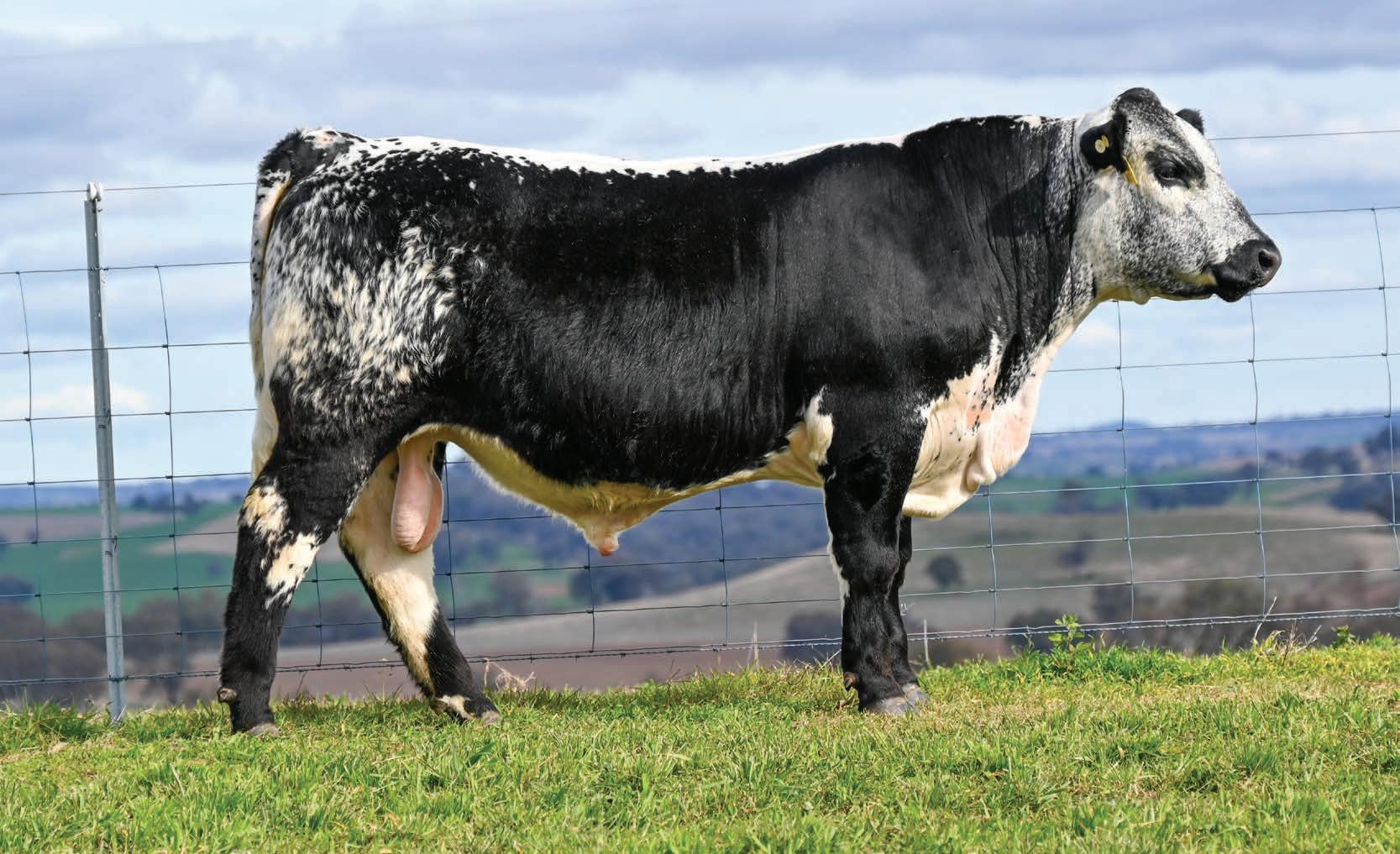
JAD Uncovered U7
The second and final long yearling is a young bull that Dick Whale scored a 7 out of 8 for structure. Uncovered U7 is bred out of Unique Q42, whose full ET-bred sister was the $40,000 top-priced heifer of our 2021 JAD onproperty sale - a then Australasian record.
Uncovered U7 is an eye-catching young bull who has plenty of growing ahead of him. His pedigreee is packed with breed greats, and he is an outstanding bull to finish the run of registered Speckle Park bulls.
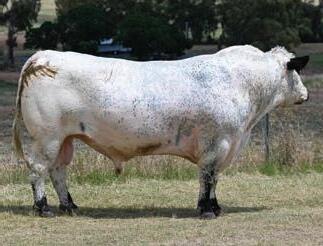
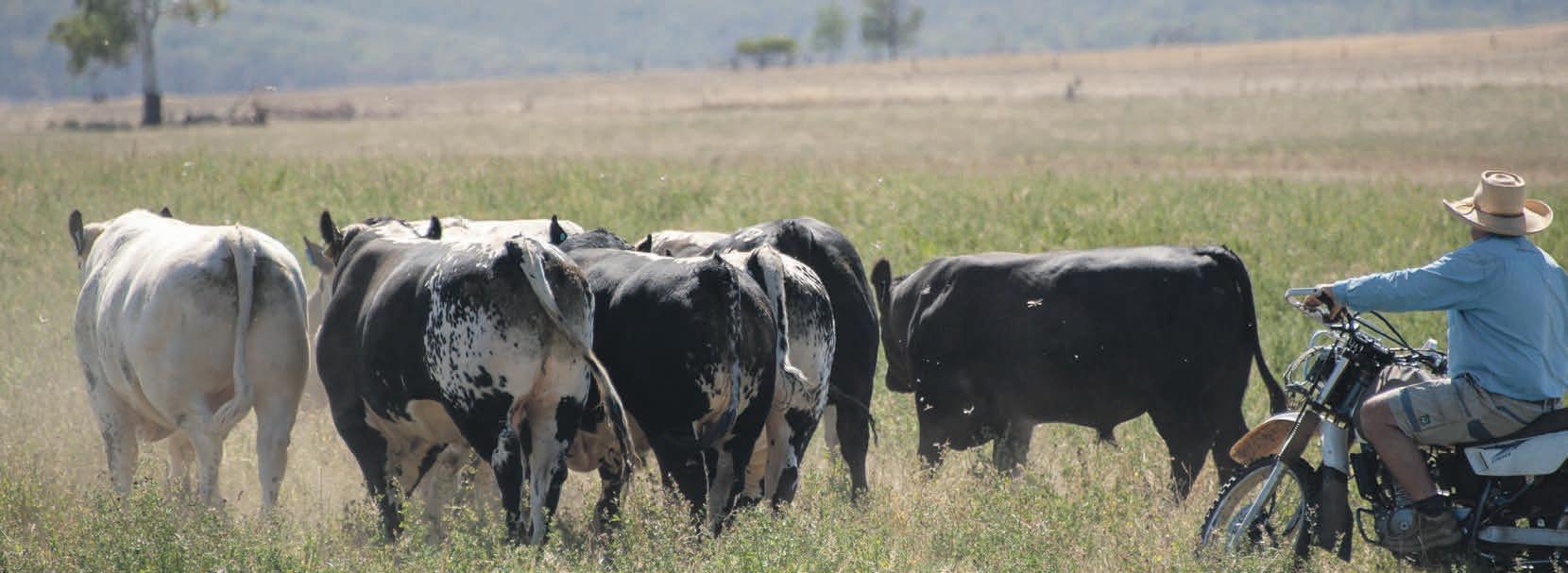
We are excited to continue the development of our
Commercial JAD Speckle Park Family.
This family has been developed alongside our registered purebred family, and offers commercial producers an option for their breeding program to select unregistered commercial Speckle Park bulls that are DNA tested (see full results in the supplementary handbook on sale day), structurally assessed, and backed by the JAD Guarantee. Some bulls in the following pages are just as “purebred” as those in the registered section, but just don’t carry the registration paperwork.
This family’s core foundation breeders were meticulously selected from over 400 F1 Speckle Park/Te Mania Angus females, and we have benchmarked this herd directly
The proof is on display!
alongside our registered cattle as they progress towards fullblood (but unregisterable) status. We look forward to following the progress. Please note that these unregistered commercial bulls have been managed in the same contemporary group as their purebred registered counterparts earlier and later in this catalogue.
NOTE:
75:25 = 75% Speckle Park, 25% Angus (AKA: F2)
88:12 = 87.5% Speckle Park, 12.5% Angus (AKA: F3)
94:6 = 93.8% Speckle Park, 6.2% Angus (AKA: F4, or “purebred” by definition).

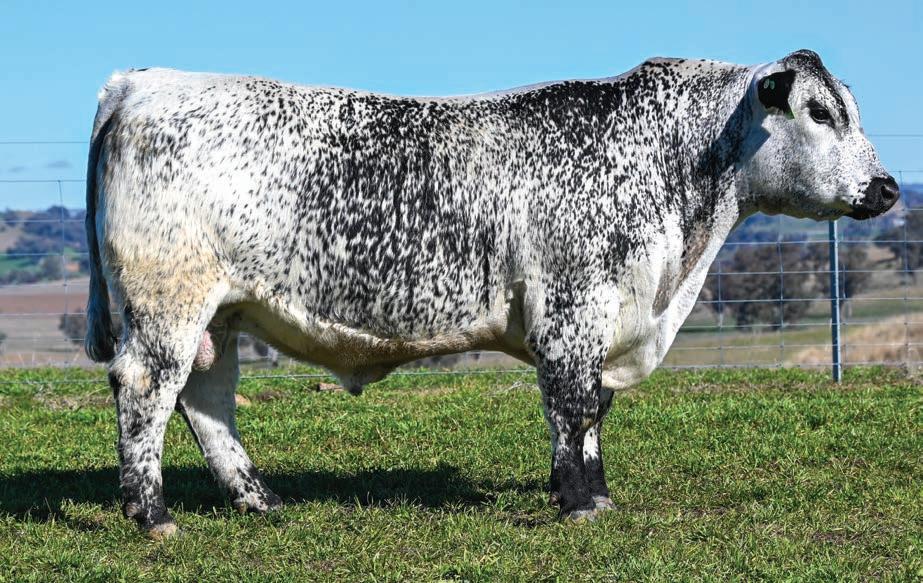
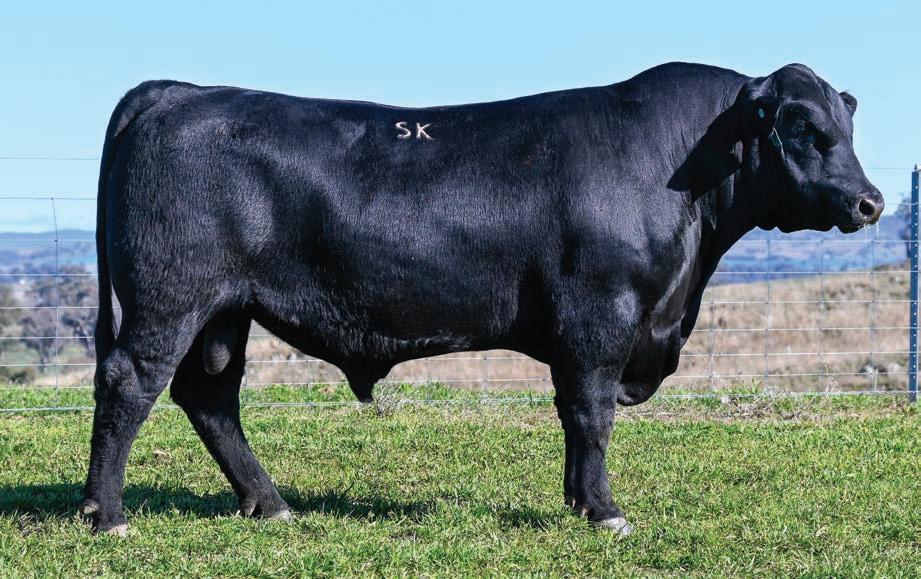
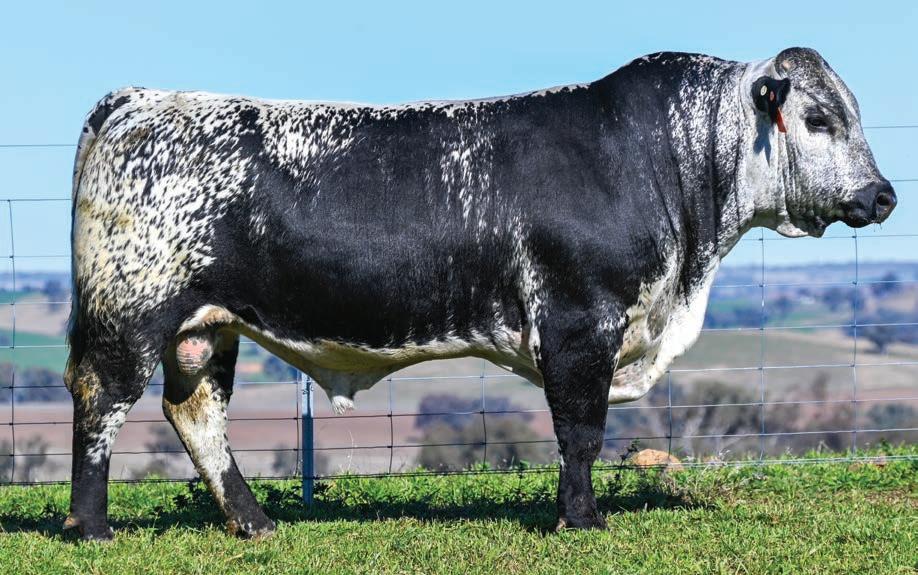
T345 is a larger-framed, slick-coated bull with plenty of muscle to make him a suitable choice for use over
Montezuma M25, has performed exceptionally well within our stud and commercial herds, siring the
Montezuma has been used in AI programs as far north as Mission Beach in Far North QLD, with oustanding progeny out of
and Droughtmaster cows. T345 has a a very small splash of bos indicus way back on his dam’s side.
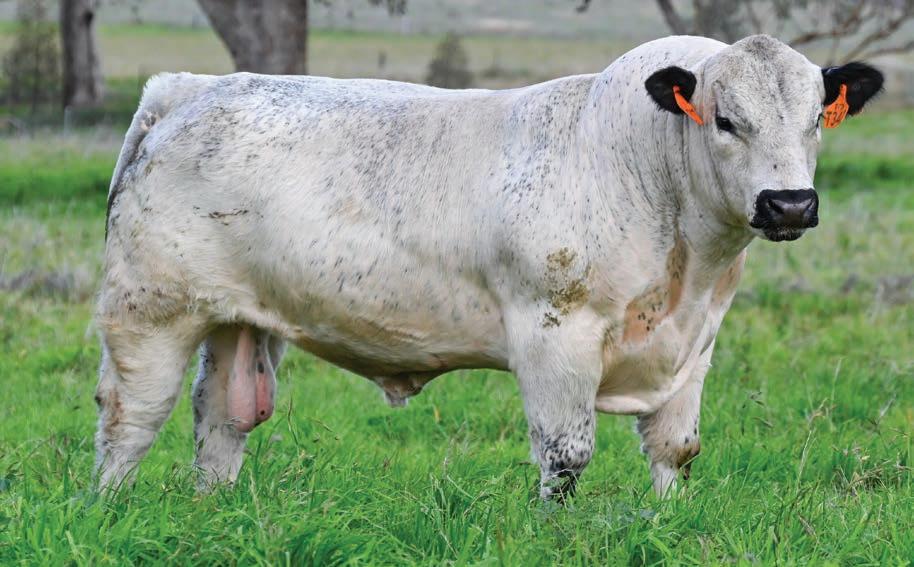
Minnamurra
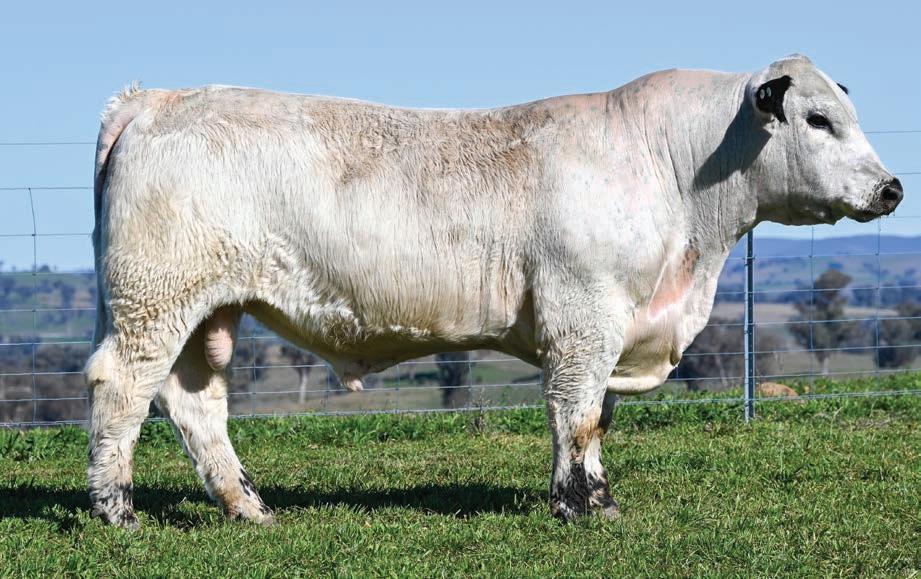
22 JAD Time Square T276
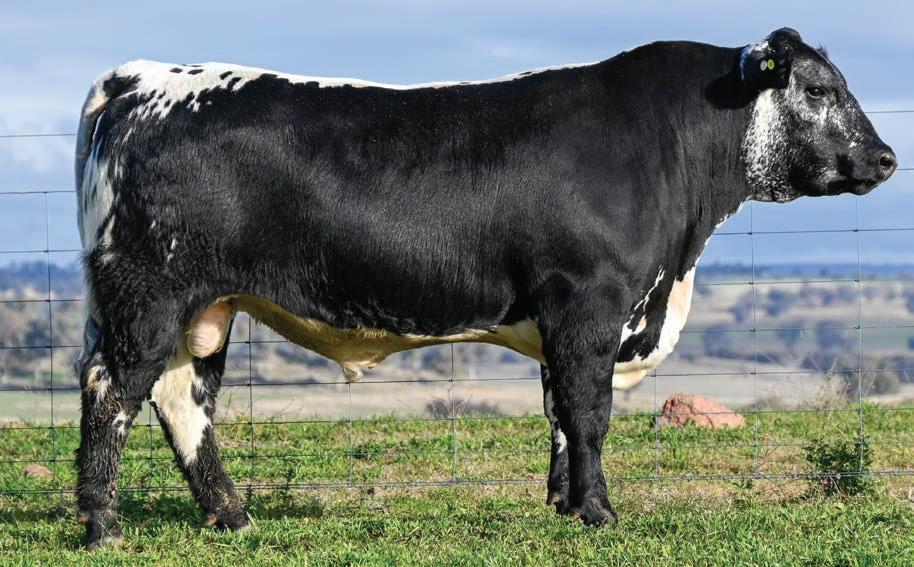
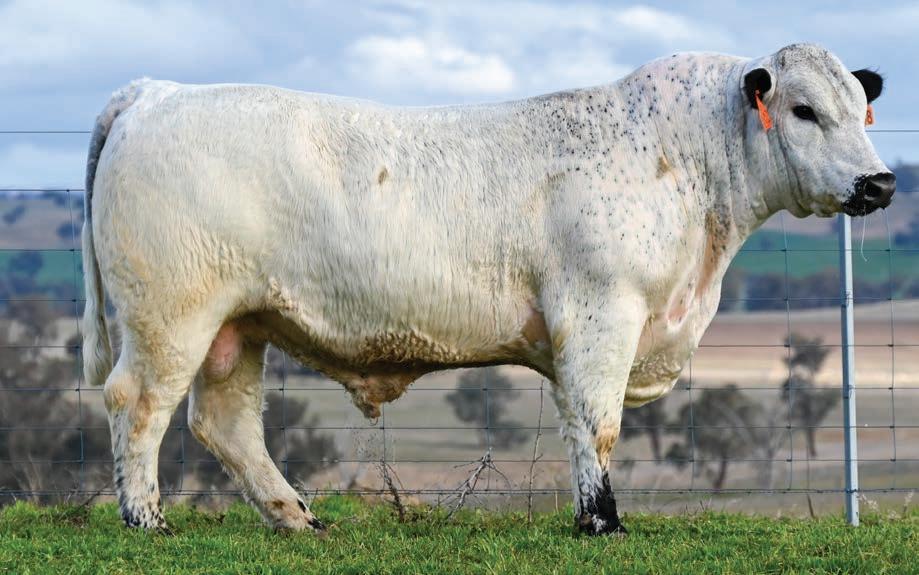
T348 is an ET-bred son of our resident sire, JAD Quistacat Q48, out of a Maungahina Kidmans Cove daughter. His dam, JAD Q254, produced the equal-highest IMF commercial bull in our 2023 sale with her first calf. That bull was sold for $10,000 to a Dululu client. JAD T348 is an
well-muscled bull. He is bull with excellent motion, and is one of the more alert bulls in the catalogue.
24 JAD T323 (75:25)
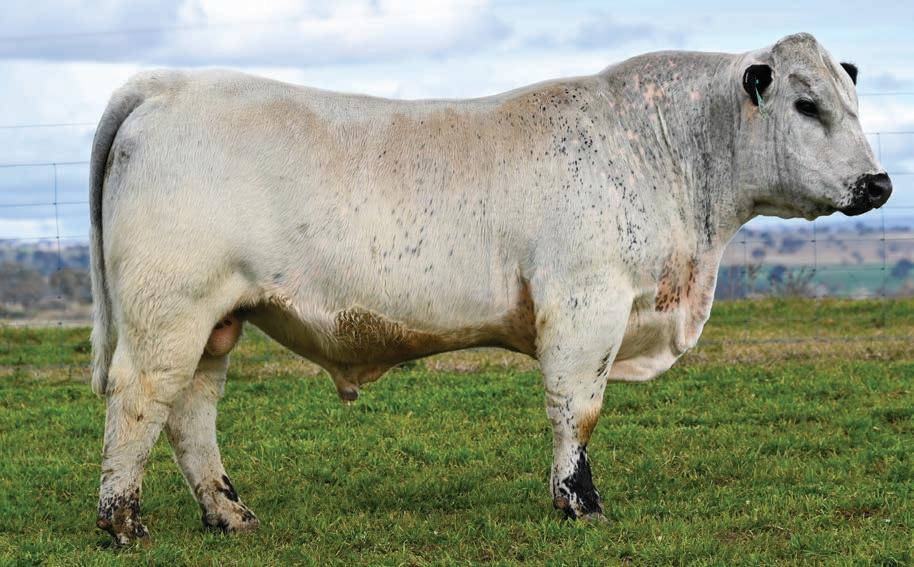
of
Minnamurra Montezuma M25 (MPC M25) (Leopard)
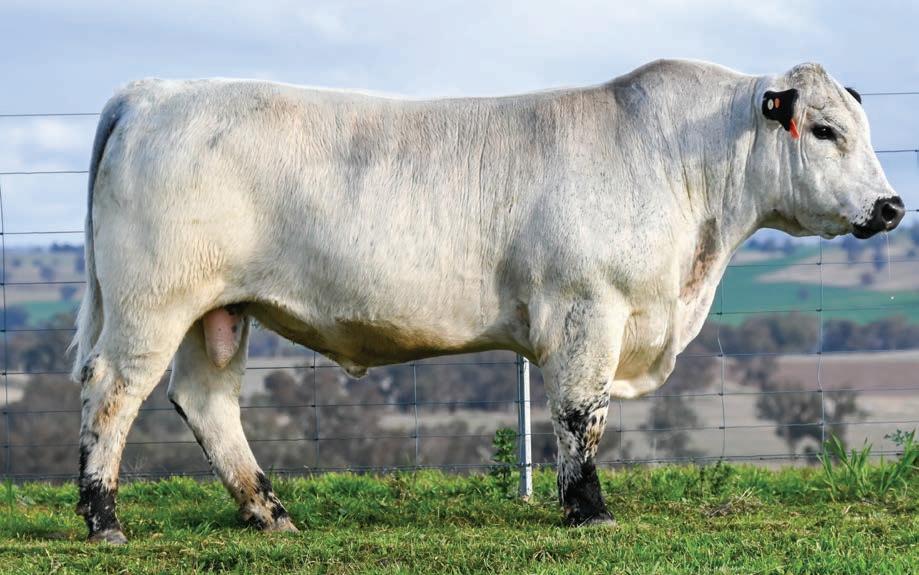


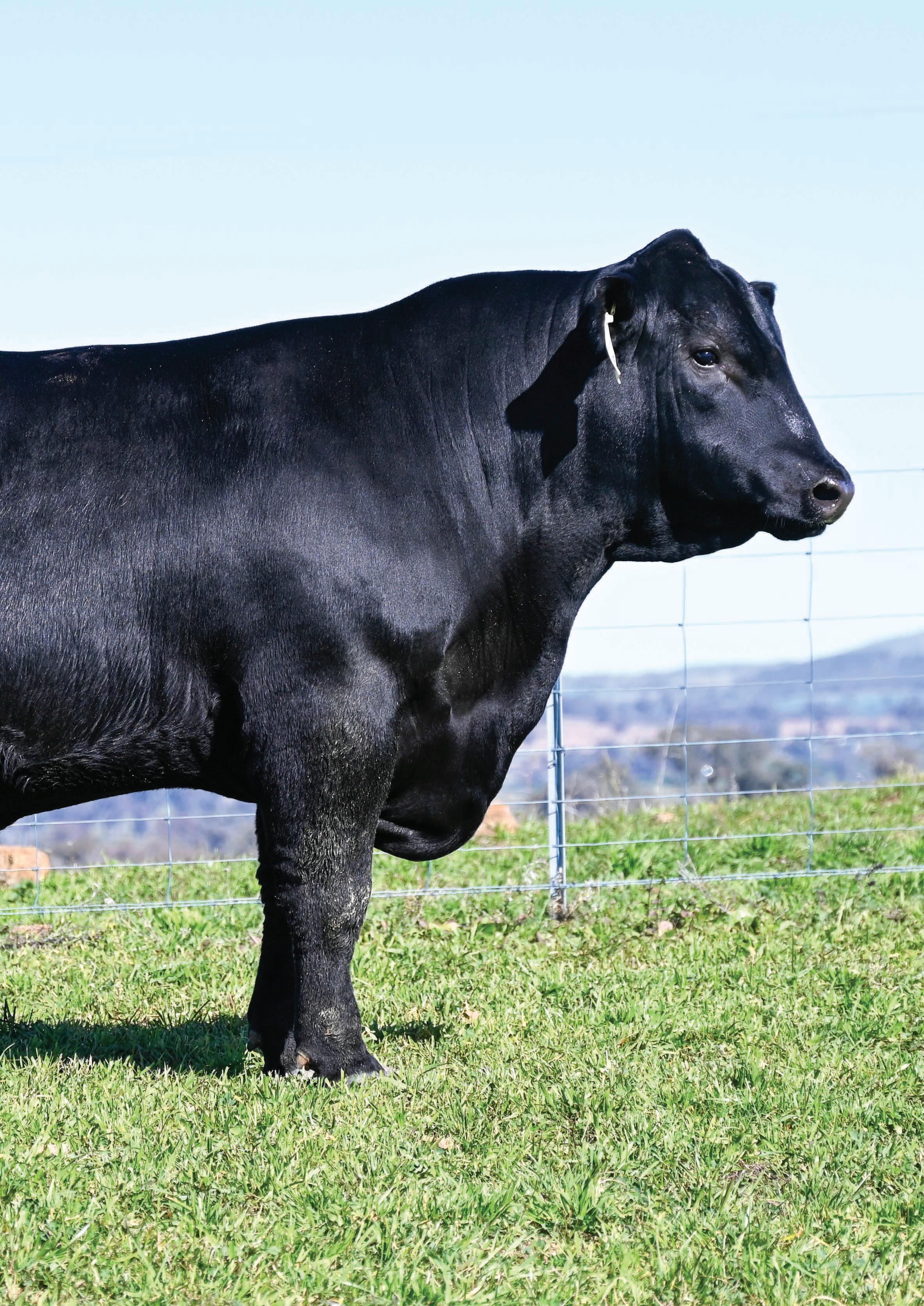
JAD HBR-REGISTERED ANGUS BULLS
Understanding the TransTasman
Angus Cattle Evaluation (TACE)
What is the TransTasman Angus Cattle Evaluation?
The TransTasman Angus Cattle Evaluation is the genetic evaluation program adopted by Angus Australia for Angus and Angus influenced beef cattle. The TransTasman Angus Cattle Evaluation uses Best Linear Unbiased Prediction (BLUP) technology to produce Estimated Breeding Values (EBVs) of recorded cattle for a range of important production traits (e.g. weight, carcase, fertility).
The TransTasman Angus Cattle Evaluation is an international genetic evaluation and includes pedigree, performance and genomic information from the Angus Australia and Angus New Zealand databases, along with selected information from the American and Canadian Angus Associations.
The TransTasman Angus Cattle Evaluation utilises a range of genetic evaluation software, including the internationally recognised BLUPF90 family of programs, and BREEDPLAN® beef genetic evaluation analytical software, as developed by the Animal Genetics and Breeding Unit (AGBU), a joint institute of NSW Agriculture and the University of New England, and Meat and Livestock Australia Limited (MLA).
What is an EBV?
An animal’s breeding value can be defined as its genetic merit for each trait. While it is not possible to determine an animal’s true breeding value, it is possible to estimate it. These estimates of an animal’s true breeding value are called EBVs (Estimated Breeding Values).
EBVs are expressed as the difference between an individual animal’s genetics and a historical genetic level (i.e. group of animals) within the TACE genetic evaluation, and are reported in the units in which the measurements are taken.
Using EBVs to Compare the Genetics of Two Animals
TACE EBVs can be used to estimate the expected difference in the genetics of two animals, with the expected difference equating to half the difference in the EBVs of the animals, all other things being equal (e.g. they are joined to the same animal/s).
For example, a bull with a 200 Day Growth EBV of +60 would be expected to produce progeny that are, on average, 10 kg heavier at 200 days of age than a bull with a 200 Day Growth EBV of +40 kg (i.e. 20
kg difference between the sire’s EBVs, then halved as the sire only contributes half the genetics).
Or similarly, a bull with an IMF EBV of +3.0 would be expected to produce progeny with on average, 1% more intramuscular fat in a 400 kg carcase than a bull with a IMF EBV of +1.0 (i.e. 2% difference between the sire’s EBVs, then halved as the sire only contributes half the genetics).
Using EBVs to Benchmark an Animal’s Genetics with the Breed
EBVs can also be used to benchmark an animal’s genetics relative to the genetics of other Angus or Angus infused animals recorded with Angus Australia. To benchmark an animal’s genetics relative to other Angus animals, an animal’s EBV can be compared to the EBV reference tables, which provide:
• the breed average EBV
• the percentile bands table
The current breed average EBV is listed on the bottom of each page in this publication, while the current EBV reference tables are included at the end of these introductory notes.
For easy reference, the percentile band in which an animal’s EBV ranks is also published in association with the EBV.
Considering Accuracy
An accuracy value is published with each EBV, and is usually displayed as a percentage value immediately below the EBV.
The accuracy value provides an indication of the reliability of the EBV in estimating the animal’s genetics (or true breeding value), and is an indication of the amount of information that has been used in the calculation of the EBV.
EBVs with accuracy values below 50% should be considered as preliminary or of low accuracy, 50-74% as of medium accuracy, 75-90% of medium to high accuracy, and 90% or greater as high accuracy.
Description of TACE EBVs
EBVs are calculated for a range of traits within TACE, covering calving ease, growth, fertility, maternal performance, carcase merit, feed efficiency and structural soundness. A description of each EBV included in this publication is provided on the following page.
CEDir %
UNDERSTANDING ESTIMATED BREEDING VALUES (EBVS)
Genetic differences in the ability of a sire’s calves to be born unassisted from 2 year old heifers.
CEDtrs %
GL days
BW kg
200 Day kg
400 Day kg
600 Day kg
MCW kg
Milk kg
DtC days
Genetic differences in the ability of a sire’s daughters to calve unassisted at 2 years of age.
Genetic differences between animals in the length of time from the date of conception to the birth of the calf.
Genetic differences between animals in calf weight at birth.
Genetic differences between animals in live weight at 200 days of age due to genetics for growth.
Genetic differences between animals in live weight at 400 days of age.
Genetic differences between animals in live weight at 600 days of age.
Genetic differences between animals in live weight of cows at 5 years of age.
Genetic differences between animals in live weight at 200 days of age due to the maternal contribution of its dam.
Genetic differences between animals in the time from the start of the joining period (i.e. when the female is introduced to a bull) until subsequent calving.
Higher EBVs indicate fewer calving difficulties in 2 year old heifers.
Higher EBVs indicate fewer calving difficulties in 2 year old heifers.
Lower EBVs indicate shorter gestation length.
Lower EBVs indicate lighter birth weight.
Higher EBVs indicate heavier live weight.
Higher EBVs indicate heavier live weight.
Higher EBVs indicate heavier live weight.
Higher EBVs indicate heavier mature weight.
Higher EBVs indicate heavier live weight.
Lower EBVs indicate shorter time to calving.
SS cm Genetic differences between animals in scrotal circumference at 400 days of age. Higher EBVs indicate larger scrotal circumference.
CWT kg
EMA cm2
Rib Fat mm
P8 Fat mm
Genetic differences between animals in hot standard carcase weight at 750 days of age.
Genetic differences between animals in eye muscle area at the 12/13th rib site in a 400 kg carcase.
Higher EBVs indicate heavier carcase weight.
Higher EBVs indicate larger eye muscle area.
Genetic differences between animals in fat depth at the 12/13th rib site in a 400 kg carcase. Higher EBVs indicate more fat.
Genetic differences between animals in fat depth at the P8 rump site in a 400 kg carcase.
Higher EBVs indicate more fat.
RBY % Genetic differences between animals in boned out saleable meat from a 400 kg carcase. Higher EBVs indicate higher yield.
IMF % Genetic differences between animals in intramuscular fat (marbling) at the 12/13th rib site in a 400 kg carcase.
NFI-F kg/day
Genetic differences between animals in feed intake at a standard weight and rate of weight gain when animals are in a feedlot finishing phase.
Doc % Genetic differences between animals in temperament.
Claw
Set score Genetic differences in claw set structure (shape and evenness of claws).
Foot Angle score Genetic differences in foot angle (strength of pastern, depth of heel).
Leg
$A $
$A-L $
Genetic differences in rear leg structure when viewed from the side (angle at front of the hock).
Genetic differences between animals in net profitability per cow joined in a typical commercial self replacing herd using Angus bulls. This selection index is not specific to a particular market end-point, but identifies animals that will improve overall net profitability in the majority of commercial, self replacing, grass and grain finishing beef production systems.
Genetic differences between animals in net profitability per cow joined in a typical commercial self replacing herd using Angus bulls. This selection index is not specific to a particular market end-point, but identifies animals that will improve overall net profitability in the majority of commercial, self replacing, grass and grain finishing beef production systems.
The $A-L index is similar to the $A index but is modelled on a production system where feed is surplus to requirements for the majority of the year, or the cost of supplying additional feed when animal feed requirements increase is low. While the $A aims to maintain mature cow weight, the $A-L does not aim to limit the increase in mature cow weight as there is minimal cost incurred if the feed maintenance requirements of the female breeding herd increase as a result of selection decisions.
Higher EBVs indicate more intramuscular fat.
Lower EBVs indicate more feed efficiency.
Higher EBVs indicate better temperament.
Lower EBVs indicate a lower score.
Lower EBVs indicate a lower score.
Lower EBVs indicate a lower score.
Higher selection indexes indicate greater profitability.
Higher selection indexes indicate greater profitability.
Selection Indexes
$D $
UNDERSTANDING ESTIMATED BREEDING VALUES (EBVS)
Genetic differences between animals in net profitability per cow joined in a commercial self replacing herd targeting the domestic supermarket trade. Steers are either finished using pasture, pasture supplemented by grain, or grain (e.g. 50 -70 days) with steers assumed to be slaughtered at 510kg live weight (280kg carcase weight with 12mm P8 fat depth) at 16 months of age.
Genetic differences between animals in net profitability per cow joined in a commercial self replacing herd targeting the domestic supermarket trade. Steers are either finished using pasture, pasture supplemented by grain, or grain (e.g. 50 -70 days) with steers assumed to be slaughtered at 510kg live weight (280kg carcase weight with 12mm P8 fat depth) at 16 months of age.
Higher selection indexes indicate greater profitability.
$D-L $
$GN $
The $D-L index is similar to the $D index but is modelled on a production system where feed is surplus to requirements for the majority of the year, or the cost of supplying additional feed when animal feed requirements increase is low.
While the $D aims to maintain mature cow weight, the $D-L does not aim to limit the increase in mature cow weight as there is minimal cost incurred if the feed maintenance requirements of the female breeding herd increase as a result of selection decisions.
Genetic differences between animals in net profitability per cow joined in a commercial self replacing herd targeting pasture grown steers with a 250 day feedlot finishing period for the grain fed high quality, highly marbled markets. Steers are assumed to be slaughtered at 800 kg live weight (455 kg carcase weight with 30 mm P8 fat depth) at 24 months of age, with a significant premium for steers that exhibit superior marbling.
Genetic differences between animals in net profitability per cow joined in a commercial self replacing herd targeting pasture grown steers with a 250 day feedlot finishing period for the grain fed high quality, highly marbled markets. Steers are assumed to be slaughtered at 800 kg live weight (455 kg carcase weight with 30 mm P8 fat depth) at 24 months of age, with a significant premium for steers that exhibit superior marbling.
Higher selection indexes indicate greater profitability.
$GN-L $
The $GN-L index is similar to the $GN index but is modelled on a production system where feed is surplus to requirements for the majority of the year, or the cost of supplying additional feed when animal feed requirements increase is low.
While the $GN aims to maintain mature cow weight, the $GN-L does not aim to limit the increase in mature cow weight as there is minimal cost incurred if the feed maintenance requirements of the female breeding herd increase as a result of selection decisions.
Higher selection indexes indicate greater profitability.
Higher selection indexes indicate greater profitability.
$GS $
$GS-L $
Genetic differences between animals in net profitability per cow joined in a commercial self replacing herd targeting pasture finished steers. Steers are assumed to be slaughtered at 650 kg live weight (350 kg carcase weight with 12 mm P8 fat depth) at 22 months of age. Emphasis has been placed on eating quality and tenderness to favour animals that are suited to MSA requirements.
Genetic differences between animals in net profitability per cow joined in a commercial self replacing herd targeting pasture finished steers. Steers are assumed to be slaughtered at 650 kg live weight (350 kg carcase weight with 12 mm P8 fat depth) at 22 months of age. Emphasis has been placed on eating quality and tenderness to favour animals that are suited to MSA requirements.
The $GS-L index is similar to the $GS index but is modelled on a production system where feed is surplus to requirements for the majority of the year, or the cost of supplying additional feed when animal feed requirements increase is low.
While the $GS aims to maintain mature cow weight, the $GS-L does not aim to limit the increase in mature cow weight as there is minimal cost incurred if the feed maintenance requirements of the female breeding herd increase as a result of selection decisions.
Higher selection indexes indicate greater profitability.
$PRO $
$T $
Genetic differences between animals in net profitability per cow joined in a commercial self replacing herd based in New Zealand that targets the production of grass finished steers for the AngusPure programme. Steers are assumed marketed at approximately 530 kg live weight (290 kg carcase weight with 10 mm P8 fat depth) at 20 months of age, with a significant premium for steers that exhibit superior marbling.
Genetic difference between animals in net profitability per cow joined in a situation where Angus bulls are being used as a terminal sire over mature breeding females and all progeny, both male and female, are slaughtered. The Angus Terminal Sire Index focusses on increasing growth, carcase yield and eating quality. Daughters are not retained for breeding and therefore no emphasis is given to female fertility or maternal traits.
Higher selection indexes indicate greater profitability.
Higher selection indexes indicate greater profitability.
Higher selection indexes indicate greater profitability.
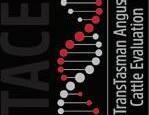
TransTasman Angus Cattle Evaluation
PERCENTILE BANDS TABLE
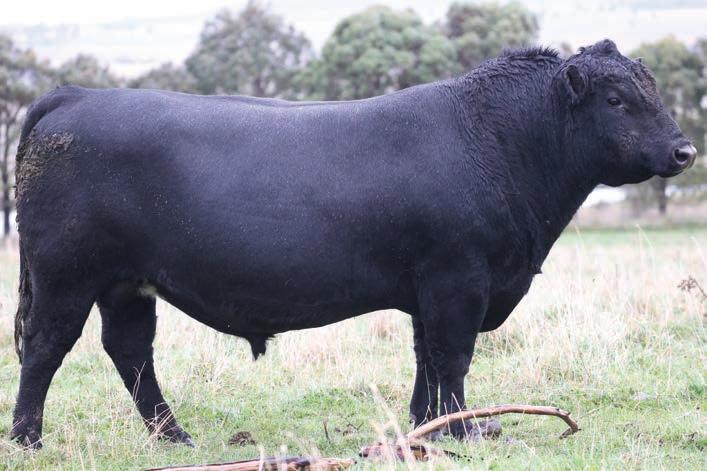
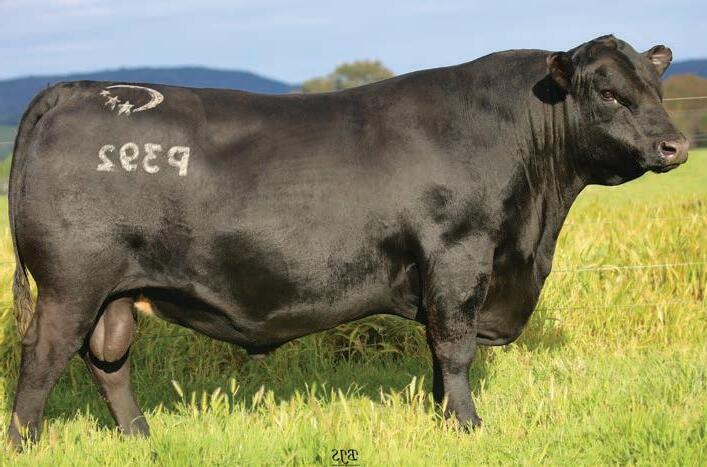
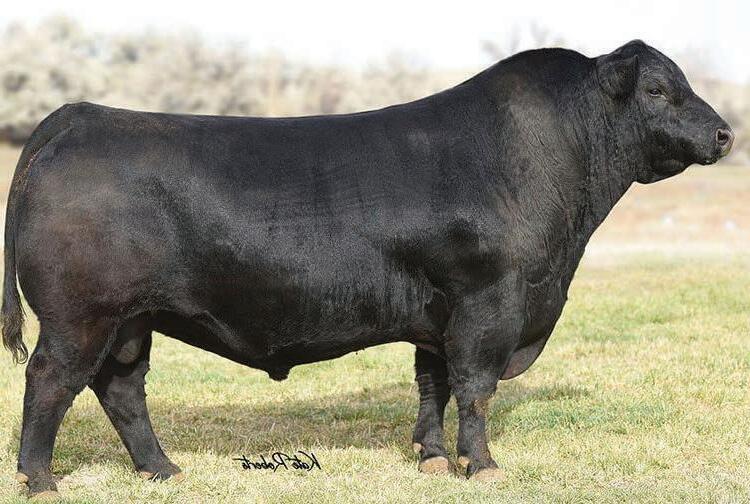
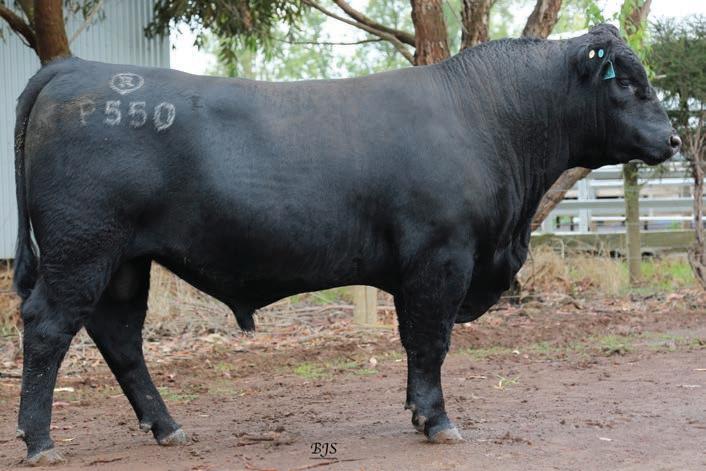
Wattletop Q41
Wattletop Q41 has several sons in this catalogue, with a most successful flush with him to our original Premier D5 Dream H45 cow. Wattletop Q41 is in the top 7% of the breed for birthweight and couples this with excellent EMA and IMF.
Described as Beast Mode’s “best son”, Plantation was a standout at Clunie Range as a calf, and he is backed by the dominant Naomi maternal line. He is in the top 4% of the breed for 200-day and 400-day weight, and top 1% for scrotal size. We used Exclusive extensively in our 2021 drop. He is a moderateframed, high performing 316 son, with excellent capacity and mobility, great muscle expression and doing ability.
Prospect has come to be known as a great sire for improving foot structure, fat cover and fertility. He was the $38,000 top-priced bull of the Autumn 2020 Rennylea bull sale. He is in the top 1% of the breed for rib and rump fats and top 10% for IMF.

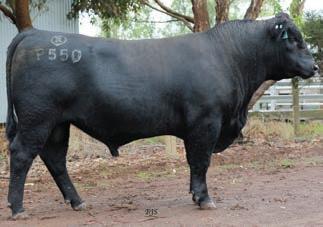
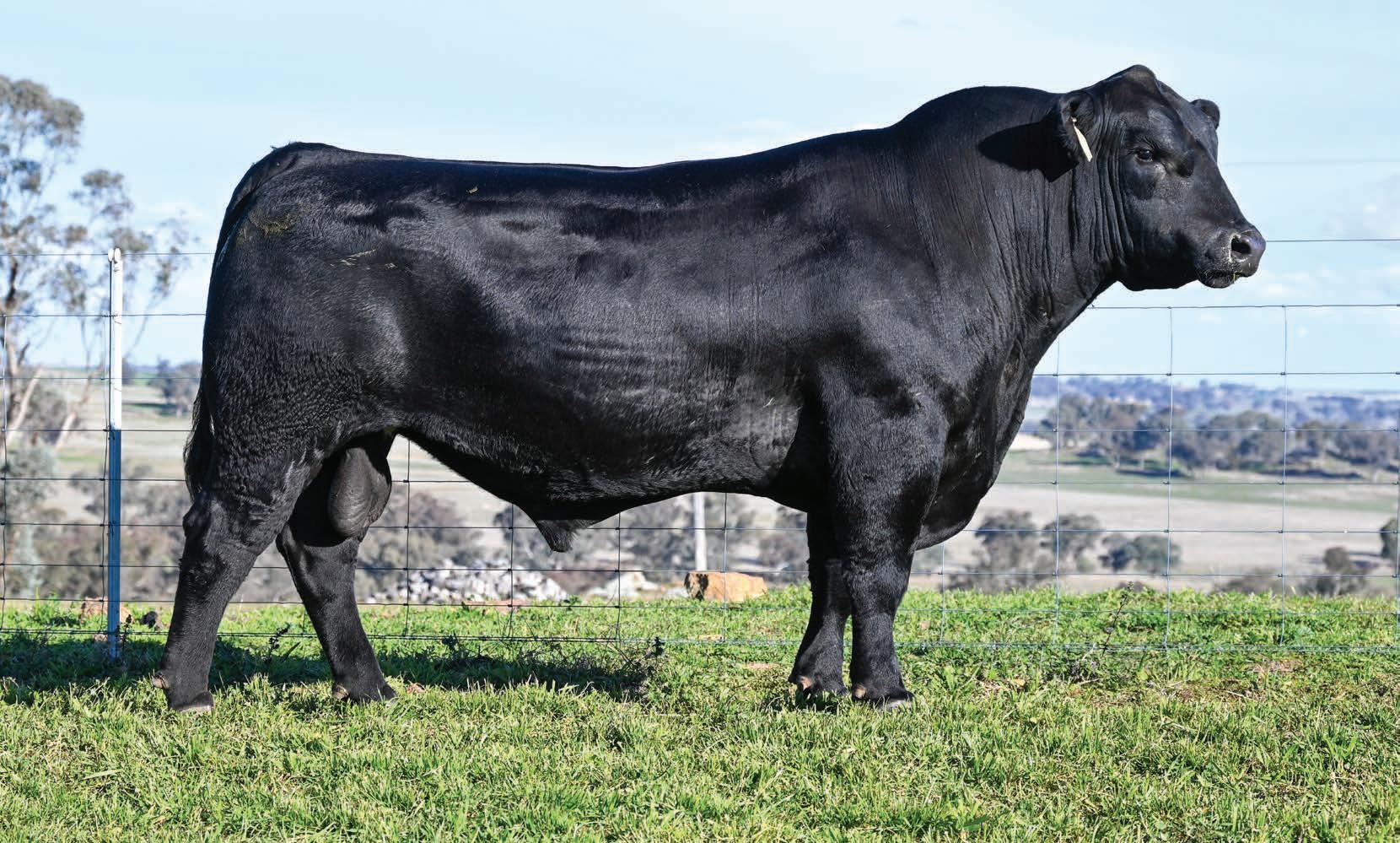
JADA Skeeter S175 PV

We proudly kick off our offering of HBR-registered Angus bulls with a three-year-old who was retained for use within-herd for a season.
Skeeter S175 is out of one of our favourite foundation cows, purchased at the dispersal of the Geard family’s Premier Angus Stud in September 2020. Lowan P128 is a powerful, smooth-skinned female. Skeeter S175 features outstanding structure and carcase EBVs, with scrotal size in the top 10% of the breed.
Sire: Rennylea Prospect P550.
JADA Skeeter S175 (DIC21S175)
Rennylea Prospect
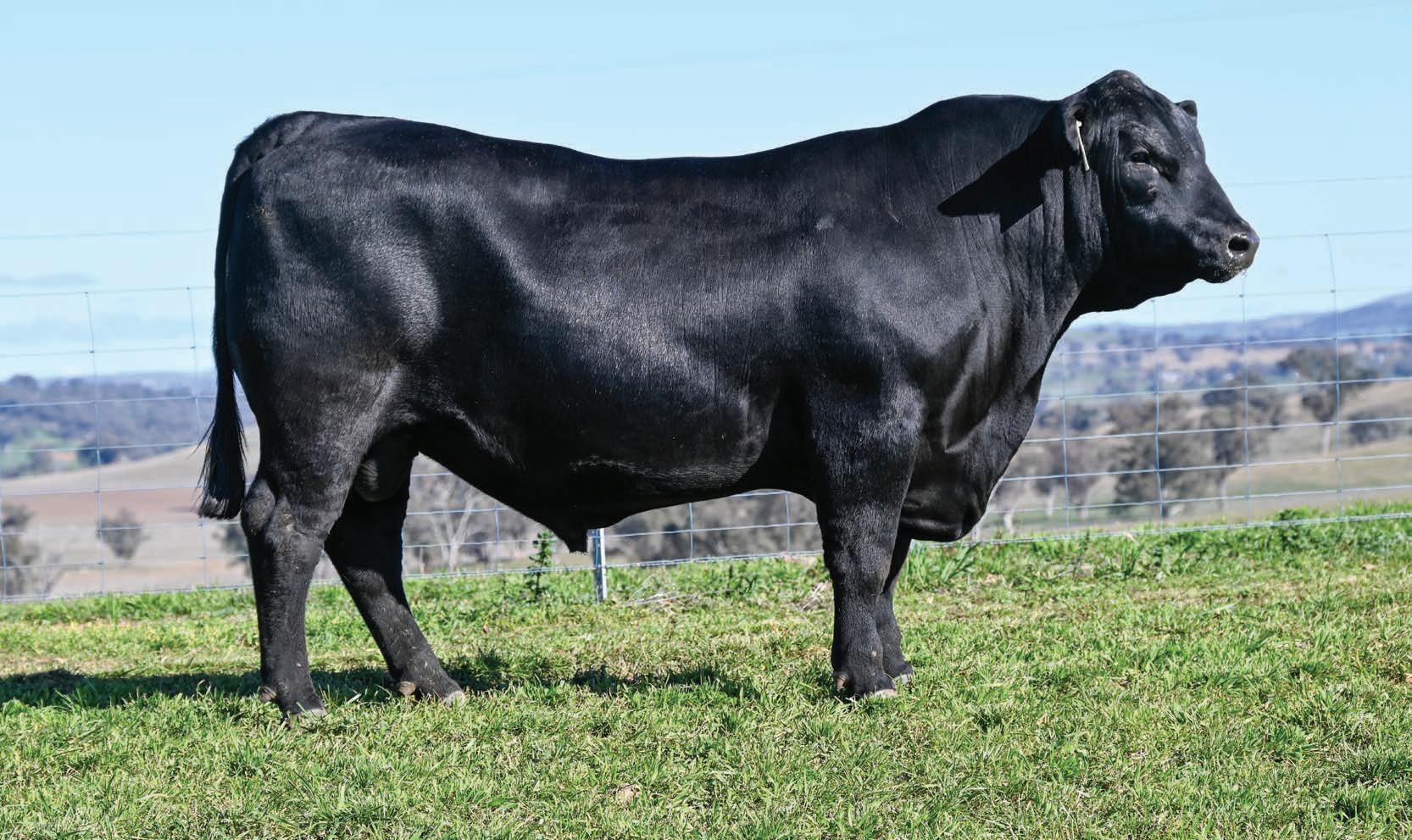
JADA Tomahawk T518PV


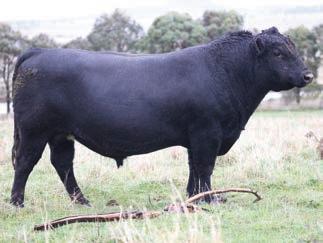
Tomahawk T518 is the first of the rising two-year-old Angus bulls to be offered, and he is an eye-catching one for the task!
He is also the first of 10 full ET-bred brothers to be offered in the following pages from the H45/Wattletop Q41 mating. This pairing worked a treat, as you will see when looking through the subsequent pages. H45 is without doubt the best stud Angus female we have purchased to date. This bull, Tomahawk T518, is being used lightly to back up a stud AI program prior to sale.
Structural
Sire: Wattletop Q41.
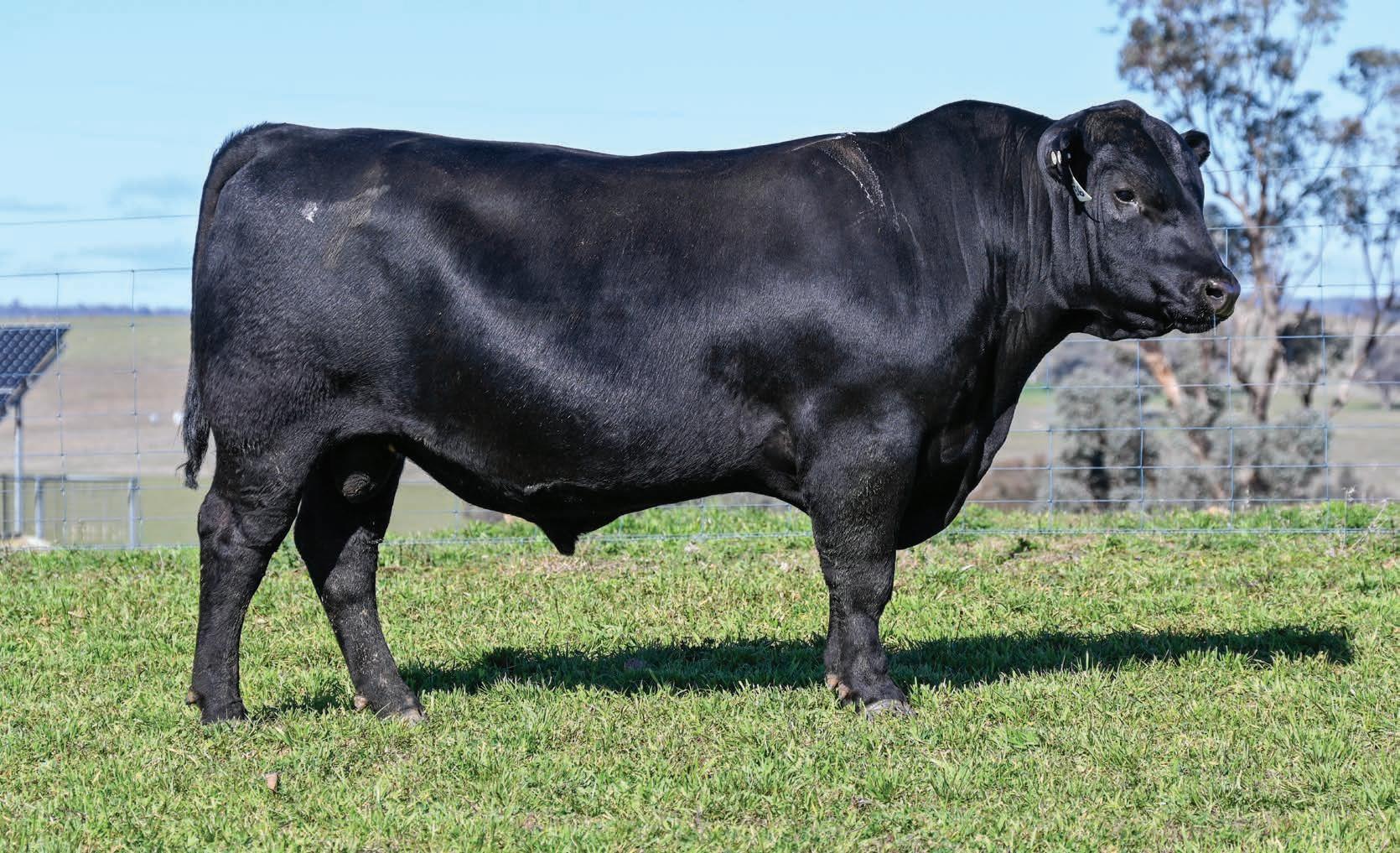


Another well-structured son of Wattletop Q41, who sold for $30,000 to Glenavon Angus. Top Gun T516 is a low birthweight option.
The “Dream” cow family is popular in Angus seedstock circles, and our Dream H45 cow has been a gem for us. We lost her to injury last year - at the ripe age of 13 years old. She was an exceptional phenotype female with presence, excellent capacity and length. The most important part is how well she bred on. We are grateful to have outstanding daughters coming through.
Structural
Sire: Wattletop Q41.
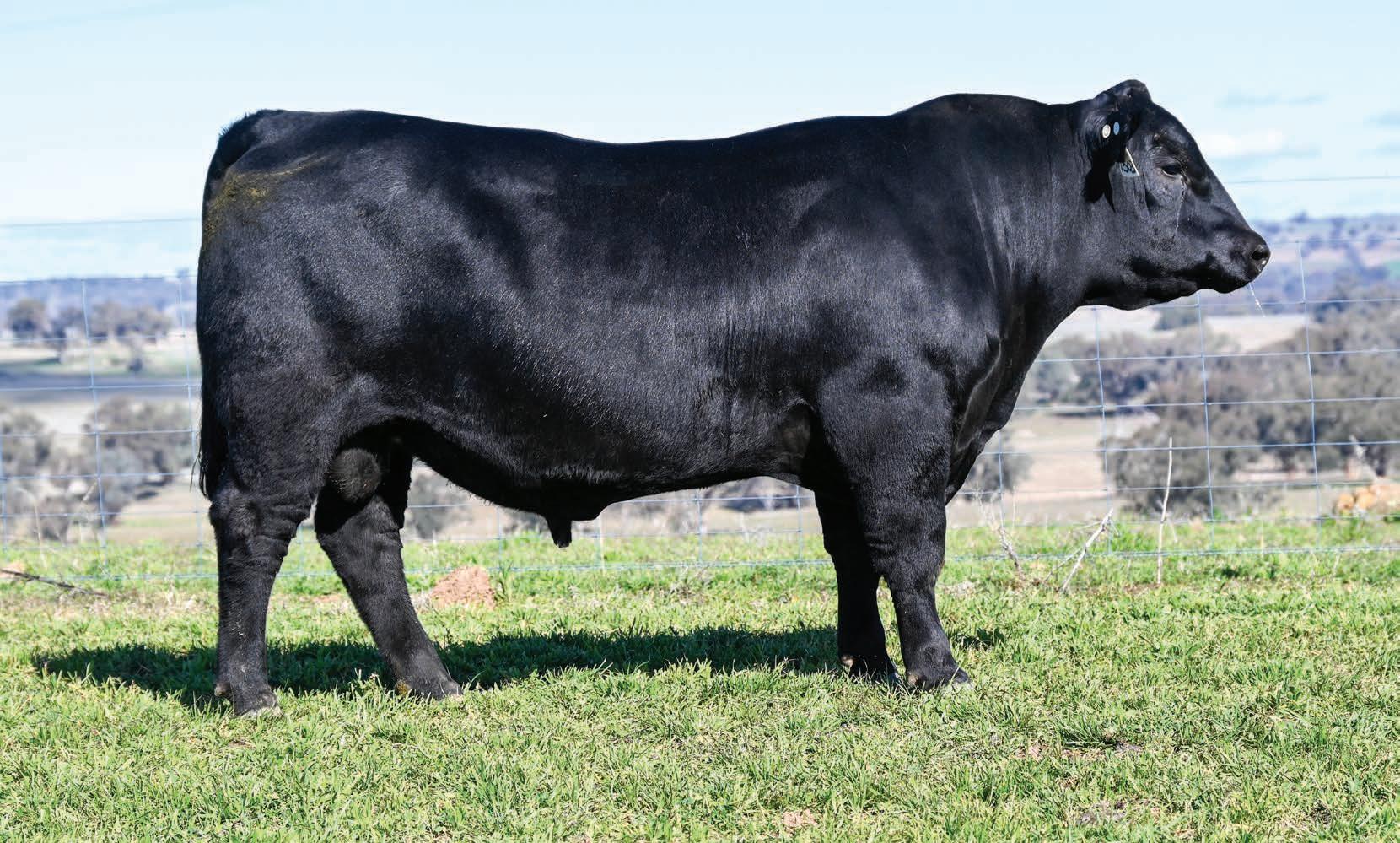
JADA Titanium T503PV

Titanium T503 is a bull with plenty of natural thickness, making him an excellent candidate for use over bos indicus cows to produce earlier-maturing calves with plenty of carcase.
Titanium T503’s paternal grandsire, Lawsons Momentous M518 was the high selling bull for Lawsons Angus in 2018, featuring excellent structure, with calving ease and outstanding carcase. Titanium T503 is in the top 21% of the breed for Scrotal Size, and top 25% for Days to Calving. He is also a breed leader for structural EBVs.
Purchaser:

Sire: Wattletop Q41.
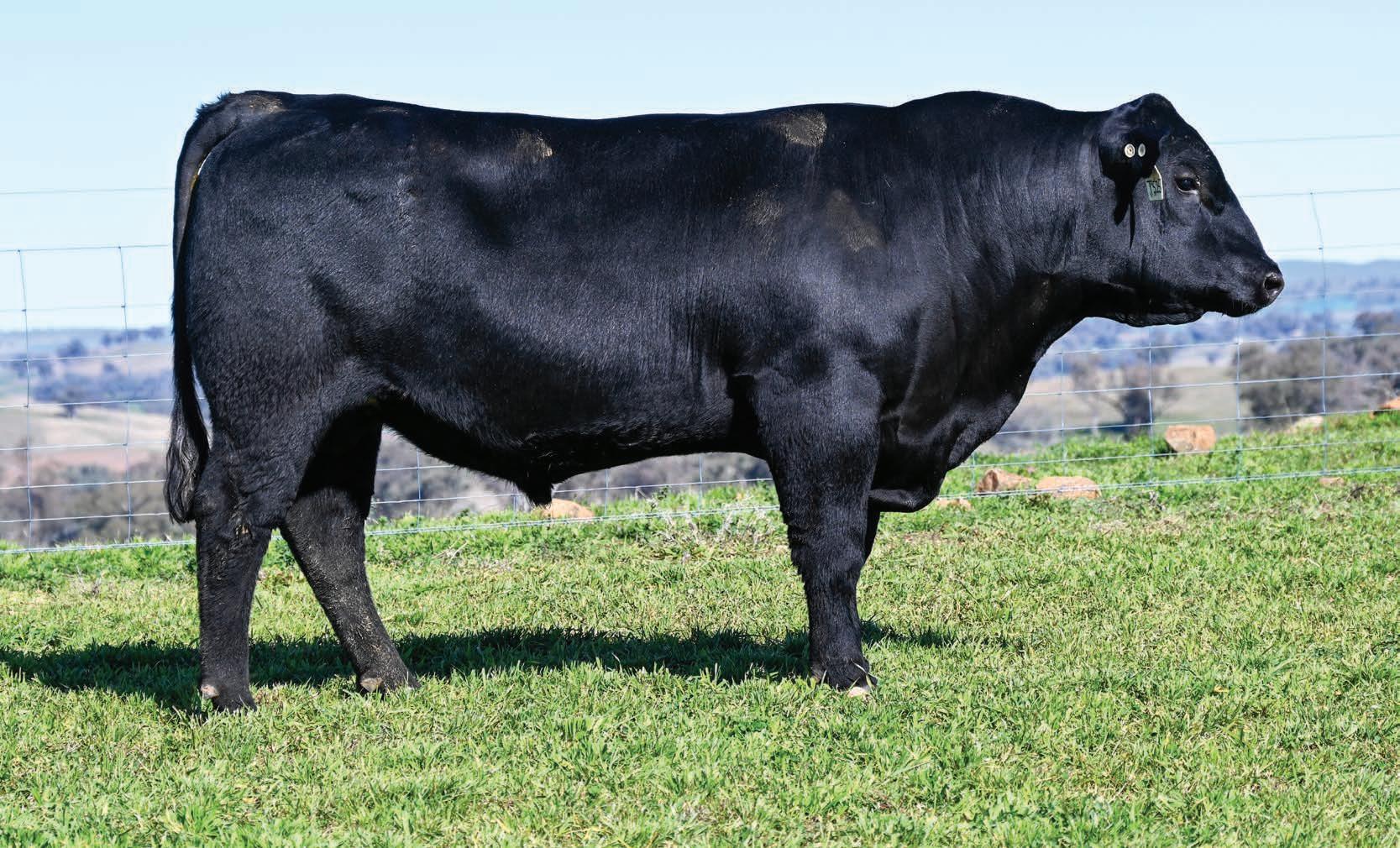
JADA Tequila T525 PV
ID: DIC22T525 | DOB: 19/9/2022 |

Tequila T525 is another ET-bred bull from our flush of Premier D5 Dream H45 to Wattletop Q41. He is in the top 26% of the breed for intra muscular fat (IMF%).
Like all of the Angus bulls in this catalogue, Tequila T525 is fully DNA parent verified to both sire and dam, and has been DNA tested free of all genetic conditions tested in the Angus breed.

JADA Tequila T525 (DIC22T525)
Sire: Wattletop Q41.
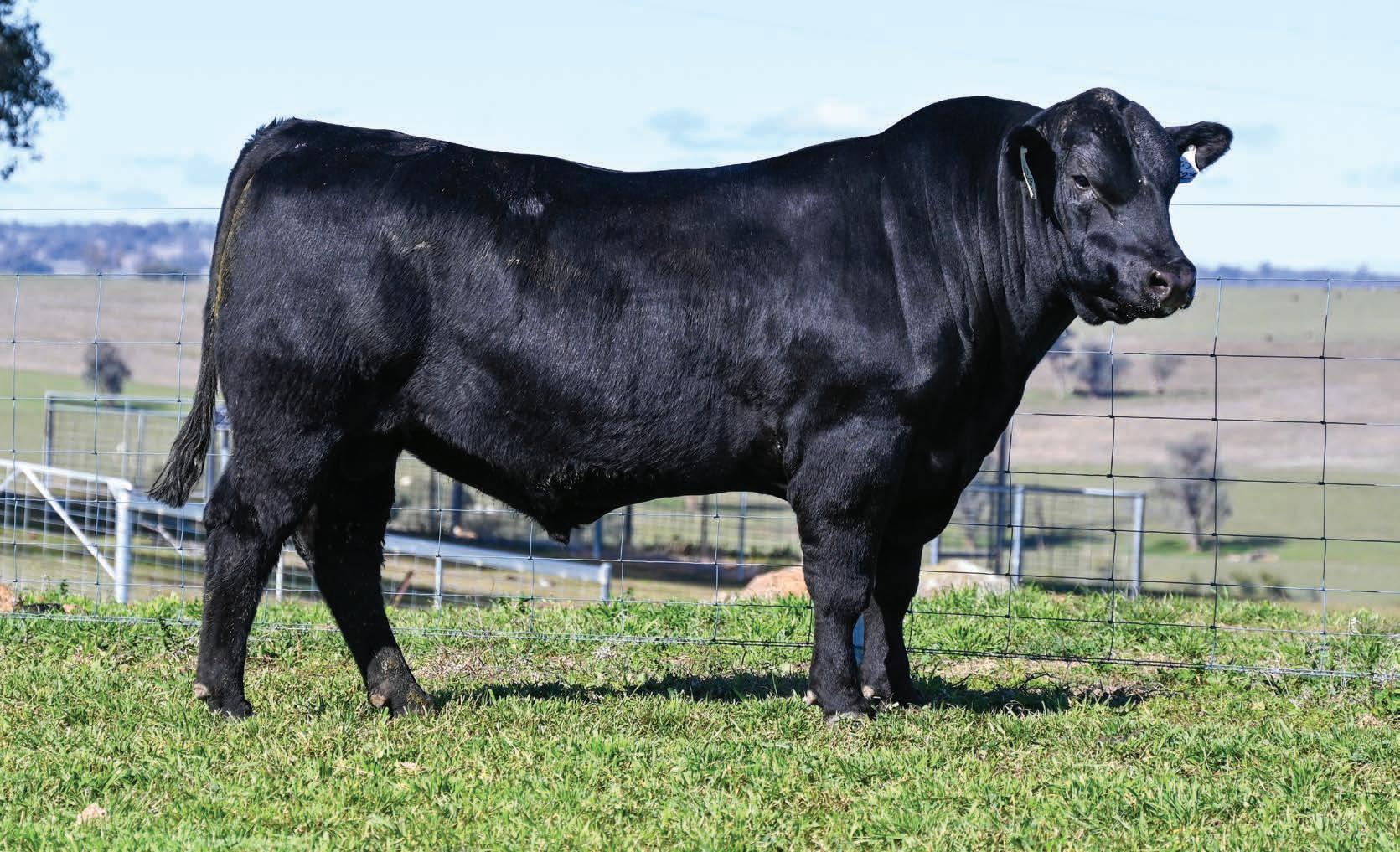
JADA Texas T523PV
DIC22T523 | DOB: 17/9/2022 |

Texas T523 is one of four Angus bulls in the catalogue that Dick Whale scored an illustrious 7 out of 8 for structure/docility. Dicks says “8 graders” are like “rocking horse sh%t!”
Texas T523 sits in the top 6% of the breed for Calving Ease Direct, suggesting increased calving ease. He is in the top 15% of the breed for birthweight, and top 31% for Days to Calving. If you’re seeking a low birthweight bull without compromising on yield, Texas T523 is a great option.

JADA Texas T523 (DIC22T523)
Sire: Wattletop Q41.
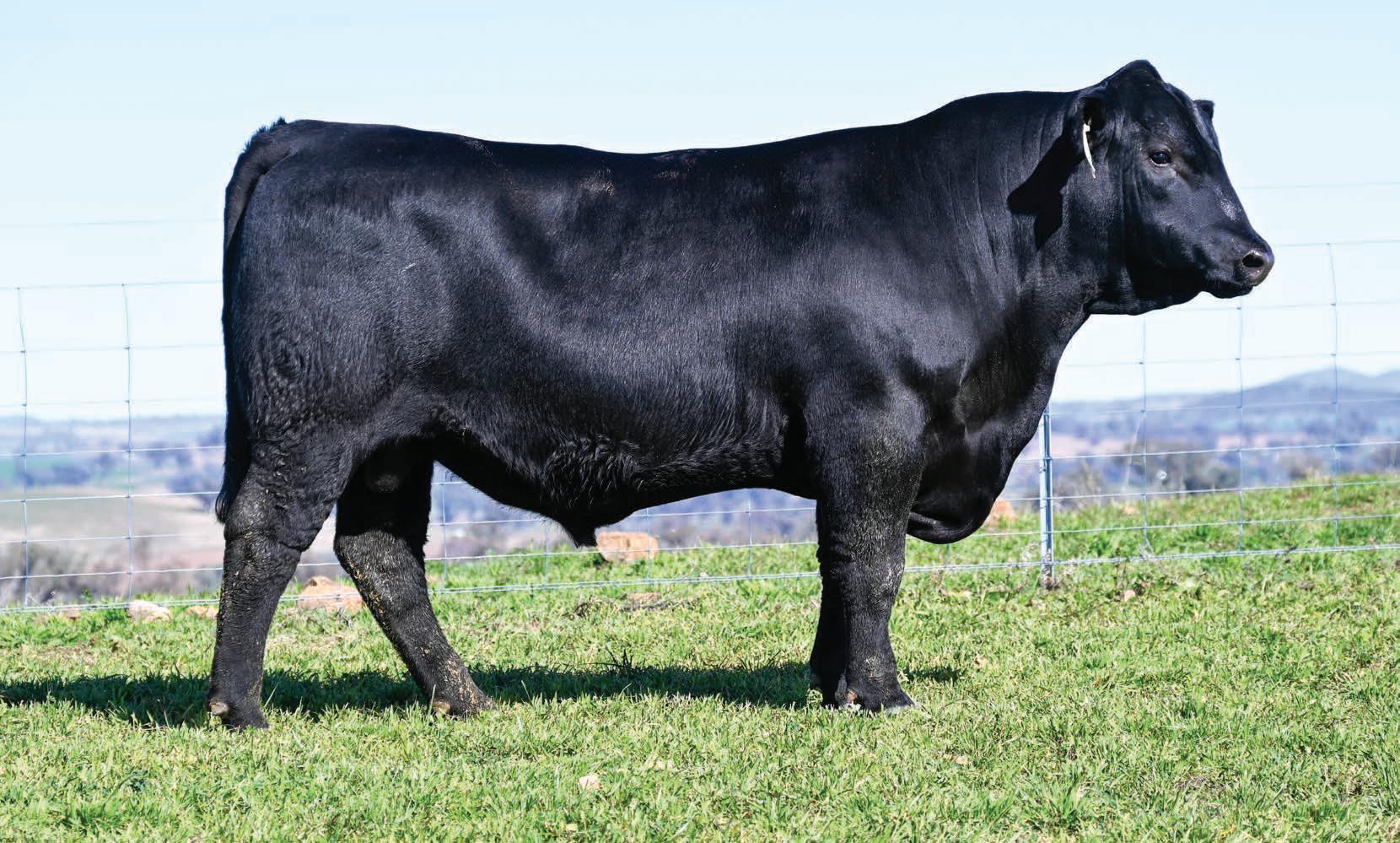
JADA Tennessee T524 PV
DIC22T524 | DOB: 18/9/2022 |

Tennessee T524 is in the top 1% of the Angus breed for feed efficiency. We are in the process of constructing a Vytelle feed efficiency testing system on our property and look forward to further measuring this important profit-driving trait going forward.
Tennessee T524 features excellent early growth, being in the top 15% of the breed for 200-day weight. He is another well-structured and very quiet bull from the H45/Wattletop Q41 ET mating.

JADA Tennessee T524 (DIC22T524) Wattletop
Sire: Wattletop Q41.
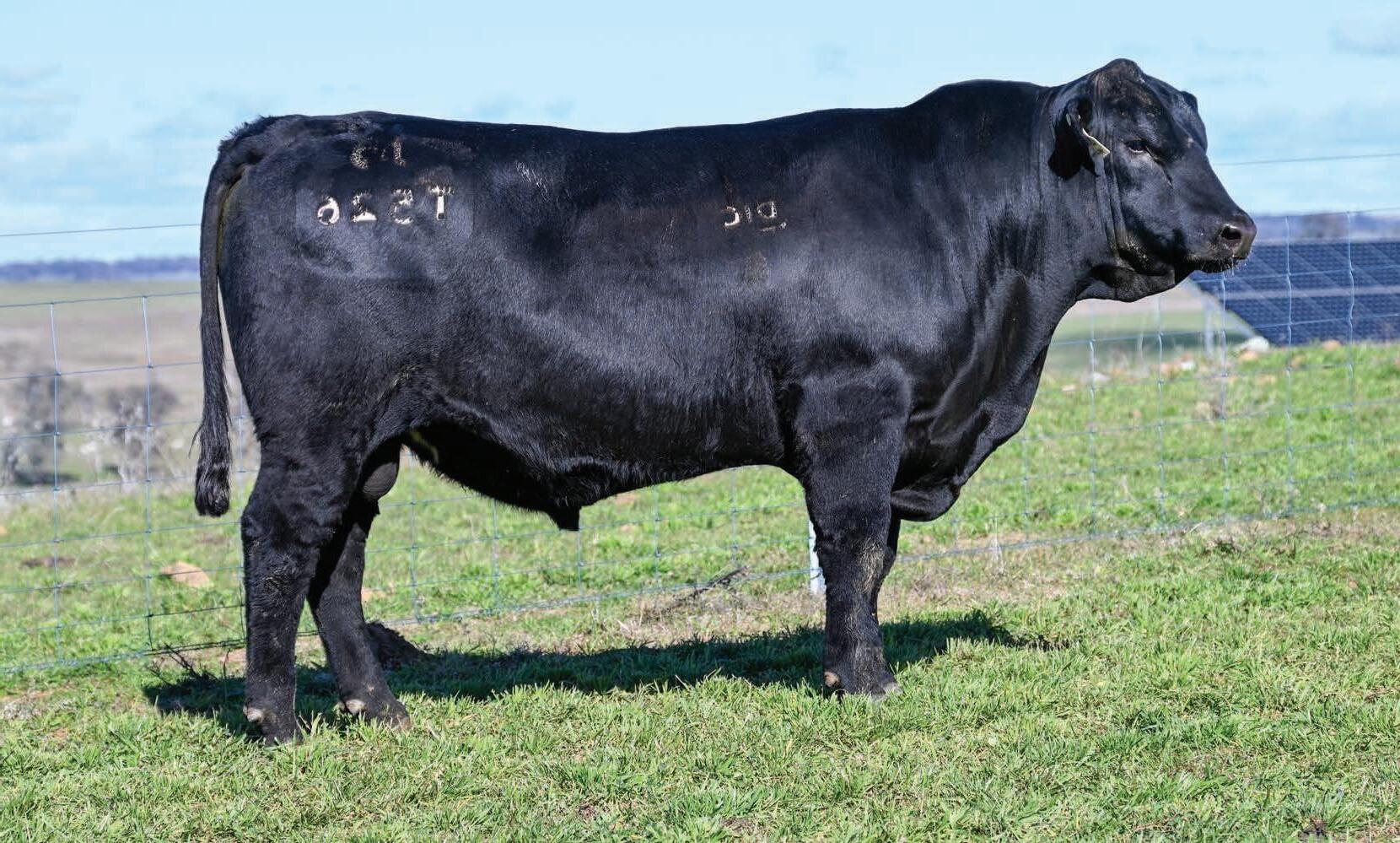
JADA Think Big T526 PV
ID: DIC22T526 | DOB: 23/9/2022 |

Structural
Another well-structured son of Wattletop Q41, who sold for $30,000 to Glenavon Angus.
The “Dream” cow family is popular in Angus seedstock circles, and our Dream H45 cow has been a gem for us. We lost her to injury last year - at the ripe age of 13 years old. She was an exceptional phenotype female with presence, excellent capacity and length. An outstanding udder too! The most important part is how well she bred on. We are grateful to have outstanding daughters coming through.

JADA Think Big T526 (DIC22T526)
Sire: Wattletop Q41.
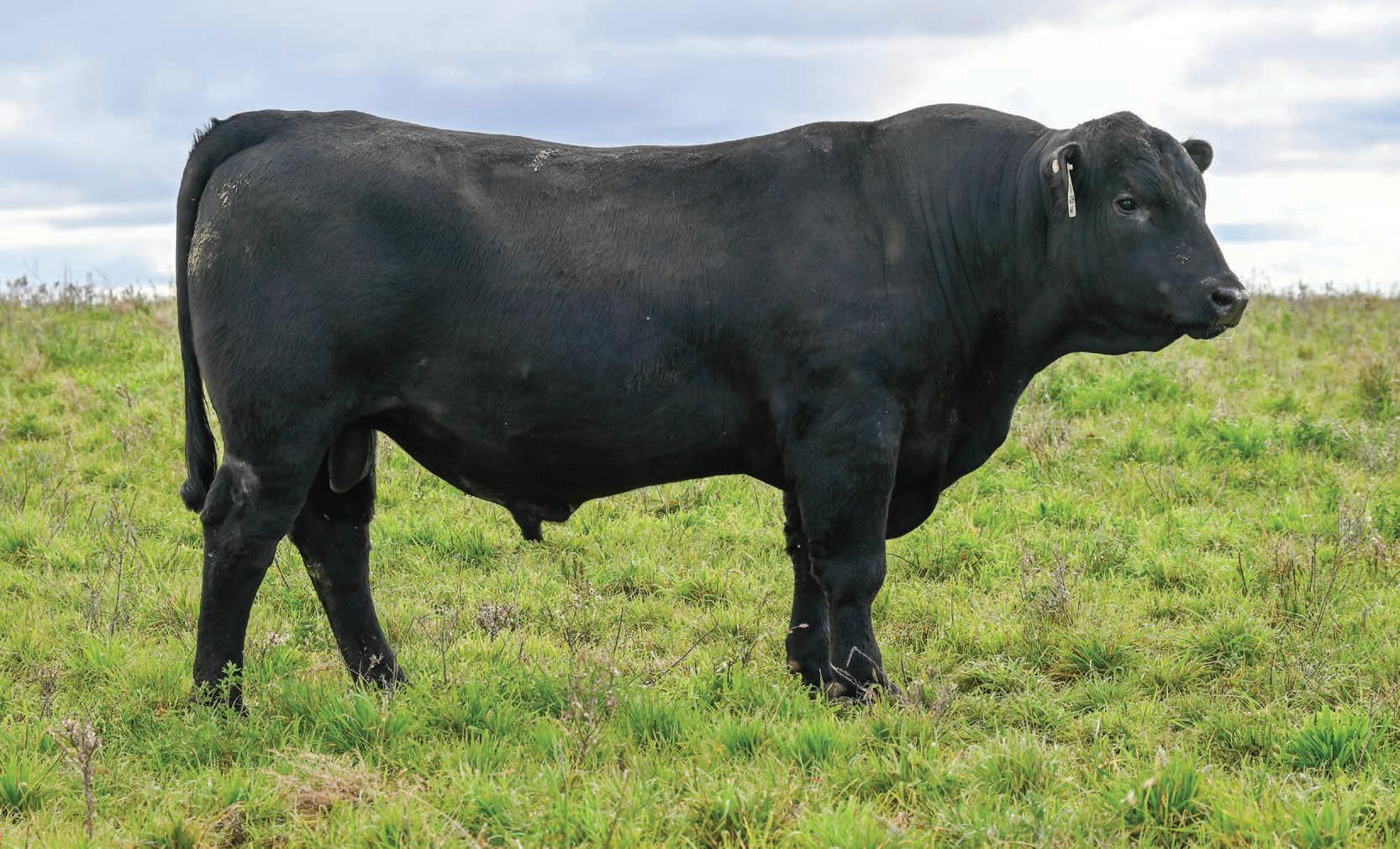
JADA Touchdown T514 PV
ID: DIC22T514 | DOB: 15/9/2022 |

Structural
Touchdown T514 is the third last bull from the successful H45/Wattletop Q41 mating to be offered, a more moderate-framed son.
Touchdown T514 sits in the top 13% of the breed for retail beef yield, top 31% for feed efficiency, and top 34% for gestation length. His paternal grandsire, Lawsons Momentous M518 was the high selling bull for Lawsons Angus in 2018, featuring excellent structure, with calving ease and outstanding carcase.

JADA Touchdown T514 (DIC22T514)
Sire: Wattletop Q41.
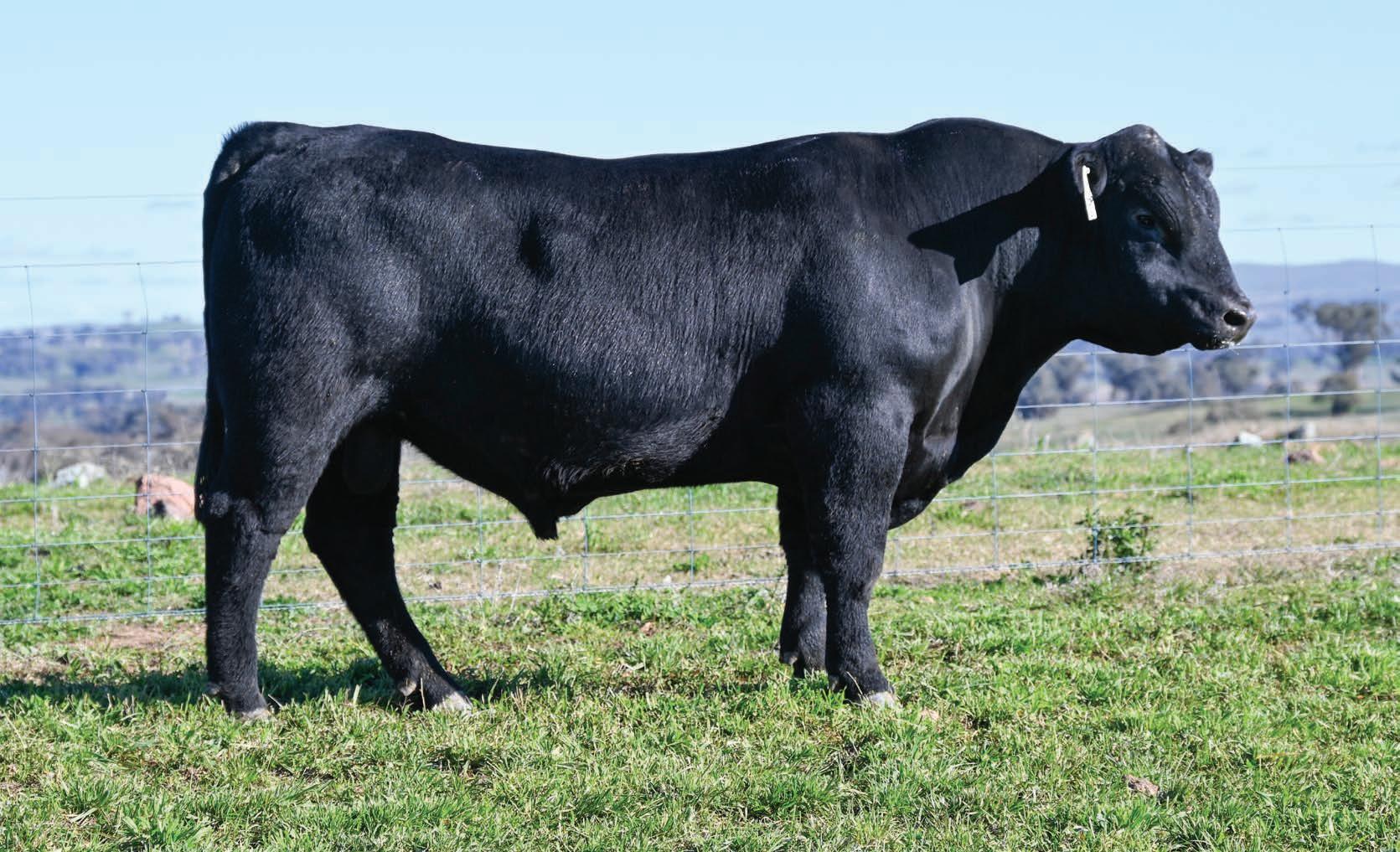
JADA Trademark T511PV
ID: DIC22T511 | DOB: 13/9/2022 |

Trademark T511 is another more moderate-framed bull from the H45/Wattletop Q41 mating, the second last to be offered in the catalogue.
Like all of the Angus bulls in this catalogue, Trademark T511 is fully DNA parent verified to both sire and dam, and has been DNA tested free of all genetic conditions tested in the Angus breed.

JADA Trademark T511 (DIC22T511) Wattletop Q41
Sire: Wattletop Q41.
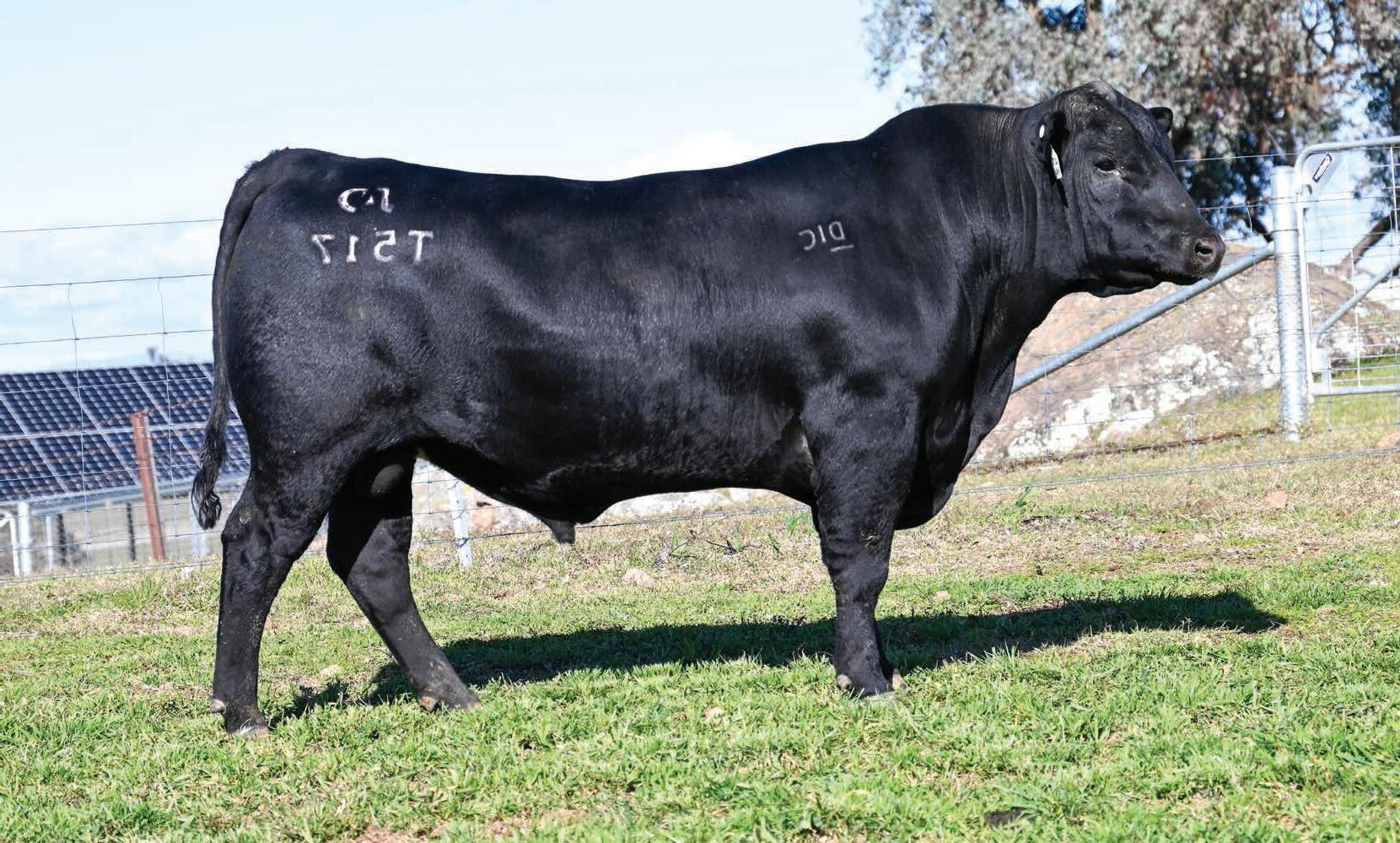
JADA Trailblazer T517PV
ANGUS ID: DIC22T517 | DOB: 16/9/2022 |

Trailblazer T517 is the last of the Wattletop Q41 sons to be offered in the catalogue, out of a cow we rate as our best foundation female.
The “Dream” cow family is popular in Angus seedstock circles, and our Dream H45 cow has been a gem for us. We lost her to injury last year - at the ripe age of 13 years old. She was an exceptional phenotype female with presence, excellent capacity and length. An outstanding udder too! The most important part is how well she bred on. We are grateful to have outstanding daughters coming through.

JADA Trailblazer T517 (DIC22T517)
Wattletop Q41
Sire: Wattletop Q41.
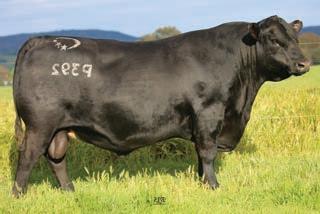
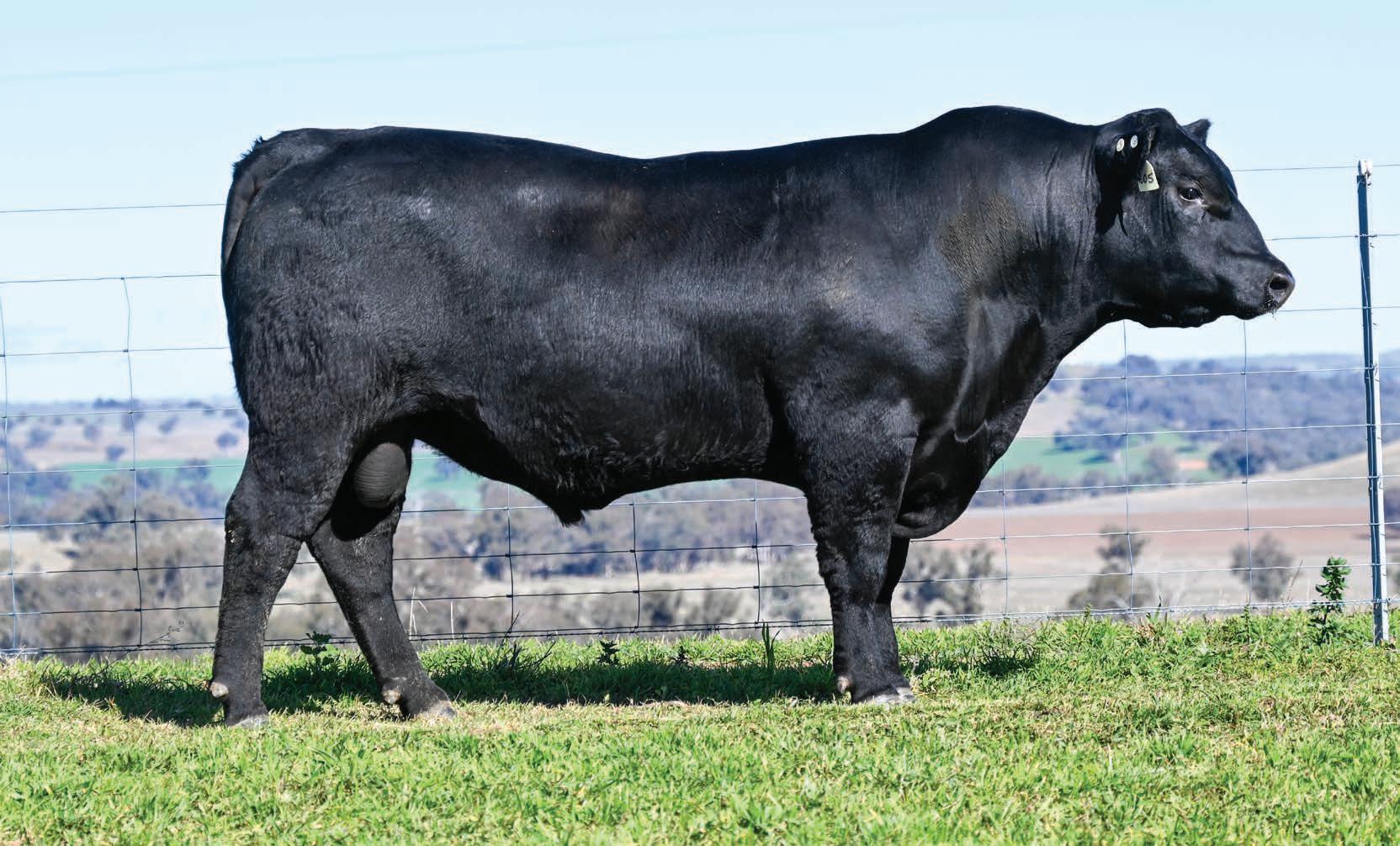
JADA Teflon T505 PV
ID: DIC22T505 | DOB: 7/9/2022 | GENETIC STATUS:

Teflon T505 is the first of two sons of Clunie Range Plantation P392 to be offered in the catalogue, with an ET-bred brother to be offered next as lot 38.
Sire, Clunie Range Plantation P392, has been described as Beast Mode’s “best son”. He was a standout at Clunie Range as a calf, and he is backed by the dominant Naomi maternal line. Teflon T505 is in the top 1% of the breed for Scrotal Size, and top 5% for Gestation Length. He is a maternal brother to the three-year-old sire that kickstarted the Angus offering, as lot 26.
JADA Teflon T505 (DIC22T505)
Clunie Range Plantation P392
Baldridge Beast Mode B074
Sire: Clunie Range Plantation P392.

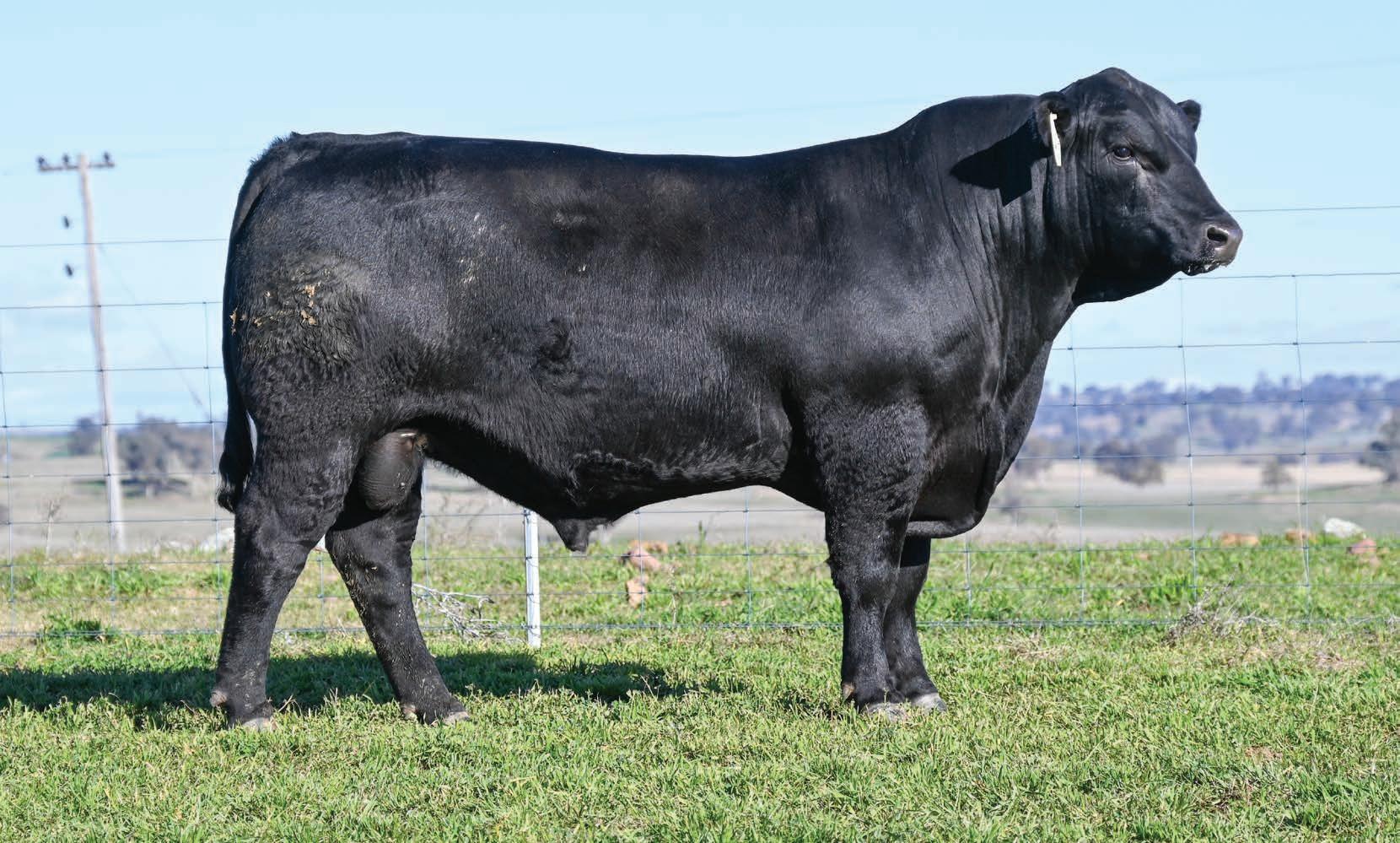
JADA Tobruk T520PV

Structural EBVs
Tobruk T520 is the second of two sons of Clunie Range Plantation P392 to be offered in the catalogue, with an ET-bred brother offered as lot 37. Dick Whale scored Tobruk T520 a 7 out of 8 for structure/docility.
Tobruk T520 is out of one of our favourite foundation cows, purchased at the dispersal of the Geard family’s Premier Angus Stud in September 2020. Lowan P128 is a powerful, smooth-skinned female. Tobruk T520 is a maternal brother to the three-year-old sire that kickstarted the Angus offering, as lot 26.
Sire: Clunie Range
Plantation P392.
JADA Tobruk T520 (DIC22T520)
Clunie Range Plantation P392
Lowan P128
Baldridge Beast Mode B074
Range Naomi M516
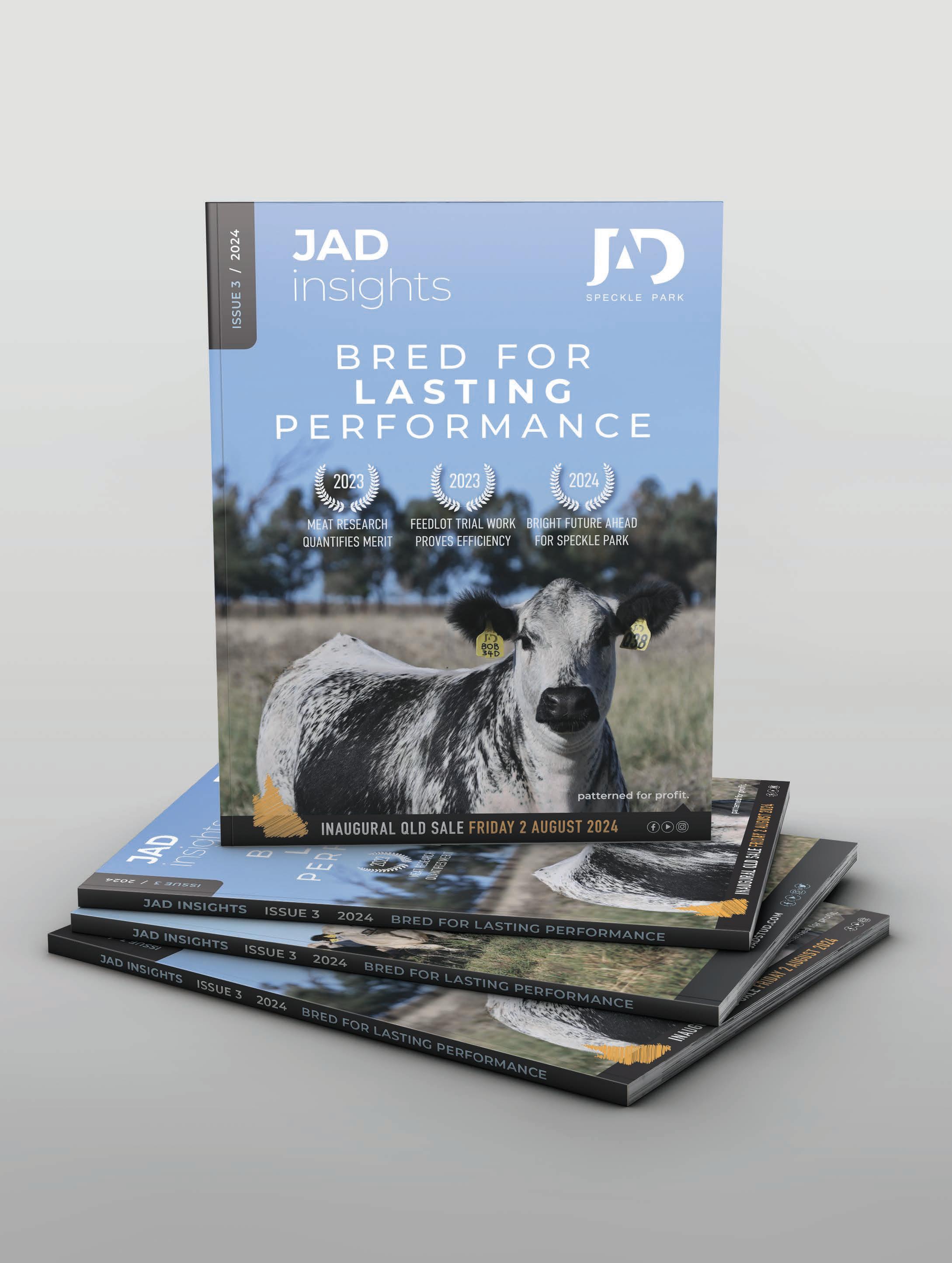
CASE STUDIES FROM COMMERCIAL PRODUCERS USING SPECKLE PARK
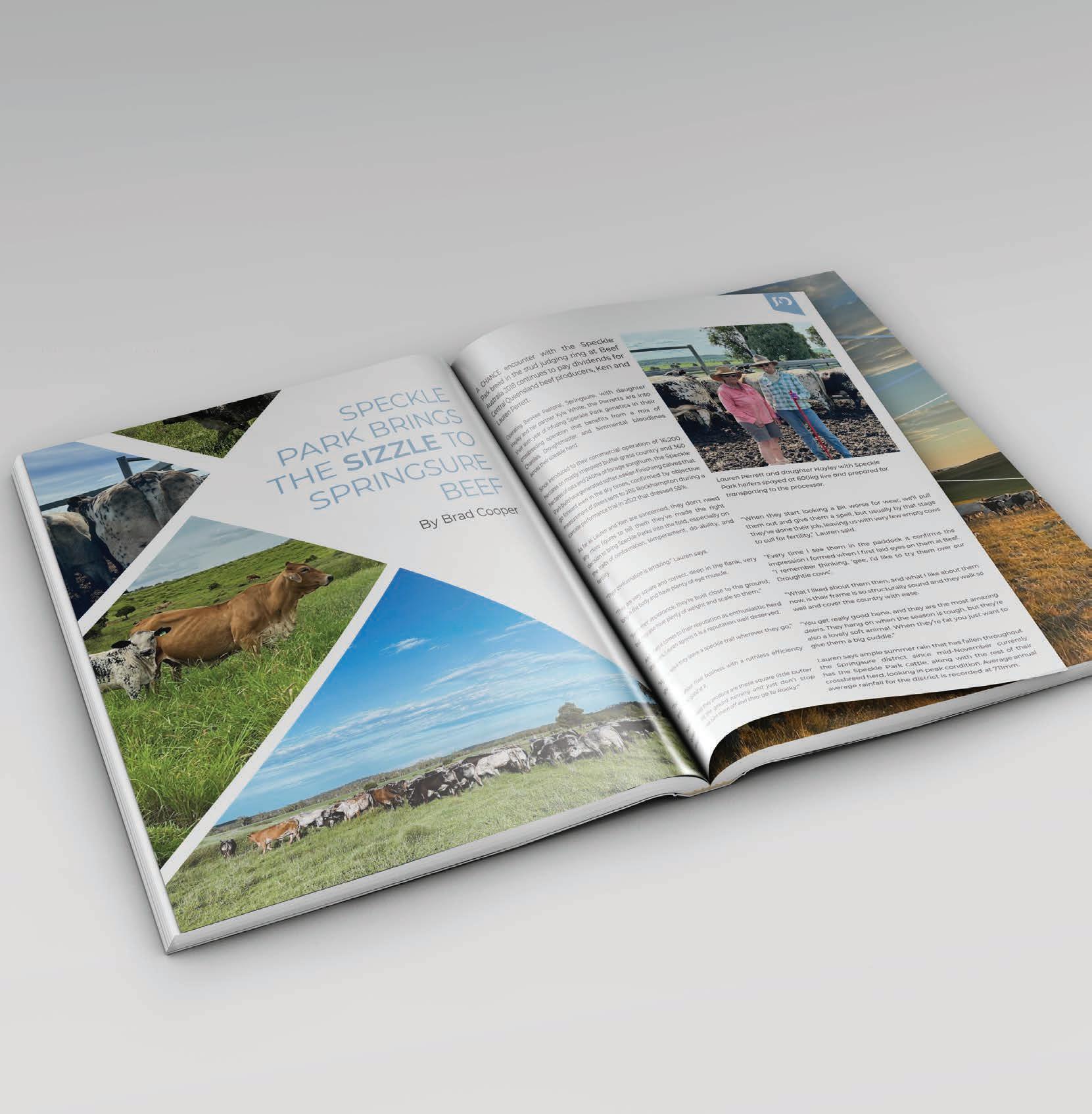
EASY CALVING
“Calving has been a breeze over the past three years, using Speckle Park bulls”
– Wendy James, Lucindale, SA
HIGH YIELDS
“They are a compact, powerfully built animal but still have softness… they are built low to the ground but it’s all red meat”
– John Kater, Warren NSW
FAST TO FINISH
“The Speckle Parkcross calves are these square little butter boxes that hit the ground running, and just don’t stop thriving until we turn them off and they go to Rocky”
– Lauren Perrett, Springsure, QLD
